Forums
- Forums
- Axis And Allies Forum
- General Discussion
- Aviation News
Aviation News
Post a reply
- Go to Previous topic
- Go to Next topic
- Go to Welcome
- Go to Introduce Yourself
- Go to General Discussion
- Go to Screenshots, Images and Videos
- Go to Off topic
- Go to Works in Progress
- Go to Skinning Tips / Tutorials
- Go to Skin Requests
- Go to IJAAF Library
- Go to Luftwaffe Library
- Go to RAF Library
- Go to USAAF / USN Library
- Go to Misc Library
- Go to The Ops Room
- Go to Made in Germany
- Go to Campaigns and Missions
- Go to Works in Progress
- Go to Juri's Air-Raid Shelter
- Go to Campaigns and Missions
- Go to Works in Progress
- Go to Skinpacks
- Go to External Projects Discussion
- Go to Books & Resources
-
10 years agoFri Sep 25 2015, 03:17pm
 Main AdminATLANTIC OCEAN (Sept. 19, 2015) A T-45C Goshawk training aircraft attached to Training Air Wing (CTW) 1 prepares to land on the flight deck of the aircraft carrier USS Dwight D. Eisenhower (CVN 69). Dwight D. Eisenhower is underway conducting carrier qualifications. (U.S. Navy photo by Mass Communication Specialist 3rd Class Jameson E. Lynch/Released)
Main AdminATLANTIC OCEAN (Sept. 19, 2015) A T-45C Goshawk training aircraft attached to Training Air Wing (CTW) 1 prepares to land on the flight deck of the aircraft carrier USS Dwight D. Eisenhower (CVN 69). Dwight D. Eisenhower is underway conducting carrier qualifications. (U.S. Navy photo by Mass Communication Specialist 3rd Class Jameson E. Lynch/Released)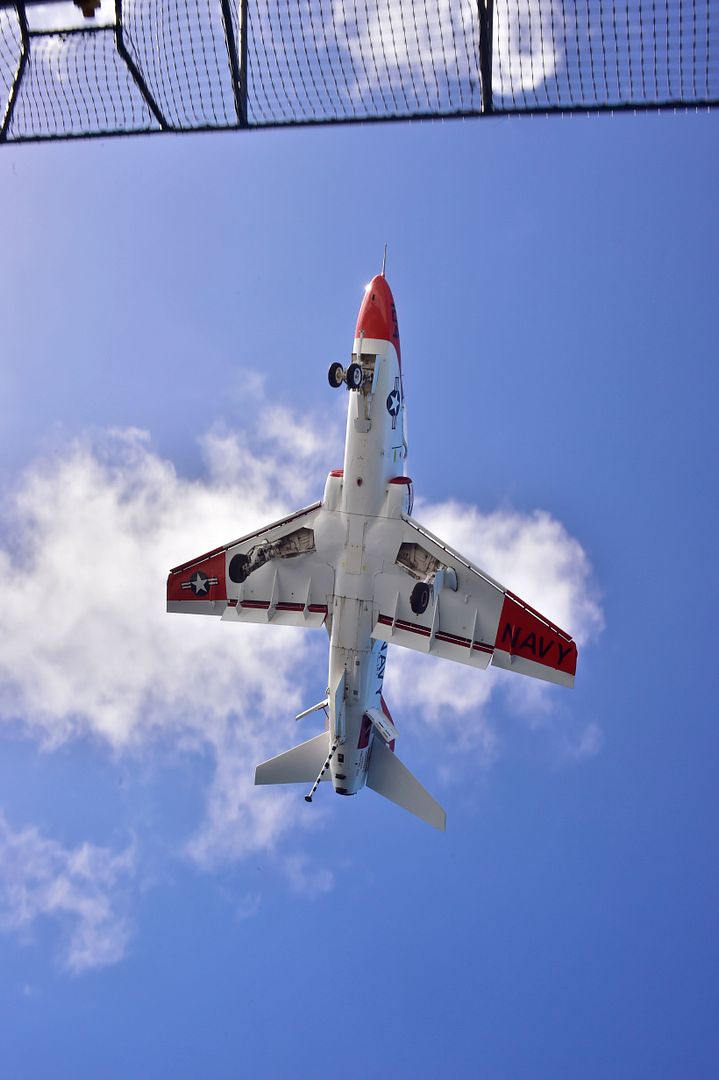
25 September 2015 Press Release
Less than one year after delivering the first A350 XWB (-900), the first A350-1000 is taking shape with the assembly start of the first fuselage major components at Airbus plants in Hamburg and Saint-Nazaire.
The forward fuselage section has been delivered by Premium Aerotec to Airbus in Hamburg where it will be equipped before being flown to Saint-Nazaire on board the Beluga. The nose fuselage section has been delivered by Stelia Aerospace to Airbus in Saint-Nazaire for assembly and equipping. The forward and nose fuselage sections will then be joined together in Saint-Nazaire to form the front fuselage which will then be flown by Beluga to the A350 XWB Final Assembly Line in Toulouse.
Assembly of the first A350-1000 wings got underway in August this year at Airbus in Broughton and final assembly of the aircraft will begin in Toulouse early 2016, followed by the first flight second half 2016. First deliveries are scheduled to start mid-2017.
Measuring nearly 74 meters from nose to tail, the A350-1000 is the longest-fuselage version of Airbus? all-new family of widebody jetliners. The A350-1000 comfortably seats 366 passengers in a typical 3-class configuration and flies on routes up to 8,000 nautical miles.
Maximising commonality with the A350-900, the A350-1000 offers best-in-class cabin efficiency and comfort, with new cabin crew rest compartment improvements, new In Flight Entertainment (IFE), optimised lavatory shapes and new galley arrangements. It will be powered by Trent XWB-97 engines for maximised thrust.
Orders for the A350-1000 stand at 169 firm orders from 9 customers. Total orders for the A350 XWB programme stand at 782 orders from 40 customers.
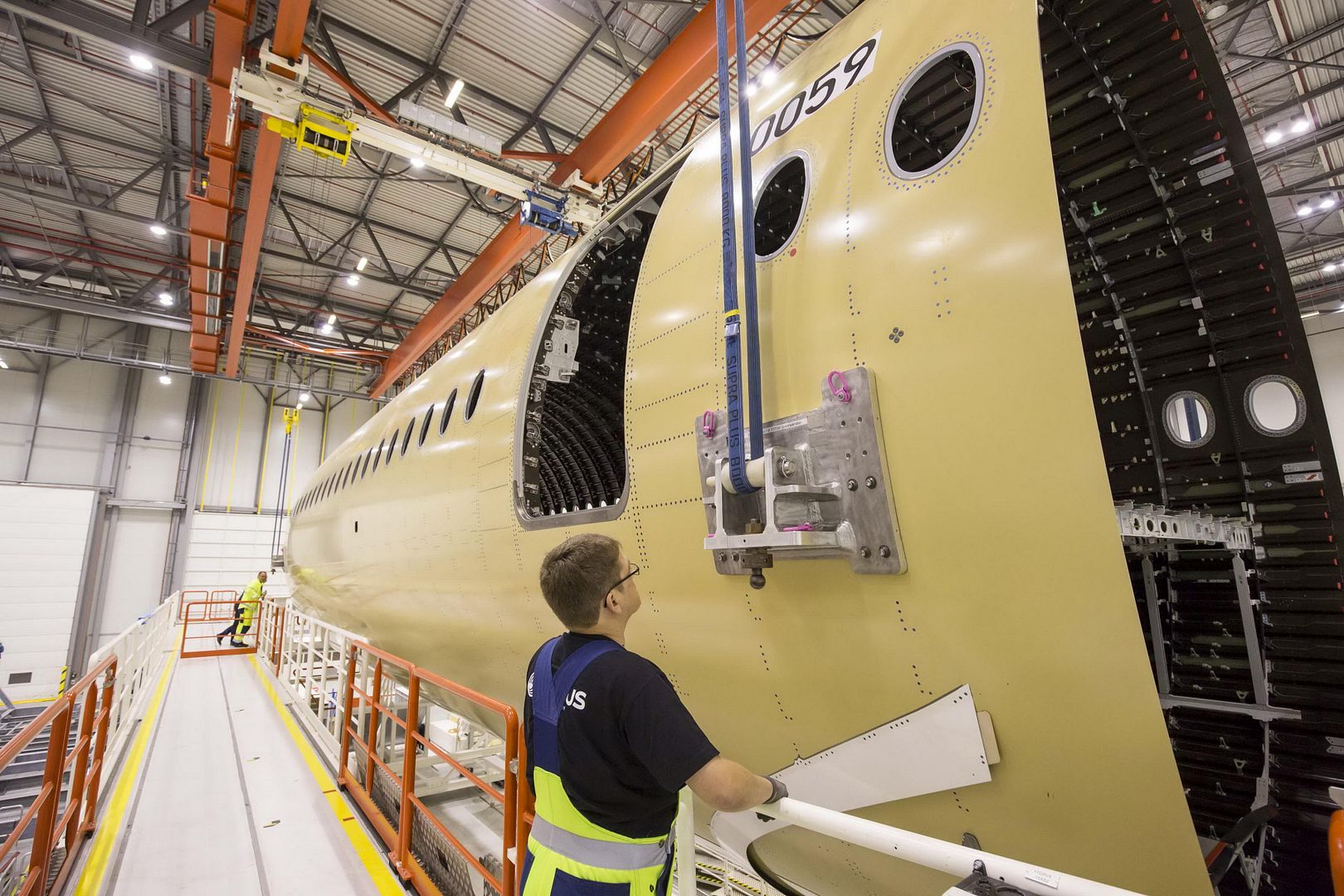
ATLANTIC OCEAN (Sept. 21, 2015) An F/A-18F Super Hornet assigned to the Jolly Rogers of Strike Fighter Squadron (VFA) 103 prepares to launch from the flight deck of the aircraft carrier USS Harry S. Truman (CVN 75). The Harry S. Truman Carrier Strike Group is underway participating in a composite training exercise in preparation for a future deployment. (U.S. Navy photo by Mass Communication Specialist 2nd Class E. M. M. Blair/Released)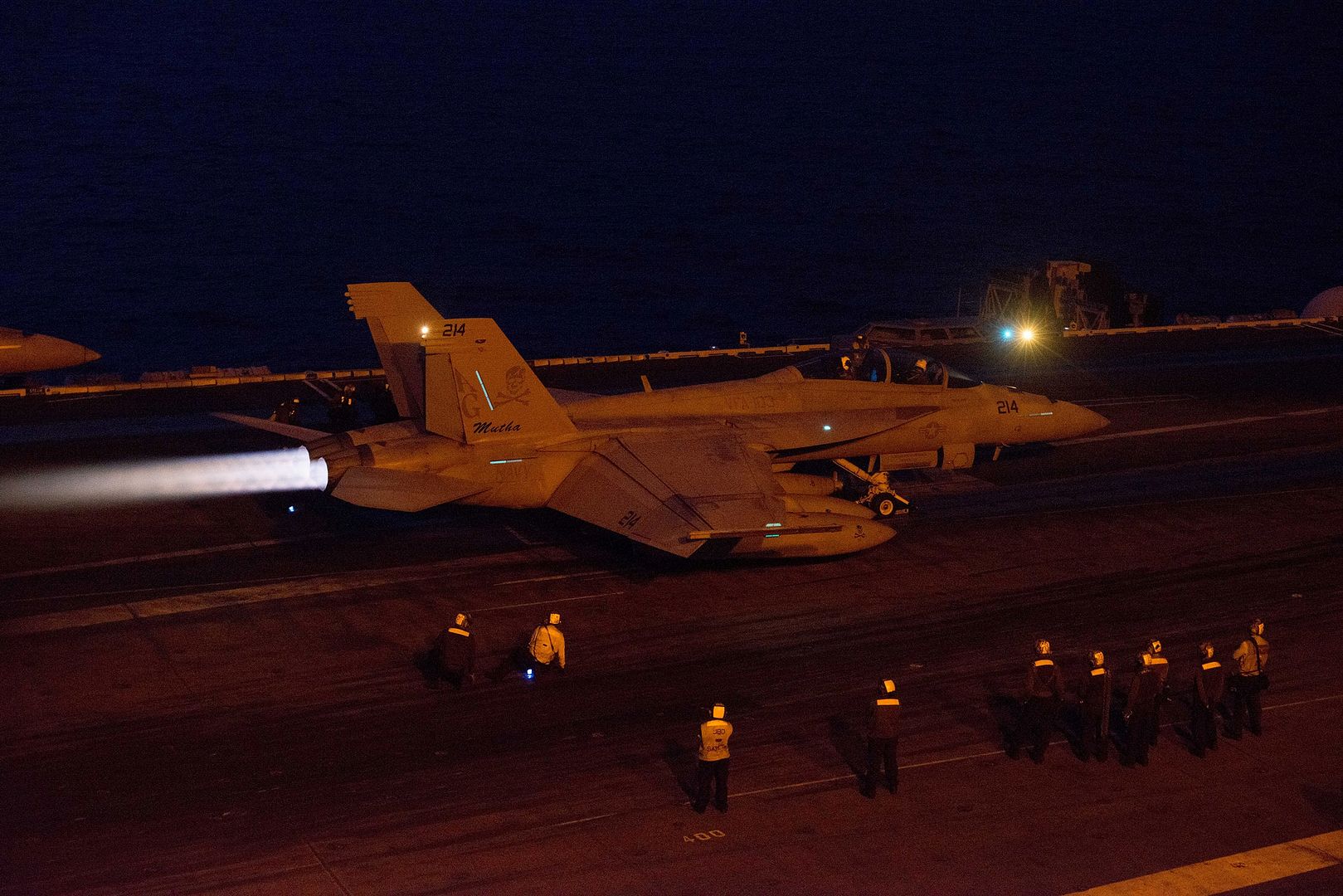
-
10 years agoMon Sep 28 2015, 07:43pm
 Main AdminEVERETT, Wash., Sept. 25, 2015 ? The Boeing [NYSE: BA] and U.S. Air Force team successfully completed the first flight of a KC-46A tanker aircraft today, taking off from Paine Field at 1:24 p.m. (PST) and landing four hours later at Boeing Field in Seattle.
Main AdminEVERETT, Wash., Sept. 25, 2015 ? The Boeing [NYSE: BA] and U.S. Air Force team successfully completed the first flight of a KC-46A tanker aircraft today, taking off from Paine Field at 1:24 p.m. (PST) and landing four hours later at Boeing Field in Seattle.
This was the first flight of a KC-46A tanker-configured aircraft, following ongoing flights of the program?s first test aircraft, a 767-2C. During the flight, Boeing test pilots performed operational checks on engines, flight controls and environmental systems and took the tanker to a maximum altitude of 35,000 feet prior to landing.
?This first tanker flight is a key milestone for the program and we?ll now begin free air stability tests and flight controls of the boom and wing aerial refueling pods (WARPs) before conducting aerial refueling tests where the KC-46 will make contact with other military aircraft down the road,? said Col. Christopher Coombs, U.S. Air Force KC-46 System program manager.
?Today?s flight reinforces that we are moving in the right direction and are on track to begin planned Milestone C testing later this year,? said Tim Peters, Boeing KC-46 tanker vice president and program manager. ?This is an aerospace industry first and the culmination of a lot of hard work by the team, including Boeing, our suppliers and the U.S. Air Force.?
The Boeing team now will conduct a post-flight inspection and calibrate instrumentation prior to the next series of flights, during which the tanker boom and WARPs systems will be deployed. Before the end of the year, the KC-46 will begin conducting aerial refueling flights with a number of U.S. Air Force aircraft. Those flights, along with the mission systems demonstrations and a recently completed ground cargo handling test, will support the planned Milestone C decision in 2016.
As part of a contract awarded in 2011 to design and develop the U.S. Air Force?s next-generation tanker aircraft, Boeing is building four test aircraft ? two are currently configured as 767-2Cs and two KC-46A tankers. The KC-46s will fly as fully equipped tankers through the FAA and military certification process, while the 767-2Cs enter flight test prior to receiving their upgrade to the KC-46A configuration and the addition of their aerial refueling systems.
The program?s first test aircraft (EMD-1), a 767-2C, has completed more than 150 flight test hours to date since making its first flight in December 2014.
The KC-46A is a multirole tanker Boeing is building for the U.S. Air Force that can refuel all allied and coalition military aircraft compatible with international aerial refueling procedures and can carry passengers, cargo and patients. Overall, Boeing plans to build 179 KC-46 aircraft for the U.S. Air Force.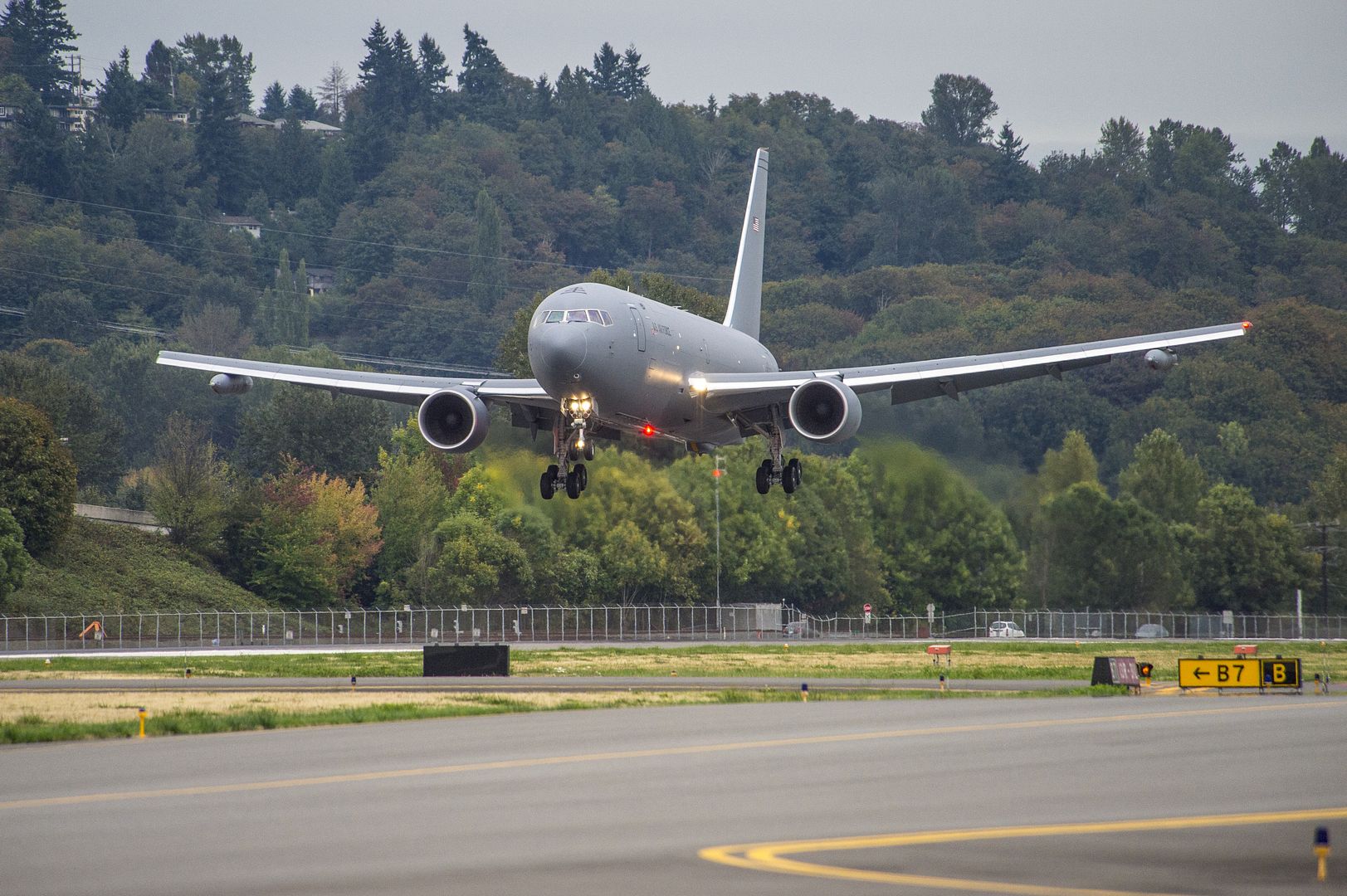
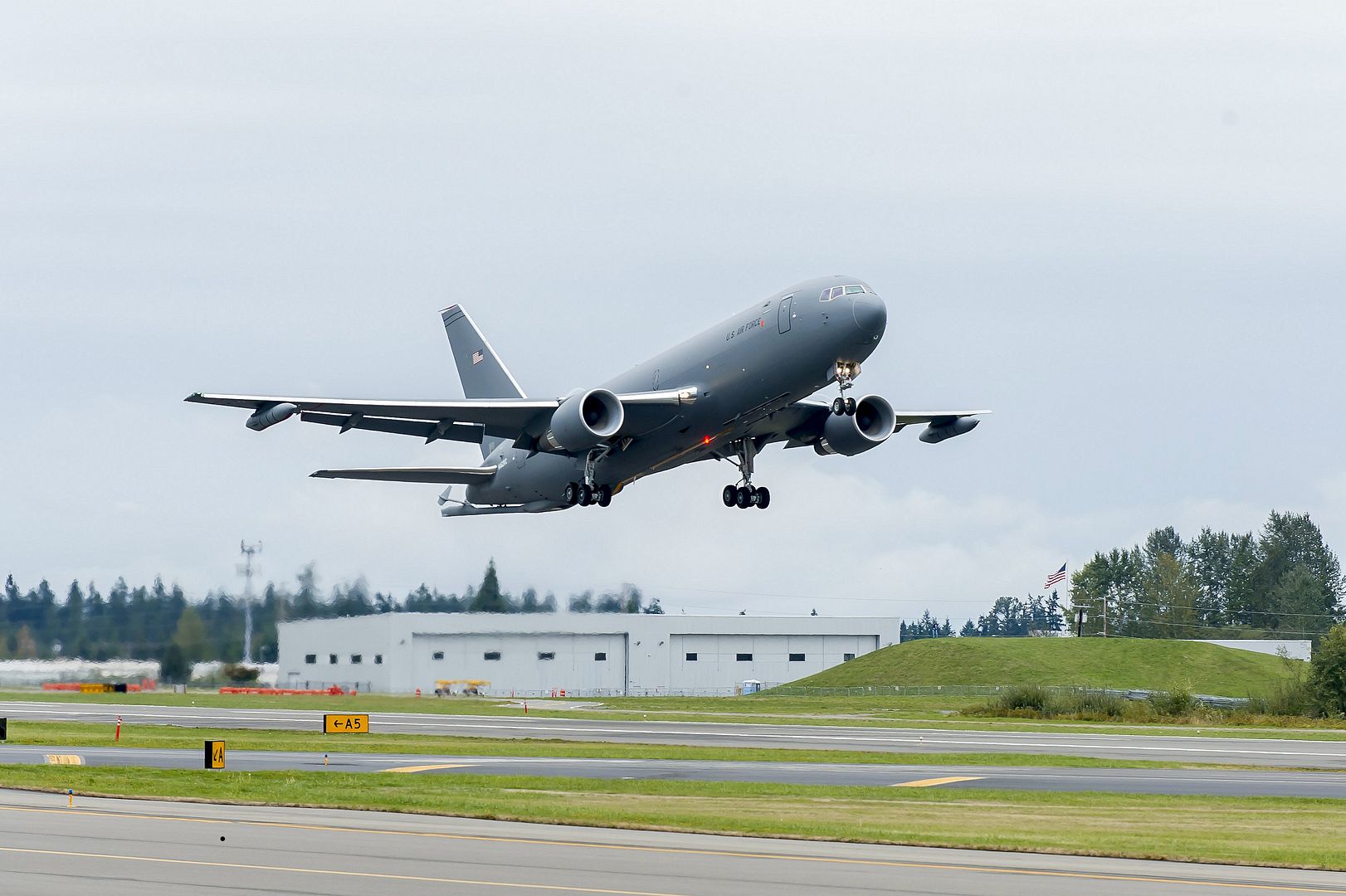
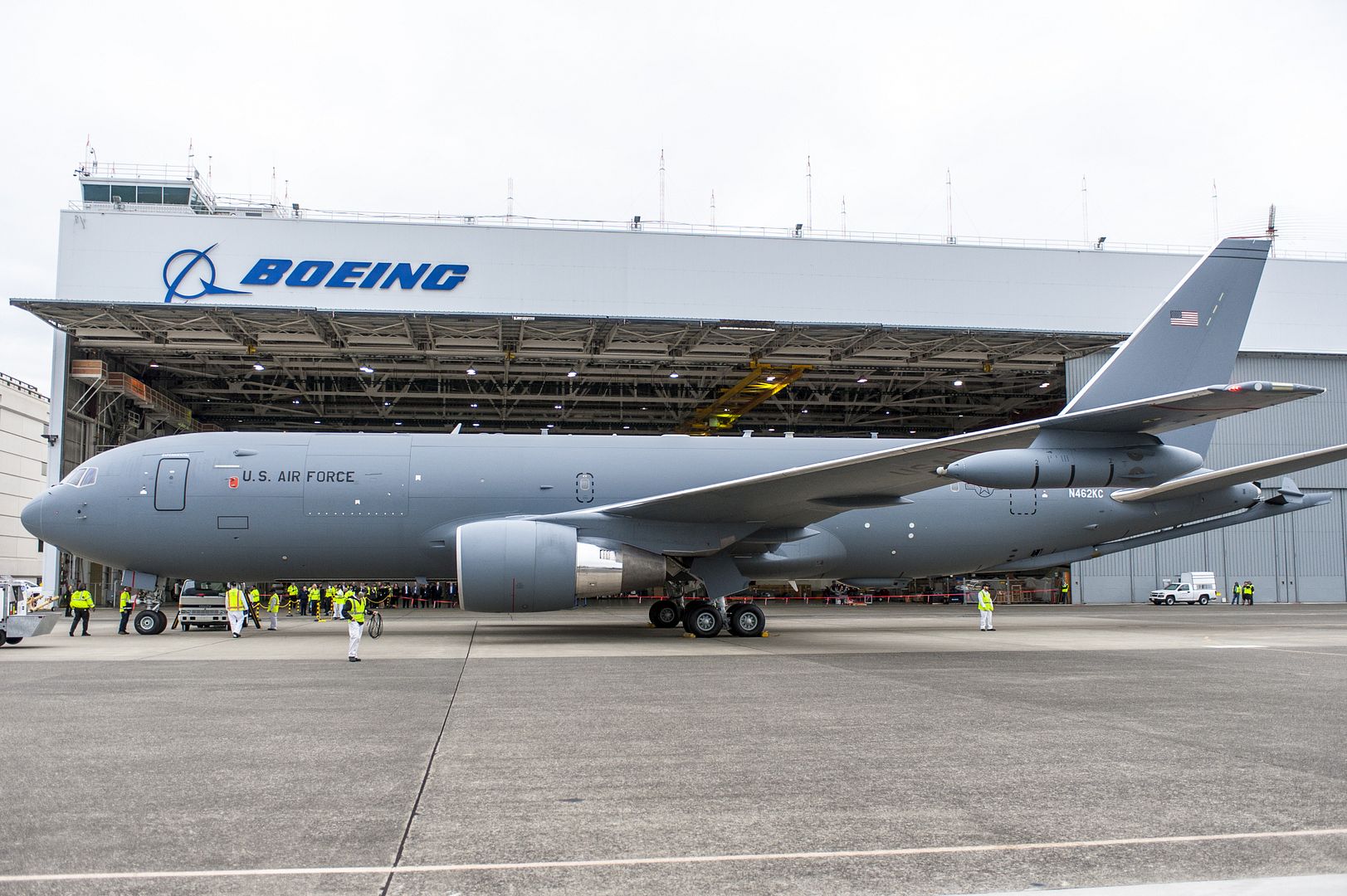
28 September 2015
When you first approach the aircraft, you would be forgiven for mistaking it for a regular airliner, about to whisk you off to an exotic holiday destination.
The RAF jet is, after all, an Airbus A330-200, with 291 seats, a number of galleys and an in-flight entertainment system.
Moving people from one airfield to another, however, is only part of Voyager?s role and it is not until you see the flight deck or speak with the crews that you begin to understand its true capability and purpose.
Owned and maintained by AirTanker and operated by 10 and 101 Squadrons from RAF Brize Norton, Voyager is currently deployed to 903 Expeditionary Air Wing (903 EAW) at RAF Akrotiri in Cyprus. Its role: to dispense fuel to British and Coalition jets conducting strikes against ISIL on a daily basis in the skies above Iraq.
Photographs: Flt Lt Lolley.


ATLANTIC OCEAN (Sept. 27, 2015) - A C-2A Greyhound assigned to the Greyhawks of Airborne Early Warning Squadron (VAW) 120 prepares to land on the flight deck of the aircraft carrier USS Dwight D. Eisenhower (CVN 69). Dwight D. Eisenhower is underway completing carrier qualifications. (U.S. Navy photo by Mass Communication Specialist Seaman Anderson W. Branch/Released)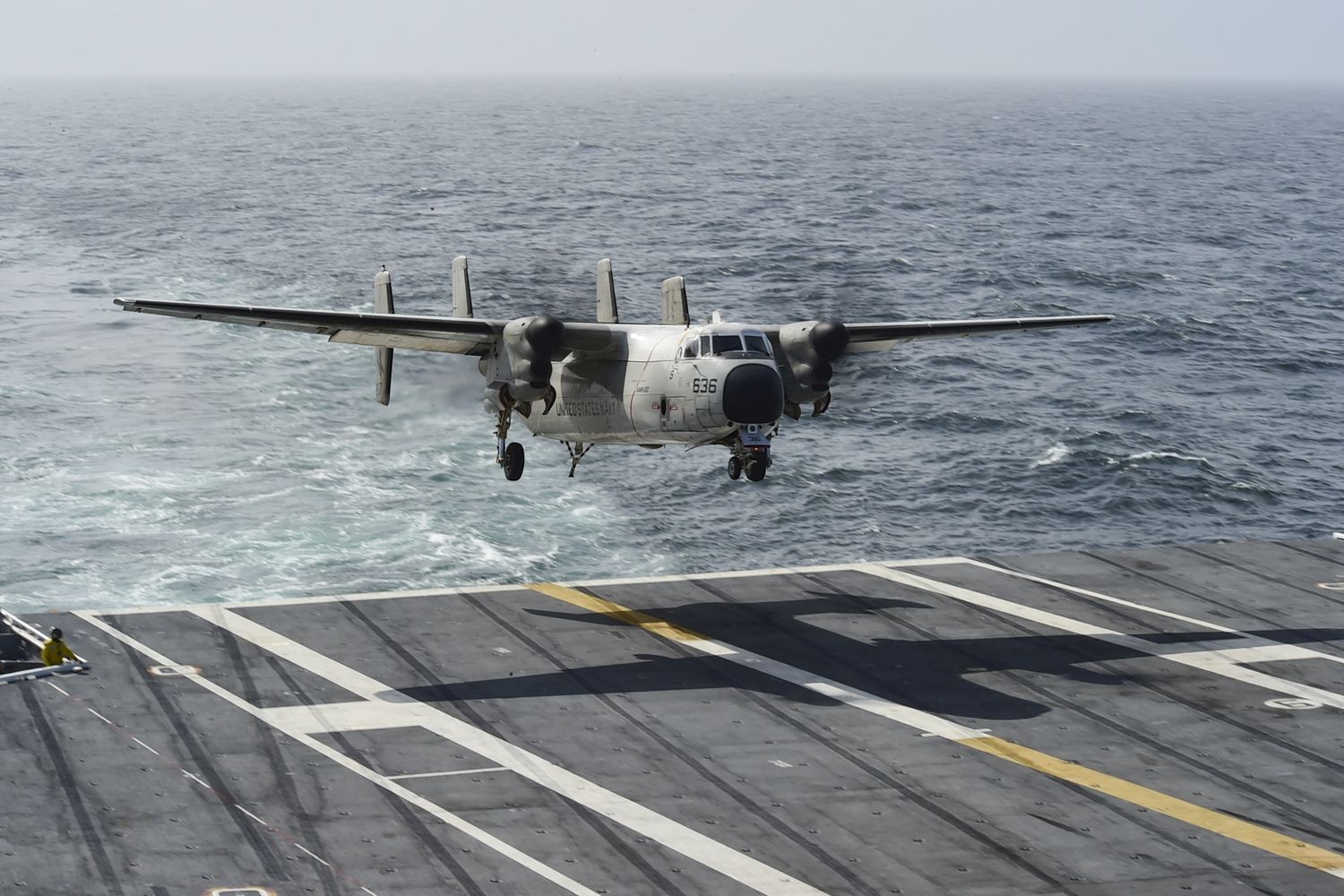
ATLANTIC OCEAN (Sept. 27, 2015) - An E-2C Hawkeye assigned to the Greyhawks of Airborne Early Warning Squadron (VAW) 120 launches from the flight deck of the aircraft carrier USS Dwight D. Eisenhower (CVN 69). Dwight D. Eisenhower is underway completing carrier qualifications. (U.S. Navy photo by Mass Communication Specialist Seaman Anderson W. Branch/Released)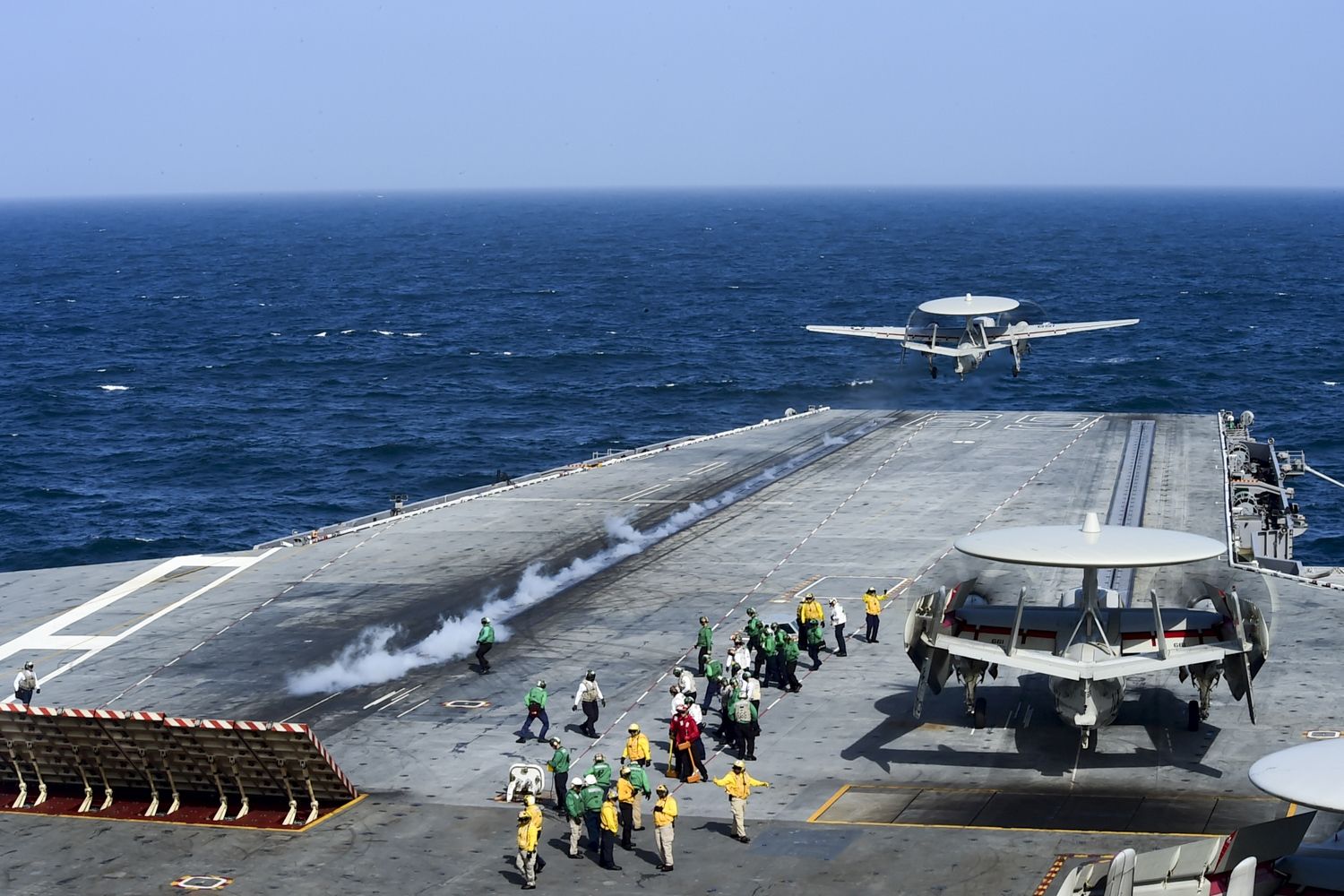
ATLANTIC OCEAN (Sept. 27, 2015) - An E-2C Hawkeye assigned to the Greyhawks of Airborne Early Warning Squadron (VAW) 120 prepares to land on the flight deck of the aircraft carrier USS Dwight D. Eisenhower (CVN 69). Dwight D. Eisenhower is underway completing carrier qualifications. (U.S. Navy photo by Mass Communication Specialist Seaman Anderson W. Branch/Released)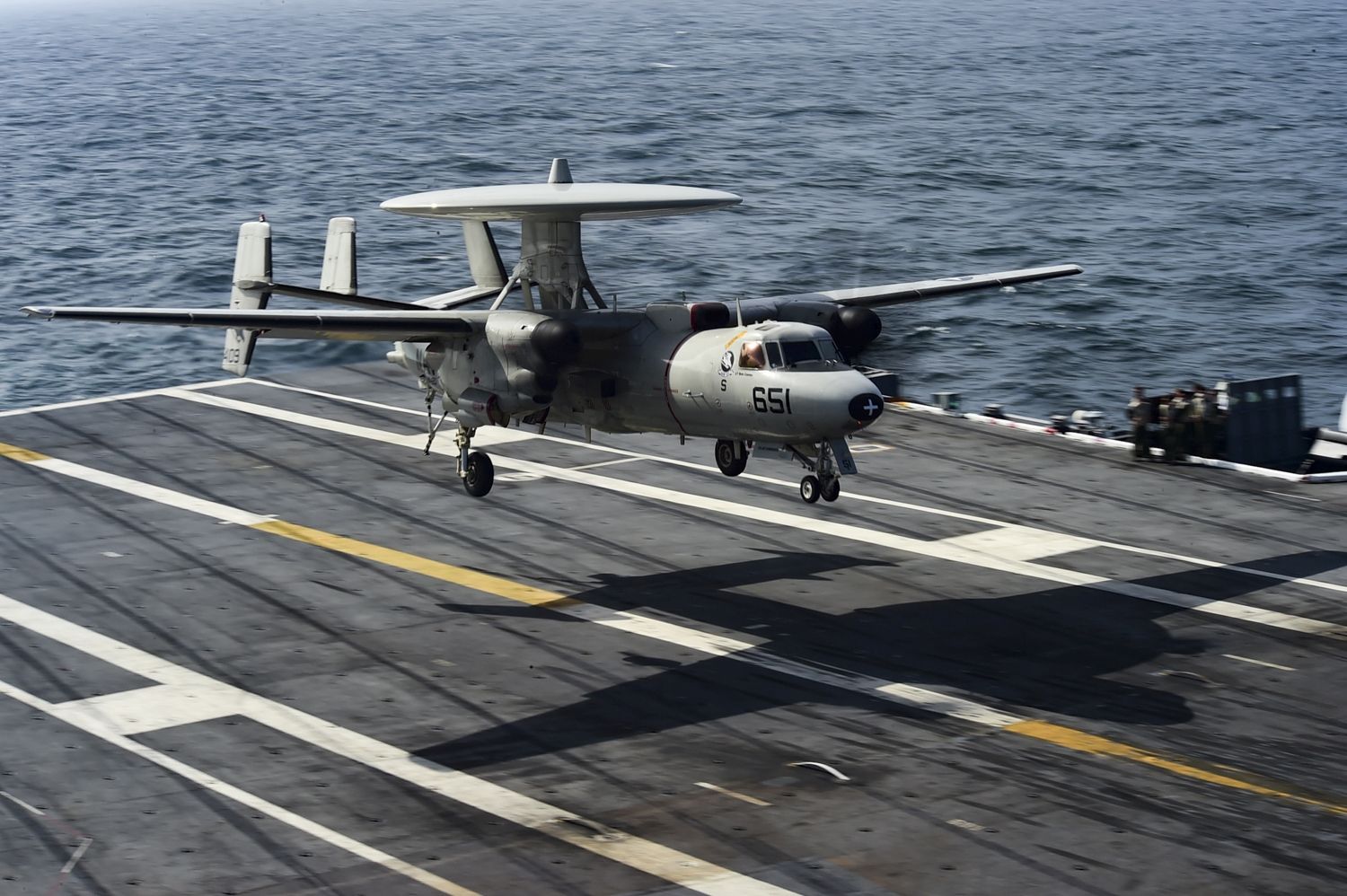
150926-N-HP195-002 NAVAL BASE VENTURA COUNTY, Calif. (Sept. 26, 2014) The Blue Angels' six F/A-18 Hornets were lined up on the flight line before they took to the skies at the 2015 Point Mugu Air Show on Naval Base Ventura County. (U.S. Navy photo by Mass Communication Specialist 1st Class Christopher Okula/Released)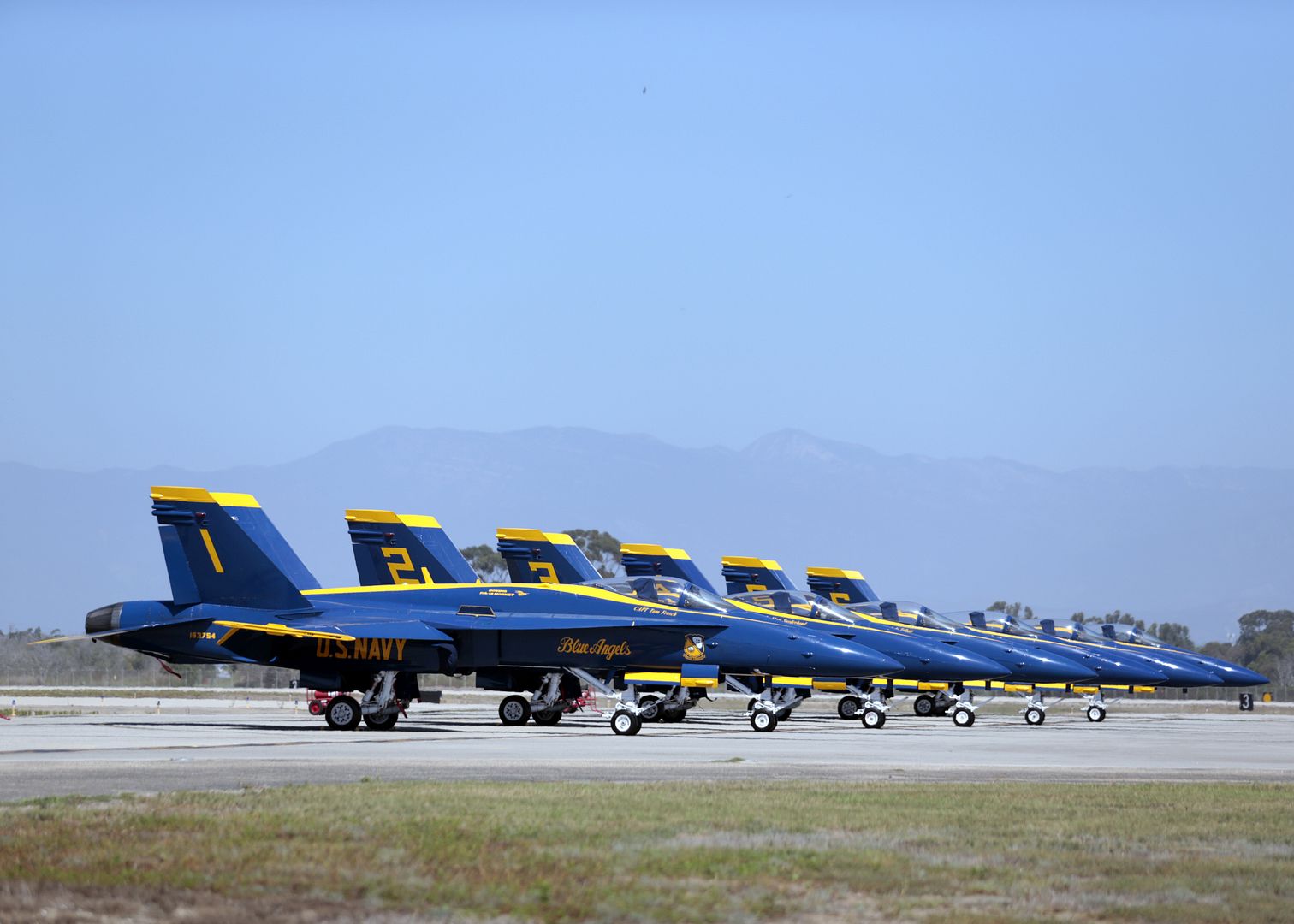
Sept 23 Ilyushin press release.
IL-38 "MAY" taking off from an undisclosed location.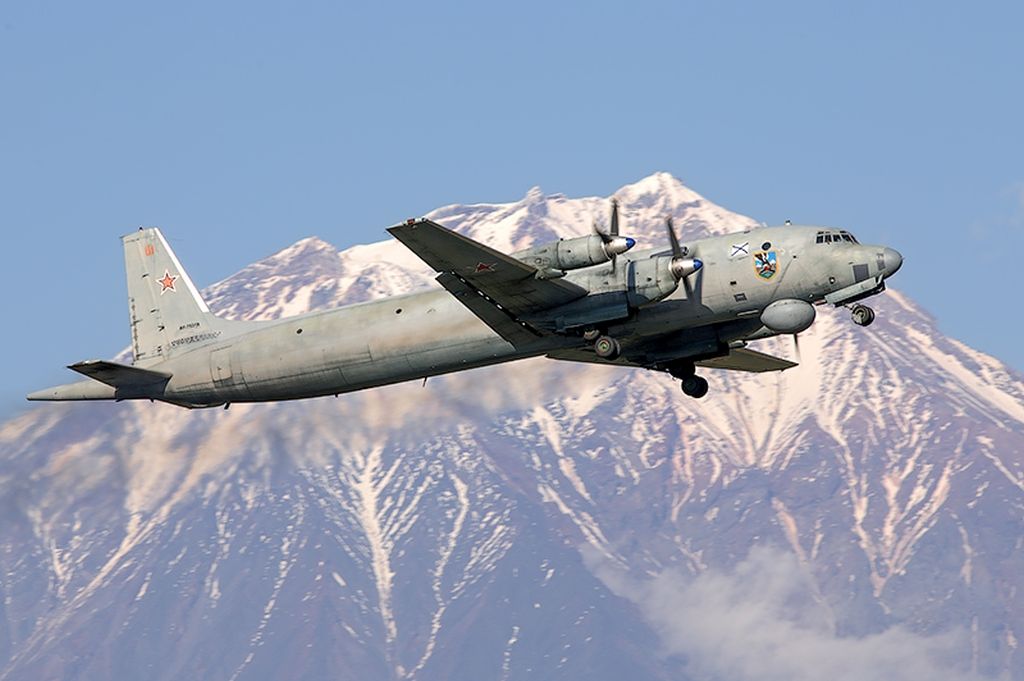
-
10 years agoTue Sep 29 2015, 06:49pm
 Main AdminFirst refuel for RAAF KC-30A refueller to F-35A (JSF)
Main AdminFirst refuel for RAAF KC-30A refueller to F-35A (JSF)
The Royal Australian Air Force (RAAF) has completed the first fuel transfer with the air refuelling boom from a RAAF KC-30A Multi-Role Tanker Transport (MRTT) to a US Air Force (USAF) F-35A Joint Strike Fighter at Edwards Air Force Base in California. A total of 59 contacts were conducted of which five contacts transferred 43,200 pounds of fuel during the four hour sortie.
Chief of the Air Force, Air Marshal Leo Davies AO CSC, described the trial as a significant step in the development of the KC-30A?s capability.
?Our KC-30A is an essential force multiplier. Mid-air refuelling is critical to ensuring global reach for our aircraft, our people and our equipment,? Air Marshal Davies said.
?Refuelling between the KC-30A and F-35A is an important step towards the KC-30A?s achievement of Final Operational Capability (FOC) and represents continued progress in the development of the F-35A.
?This achievement is significant because the future of Australia?s air combat capability is reliant on the successful partnership between these two aircraft and our ability to be interoperable with our international partners,? Air Marshal Davies said.
The KC-30A has two refuelling systems ? the hose-and-drogue and Advanced Refuelling Boom System (ARBS). The two different refuelling systems allow RAAF to support a wide range of coalition aircraft on Operation OKRA where a KC-30A is currently deployed to support combat operations against Daesh in Iraq and Syria.
The five KC-30As are based at RAAF Base Amberley (QLD) and Air Force will receive an additional two in 2018. A single KC-30A can carry a fuel load of more than 100 tonnes and remain 1800 kilometres from its home base with 50 tonnes of fuel available for offload, for four hours.
Australia has committed to 72 F-35As for RAAF Bases Williamtown and Tindal, with the first aircraft arriving in late 2018. The F-35A will replace the ageing F/A-18A/B Hornet with a 5th-generation networked fighter aircraft.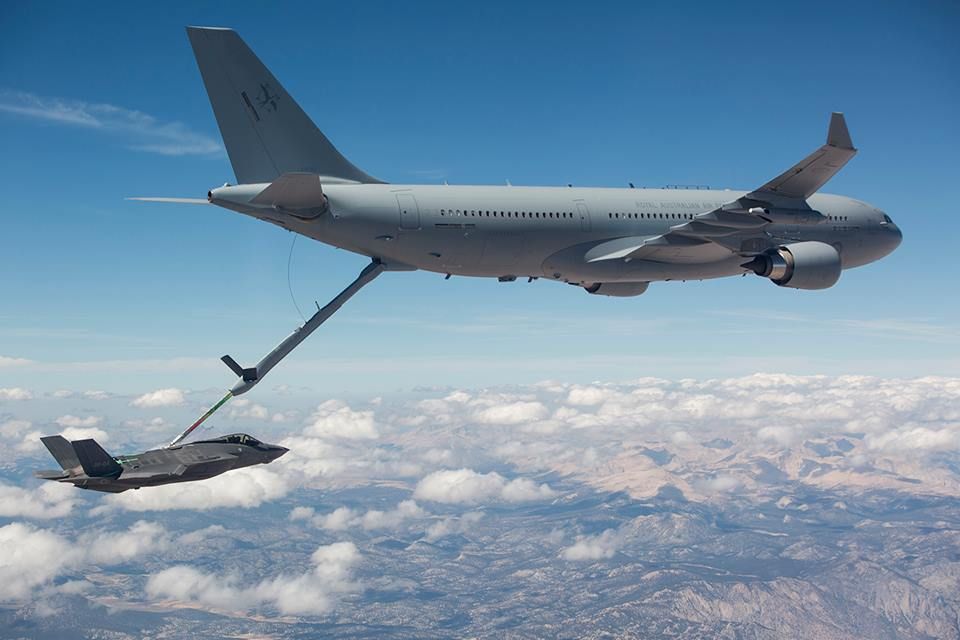
EVERETT, Wash., Sept. 28, 2015 ? Boeing (NYSE: BA) and Cathay Pacific Airways celebrated a significant achievement today with the delivery of the airline?s 70th 777 aircraft ? also the last and 53th 777-300ER (Extended Range) of its confirmed orders ? that has made Cathay Asia?s largest operator of the 777 fleet.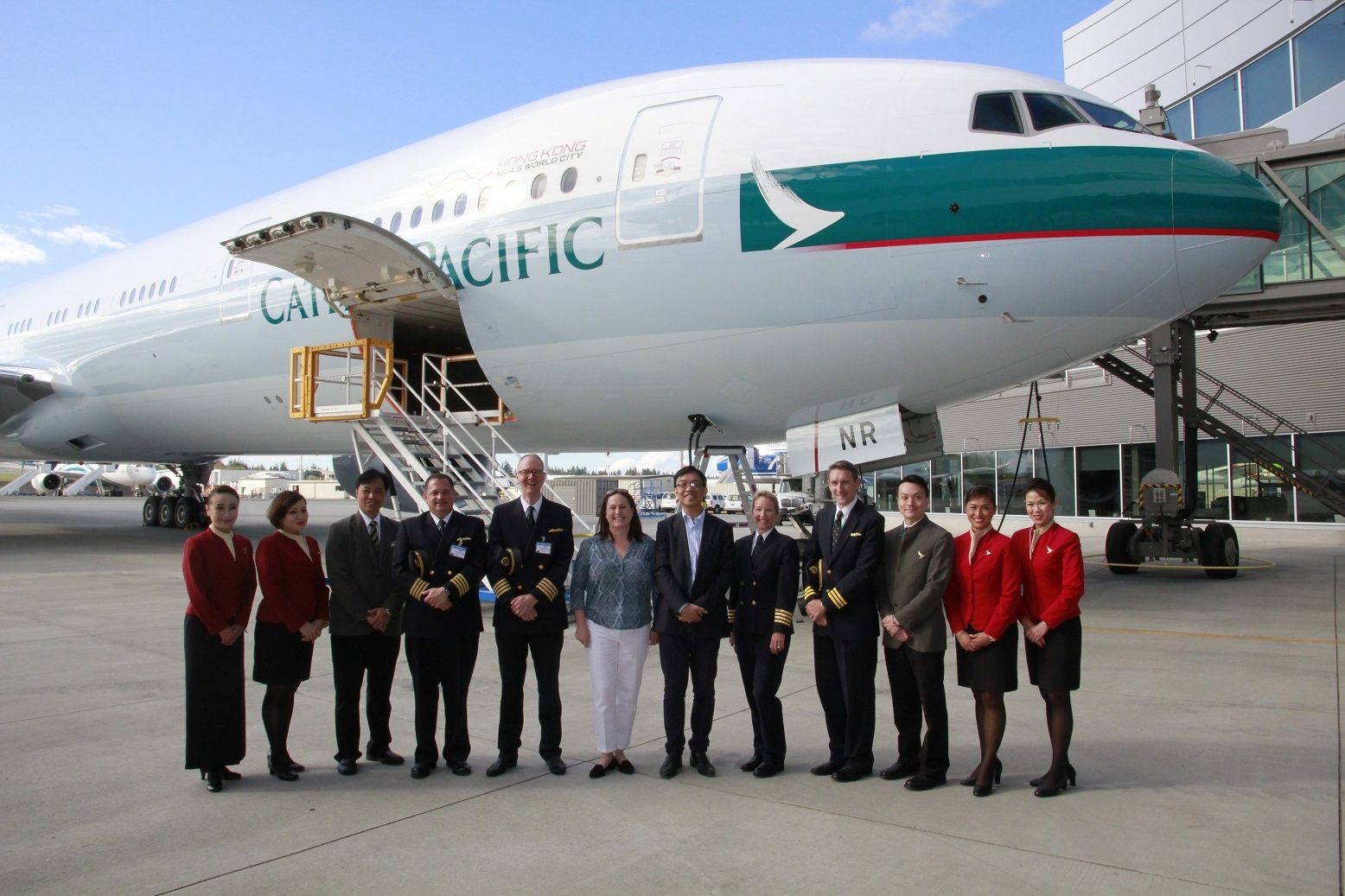
An F-15C Eagle fighter aircraft pilot assigned to the 123rd Expeditionary Fighter Squadron, 142nd Fighter Wing, Oregon Air National Guard, takes off during a theater security package deployment Sept. 25, 2015, at Campia Turzii, Romania. These deployments send a clear message to the international community that the U.S. is serious about security and stability in the region. (U.S. Air Force photo's by Staff Sgt. Christopher Ruano/Released)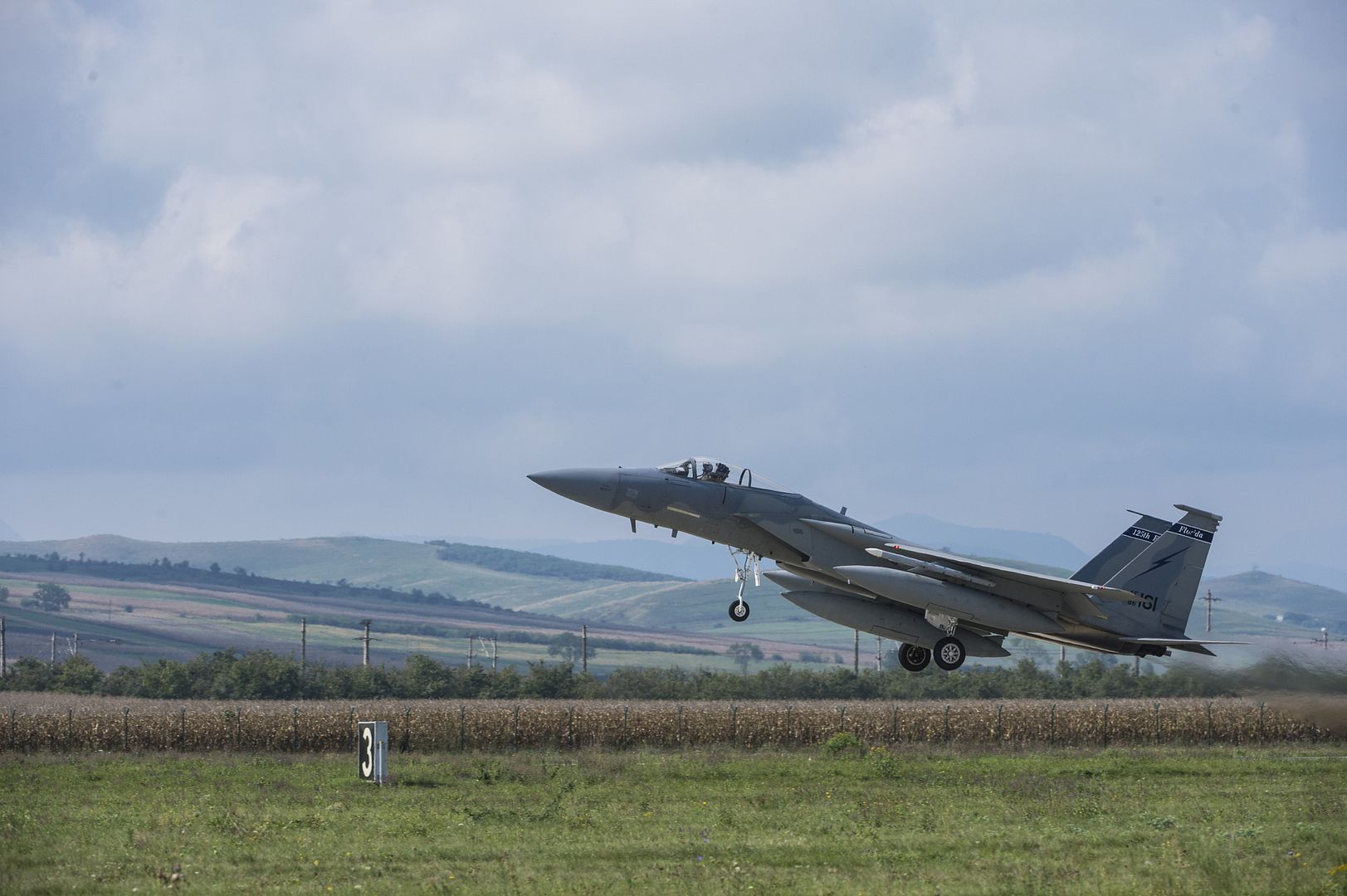

-
10 years ago
 Main AdminARABIAN GULF (Sept. 29, 2015) An AH-64 Apache with the U.S. Army?s 185th Theater Aviation Brigade prepares to land aboard the amphibious assault ship USS Essex (LHD 2). These Soldiers practiced landing and departing from the Essex in order to familiarize themselves with flight operations aboard a ship. The 15th Marine Expeditionary Unit, embarked aboard the ships of the Essex Amphibious Ready Group, is deployed to maintain regional security in the U.S. 5th Fleet area of operations. (U.S. Marine Corps photo by Cpl. Anna Albrecht/Released)
Main AdminARABIAN GULF (Sept. 29, 2015) An AH-64 Apache with the U.S. Army?s 185th Theater Aviation Brigade prepares to land aboard the amphibious assault ship USS Essex (LHD 2). These Soldiers practiced landing and departing from the Essex in order to familiarize themselves with flight operations aboard a ship. The 15th Marine Expeditionary Unit, embarked aboard the ships of the Essex Amphibious Ready Group, is deployed to maintain regional security in the U.S. 5th Fleet area of operations. (U.S. Marine Corps photo by Cpl. Anna Albrecht/Released)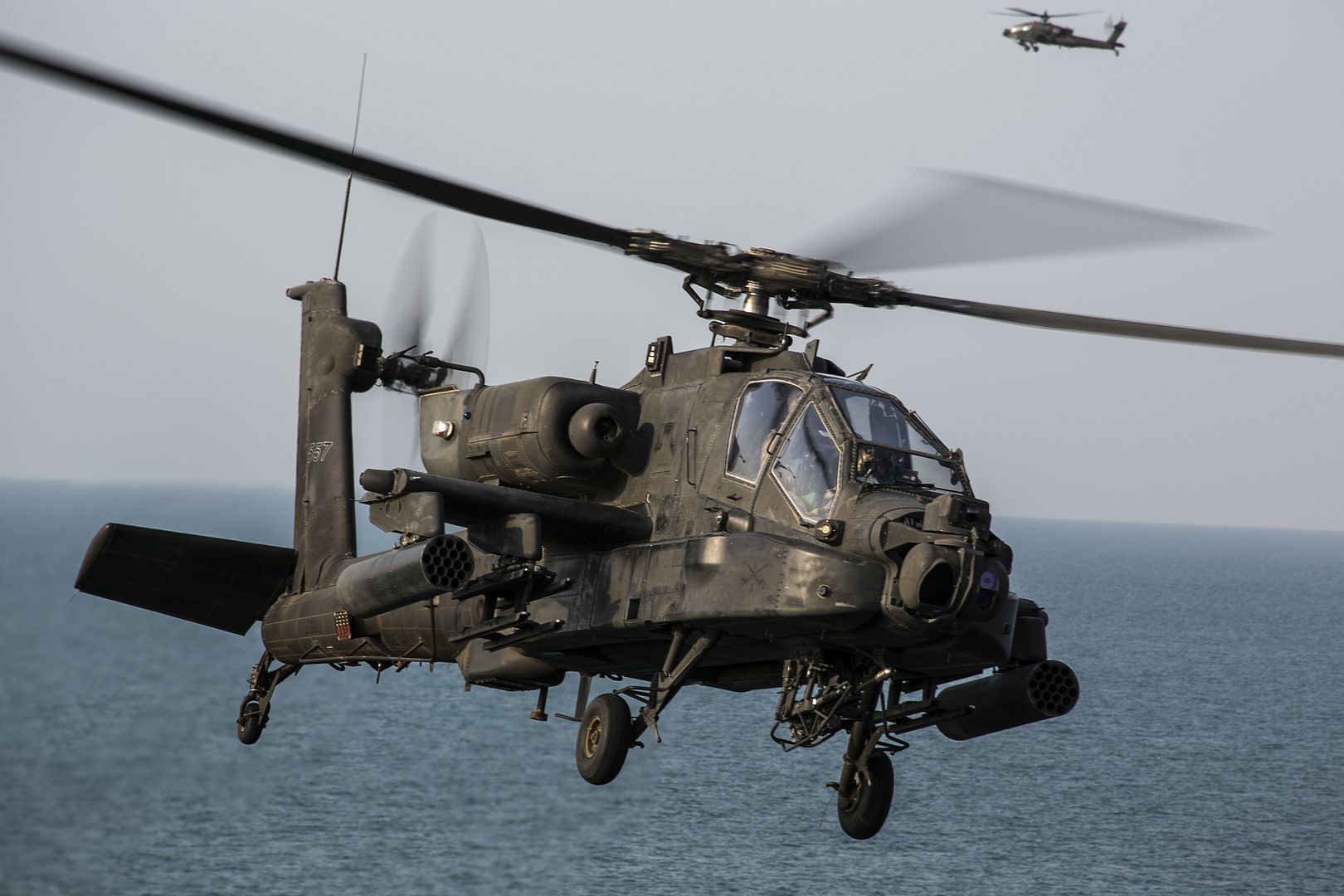
ARABIAN GULF (Sept. 29, 2015) An AH-64 Apache with the U.S. Army?s 185th Theater Aviation Brigade lands aboard the amphibious assault ship USS Essex (LHD 2). These Soldiers practiced landing and departing from the Essex in order to familiarize themselves with flight operations aboard a ship. The 15th Marine Expeditionary Unit, embarked aboard the ships of the Essex Amphibious Ready Group, is deployed to maintain regional security in the U.S. 5th Fleet area of operations. (U.S. Marine Corps photo by Cpl. Anna Albrecht/Released)
IWO TO, Japan (Sept. 29, 2015) Nimitz-class aircraft carrier USS Ronald Reagan (CVN 76), while underway off the island of Iwo To, formerly known as Iwo Jima, pauses to honor the fallen service members of the Battle of Iwo Jima. This year marks the 70th anniversary of the end of World War II. Ronald Reagan's presence highlights how the relationship has grown between both countries who are committed to the peace, security and stability of the Indo-Asia-Pacific region. (U.S. Navy photo's by Mass Communication Specialist 2nd Class Paolo Bayas/Released)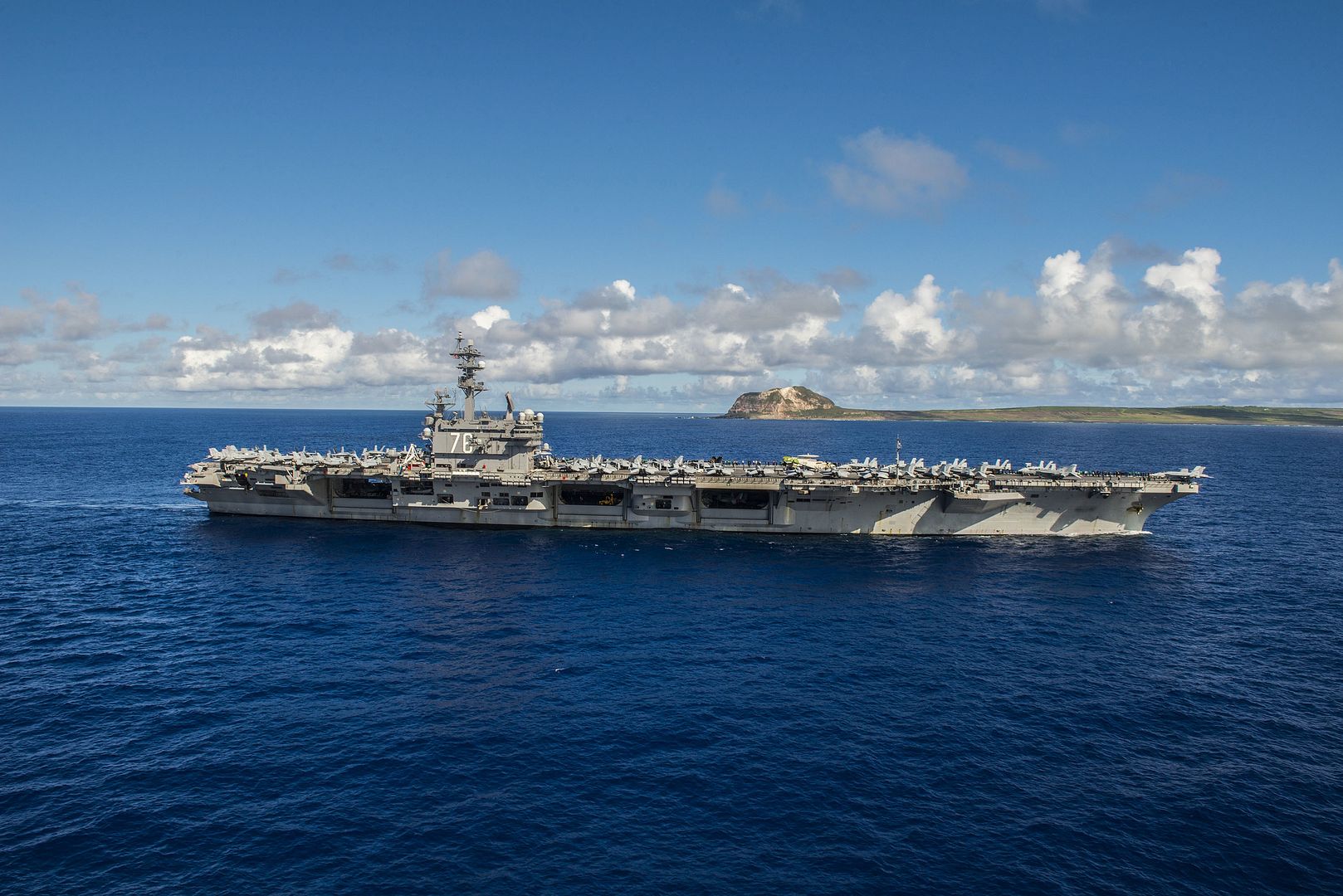

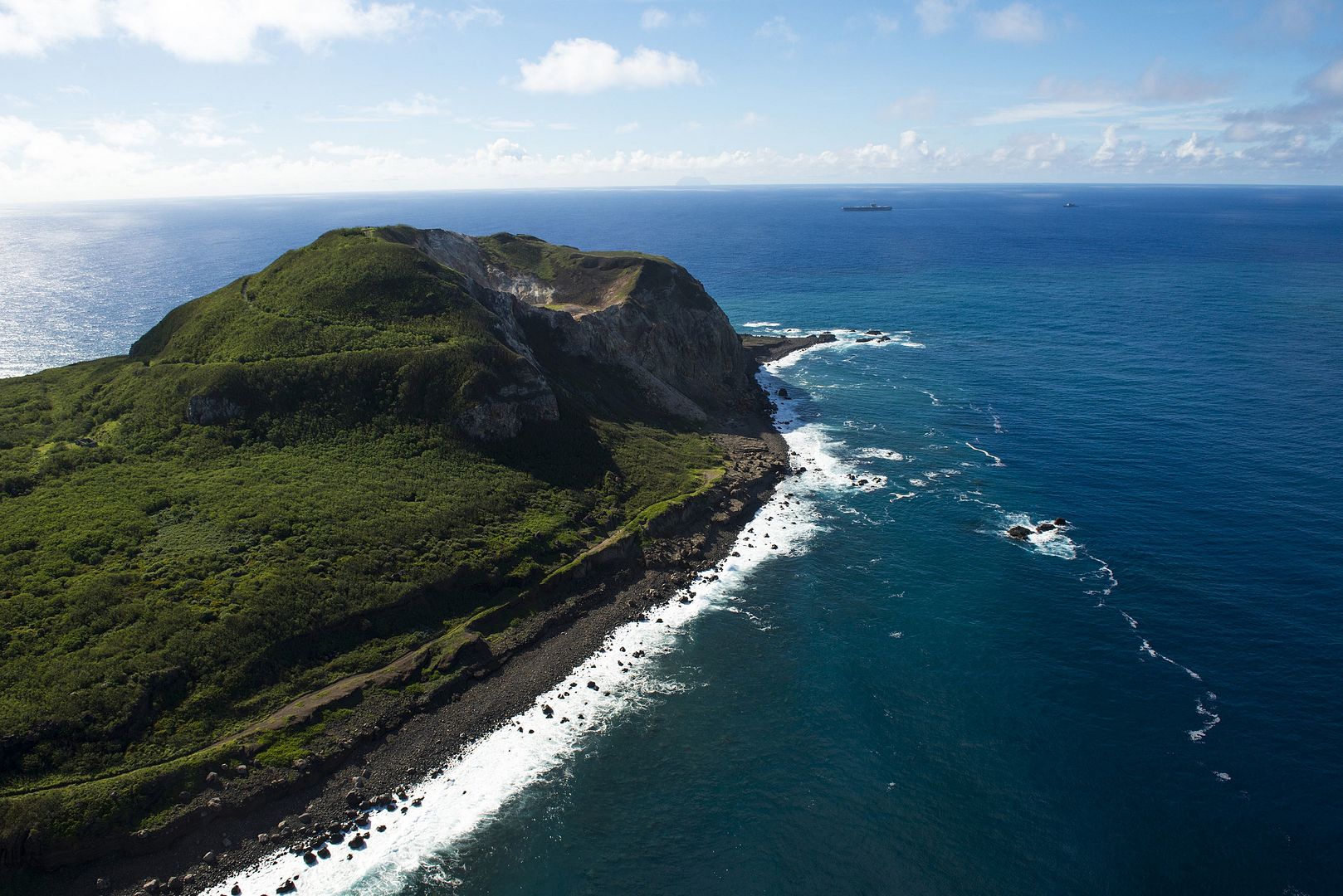
ATLANTIC OCEAN (Sept. 29, 2015) - Aviation Boatswain's Mate (Handling) 2nd Class Jeffrey Lozier directs an F/A-18E Super Hornet assigned to the Gladiators of Strike Fighter Squadron (VFA) 106 on the flight deck of the aircraft carrier USS Dwight D. Eisenhower (CVN 69). Dwight D. Eisenhower is underway completing carrier qualifications. (U.S. Navy photo by Mass Communication Specialist Seaman Anderson W. Branch/Released)
PHILADELPHIA, Sept. 29, 2015 ? The India Ministry of Defence has finalized its order with Boeing [NYSE: BA] for production, training and support of Apache and Chinook helicopters that will greatly enhance India?s capabilities across a range of military and humanitarian missions.
India will receive 22 AH-64E Apache attack helicopters and 15 CH-47F Chinook heavy-lift helicopters. Both are the newest models of those aircraft.
?This is a milestone in Boeing?s expanding commitment to India,? said Pratyush Kumar, president, Boeing India. ?This acquisition enhances the Indian Air Force?s capabilities and offers us an opportunity to further accelerate ?Make in India.? Large sections of the Chinook fuselage are already manufactured in India and discussions are ongoing with our Indian partners to make Apache parts.?
The Apache is the world?s leading multi-role attack helicopter. The AH-64E Apache, the most modern variant also flown by the U. S. Army, features enhanced performance, joint digital operability, improved survivability and cognitive decision aiding.
The CH-47F Chinook is an advanced multi-mission helicopter operated by the U.S. Army and 18 other defense forces. The Chinook has proven its ability to operate in the range of conditions that typify the Indian subcontinent, including delivering heavy payloads to high altitudes.
?These new aircraft will provide world-class capabilities to meet the Indian Air Force?s missions today, tomorrow and well into the future,? said David Koopersmith, vice president and general manager, Boeing Vertical Lift division. ?This agreement represents another major step forward in our long and successful relationship with India.?
India is the 14th nation to select the Apache and the 19th nation to select the Chinook.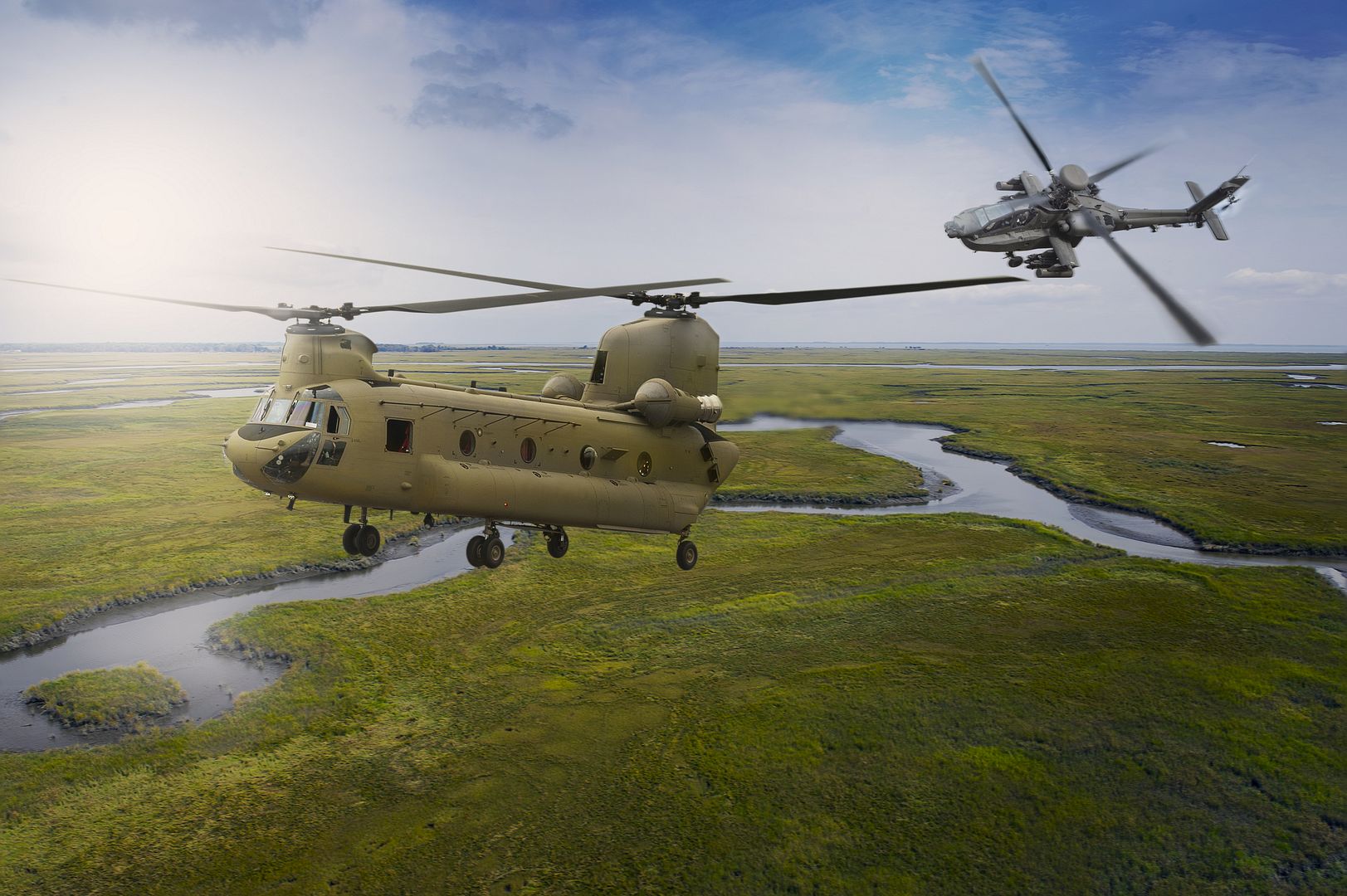
-
10 years agoThu Oct 01 2015, 01:47pm
 Main AdminATLANTIC OCEAN (Sept. 30, 2015) A C-2A Greyhound, assigned to the "Rawhides" of Fleet Logistic Support Squadron (VRC) 40, lands on the flight deck of aircraft carrier USS Harry S. Truman (CVN 75). The Harry S. Truman Carrier Strike Group is underway conducting training in preparation for a future deployment. (U.S. Navy photo by Mass Communication Specialist 3rd Class E. T. Miller/Released)
Main AdminATLANTIC OCEAN (Sept. 30, 2015) A C-2A Greyhound, assigned to the "Rawhides" of Fleet Logistic Support Squadron (VRC) 40, lands on the flight deck of aircraft carrier USS Harry S. Truman (CVN 75). The Harry S. Truman Carrier Strike Group is underway conducting training in preparation for a future deployment. (U.S. Navy photo by Mass Communication Specialist 3rd Class E. T. Miller/Released)
ATLANTIC OCEAN (Sept. 28, 2015) An EA-18G Growler, assigned to the ?Patriots? of Electronic Attack Squadron (VAQ) 140, launches from the flight deck of aircraft carrier USS Harry S. Truman (CVN 75). The Harry S. Truman Carrier Strike Group is underway participating in a Composite Training Unit Exercise (COMPTUEX) in preparation for a future deployment. (U.S. Navy photo by Mass Communication Specialist 3rd Class J. R. Pacheco/Released)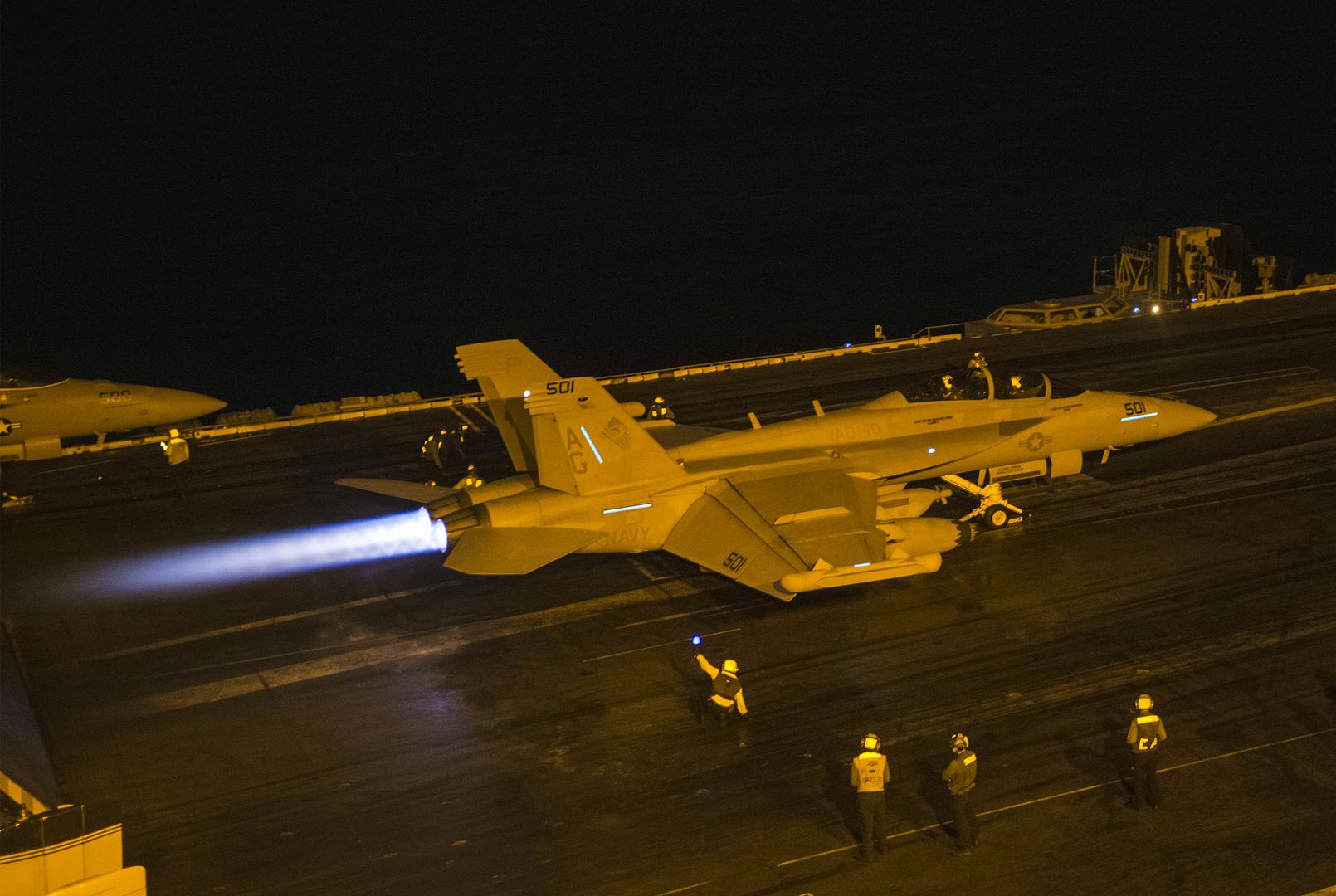
ATLANTIC OCEAN (Sept. 30, 2015) An F/A-18E Super Hornet, assigned to the "Fist of the Fleet" of Strike Fighter Squadron (VFA) 25, launches from the flight deck of aircraft carrier USS Harry S. Truman (CVN 75). The Harry S. Truman Carrier Strike Group is underway conducting training in preparation for a future deployment. (U.S. Navy photo by Mass Communication Specialist 3rd Class E. T. Miller/Released)
PACIFIC OCEAN (Sept. 30, 2015) Aviation Electronics Technician 3rd Class Howard Young launches an F/A-18C Hornet from the "Blue Blasters" of Strike Fighter Squadron (VFA) 34 on the flight deck of aircraft carrier USS George Washington (CVN 73). Washington is currently deployed around South America as a part of Southern Seas 2015. The eighth deployment of its kind, Southern Seas 2015 seeks to enhance interoperability, increase regional stability, and build and maintain regional relationships with countries throughout the region through joint multinational and interagency exchanges and cooperation. (U.S. Navy photo by Mass Communication Specialist 3rd Class Bryan Mai/Released)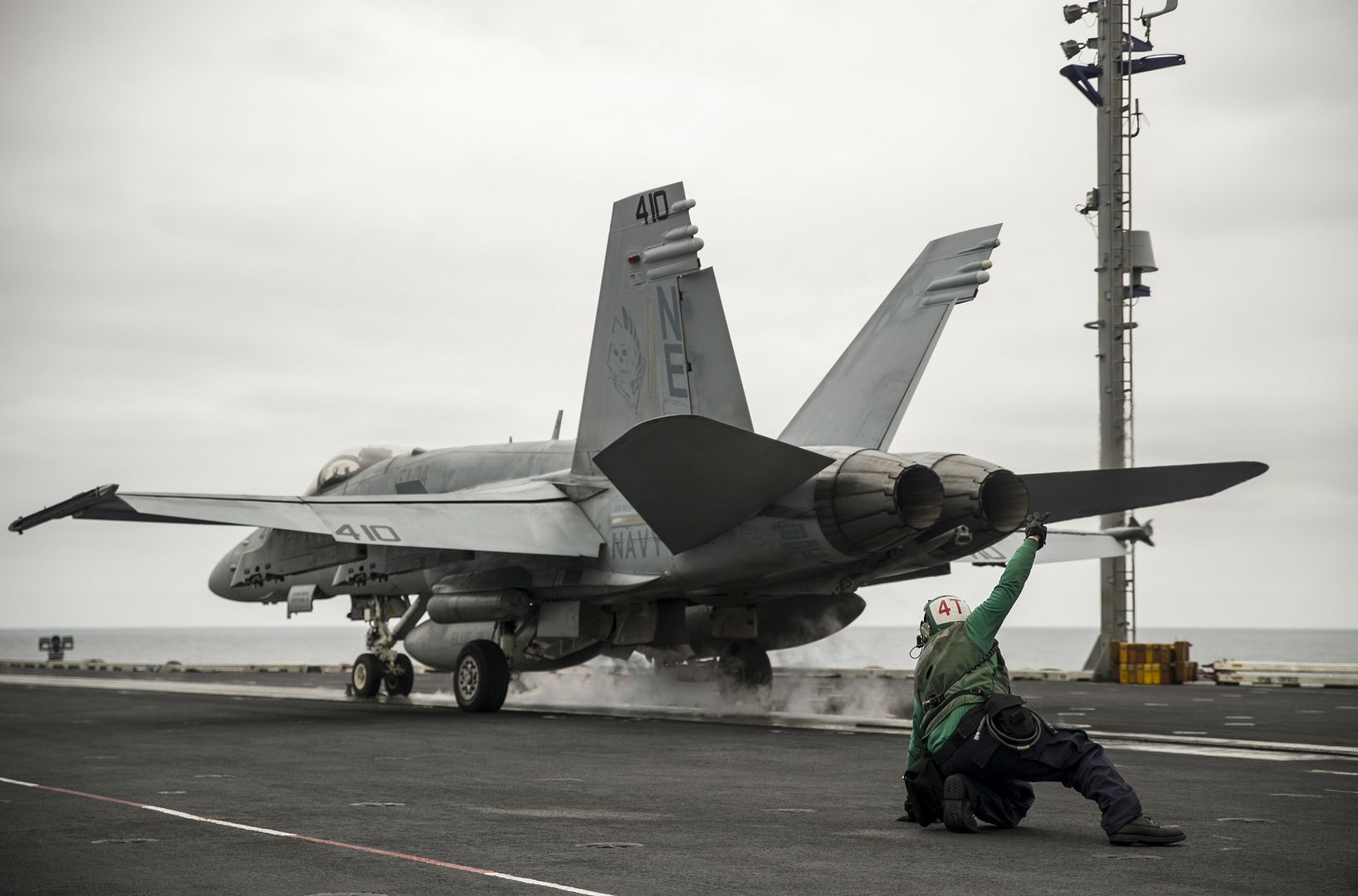
Personnel from RAF Odiham have embarked on the Royal Navy's amphibious helicopter carrier, HMS Ocean, to take part in the largest NATO exercise in 13 years.
Two RAF Chinook helicopters will operate with Merlin and Apache helicopters from the Fleet Air Arm and Army Air Corps, with the ship joining a task group of 70 warships from across NATO.
Exercise Trident Juncture 2015 will be held through October and November, predominantly in, over and on the seas around Portugal, Spain and Italy. It is one of a series of long-planned exercises to ensure that NATO Allies are ready to deal with any emerging crisis, from any direction, and that they are able to work effectively with partners in tackling any crisis.
Over 36,000 personnel from 30 nations will take part, including NATO Allies as well as partner nations of Australia, Austria, Bosnia and Herzegovina, Finland, the former Yugoslav Republic of Macedonia, Sweden and Ukraine.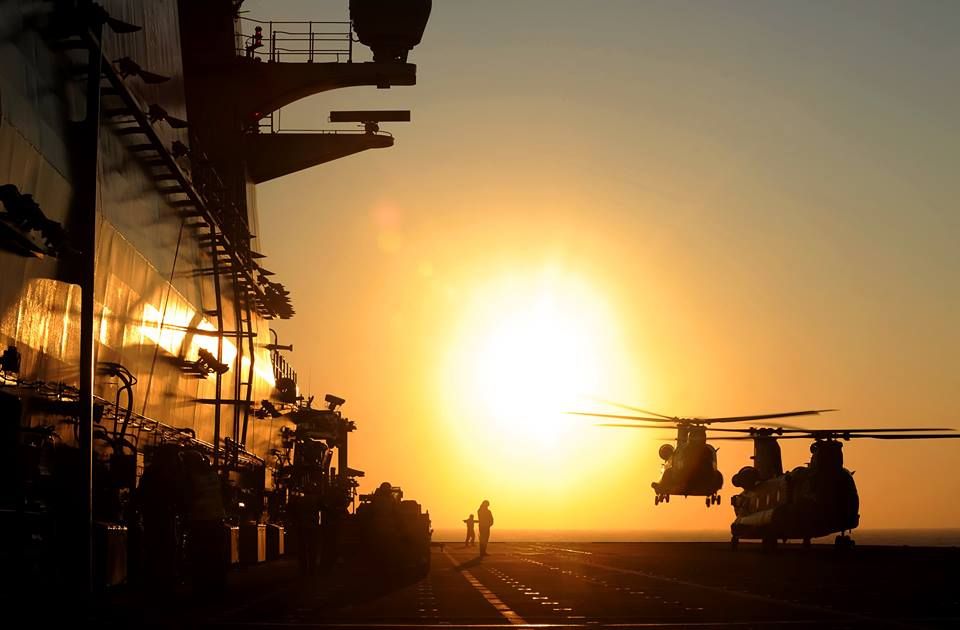
A Royal Australian Air Force Airborne Early Warning and Control aircraft, the E-7A Wedgetail, takes off for another mission in Iraq from Australia's main operating base in the Middle East.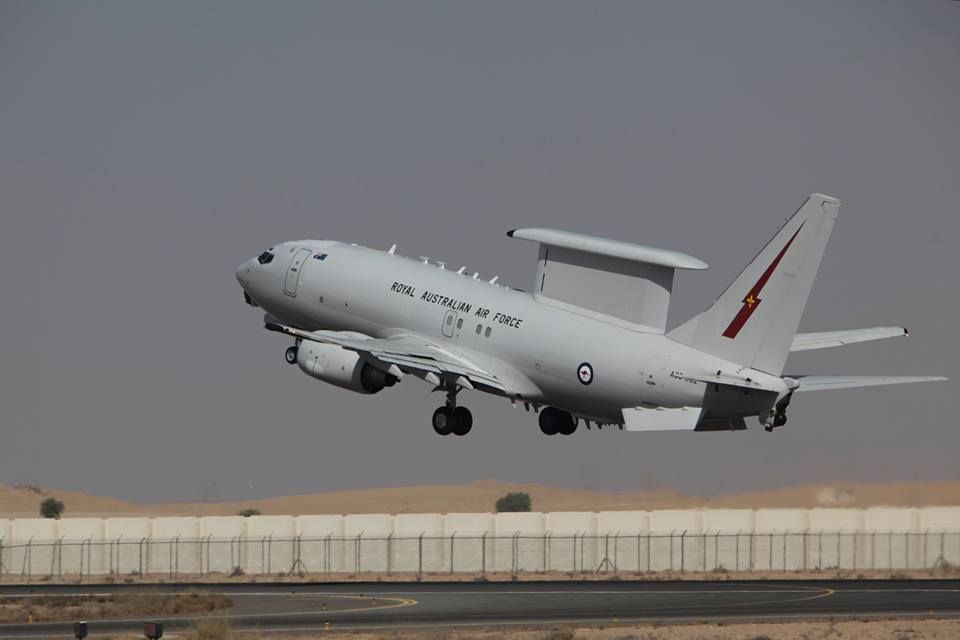
A Royal Australian Air Force (RAAF) E-7A Wedgetail Airborne Early Warning and Control aircraft briefly shares the airspace with other RAAF jets - two F/A-18F Super Hornets and a KC-30A Multi-Role Tanker Transport as they fly towards Iraq to begin their missions.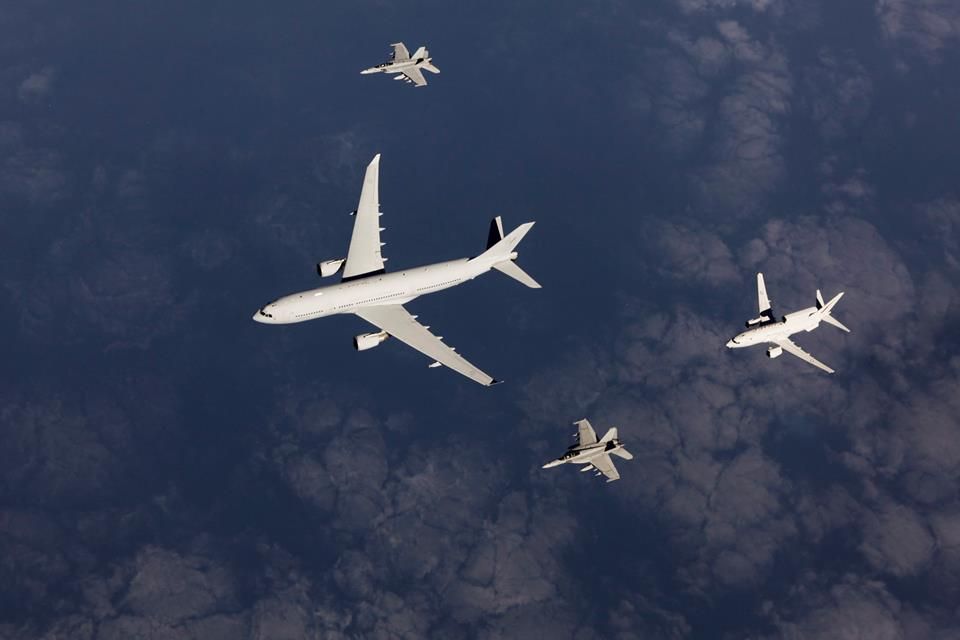
These three Rafale fighters were part of the force which, early on Sept 27, carried out the first French air strike against Islamic State targets in Syria. The strikes targeted a training camp.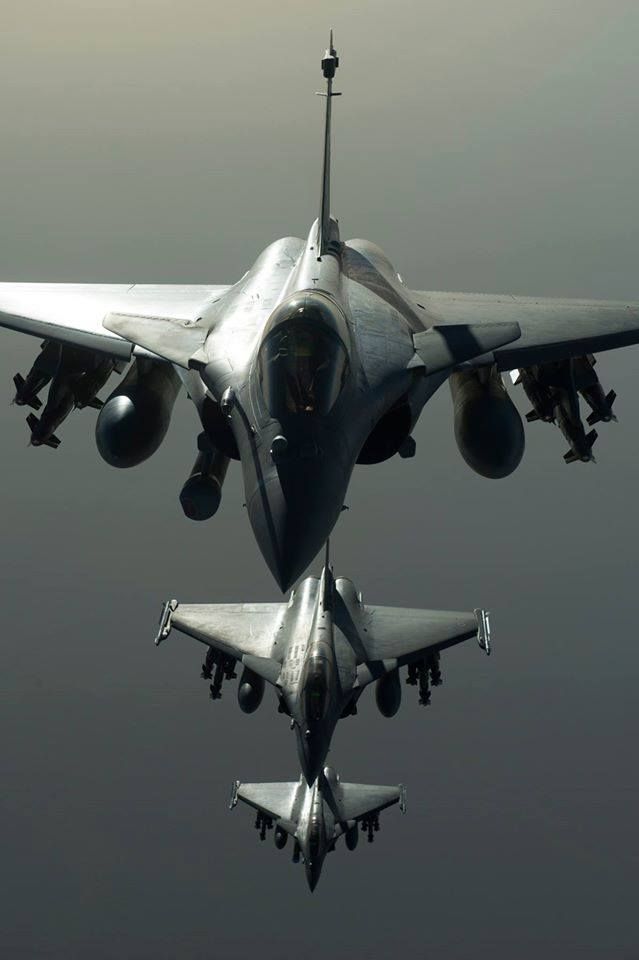
30 September 2015 Press Release
China?s flag carrier Air China has taken delivery of its 50th A330 in Toulouse, France. The aircraft, an A330-300 is the first 242 tonnes maximum take-off-weight (MTOW) version to be operated by a Chinese airline. The increased MTOW allows airlines to operate longer range at improved operating costs.
Displaying a special livery to celebrate the ?50th A330 for Air China?, the aircraft is configured with a three class cabin layout (30 business, 16 premium economy and 255 economy)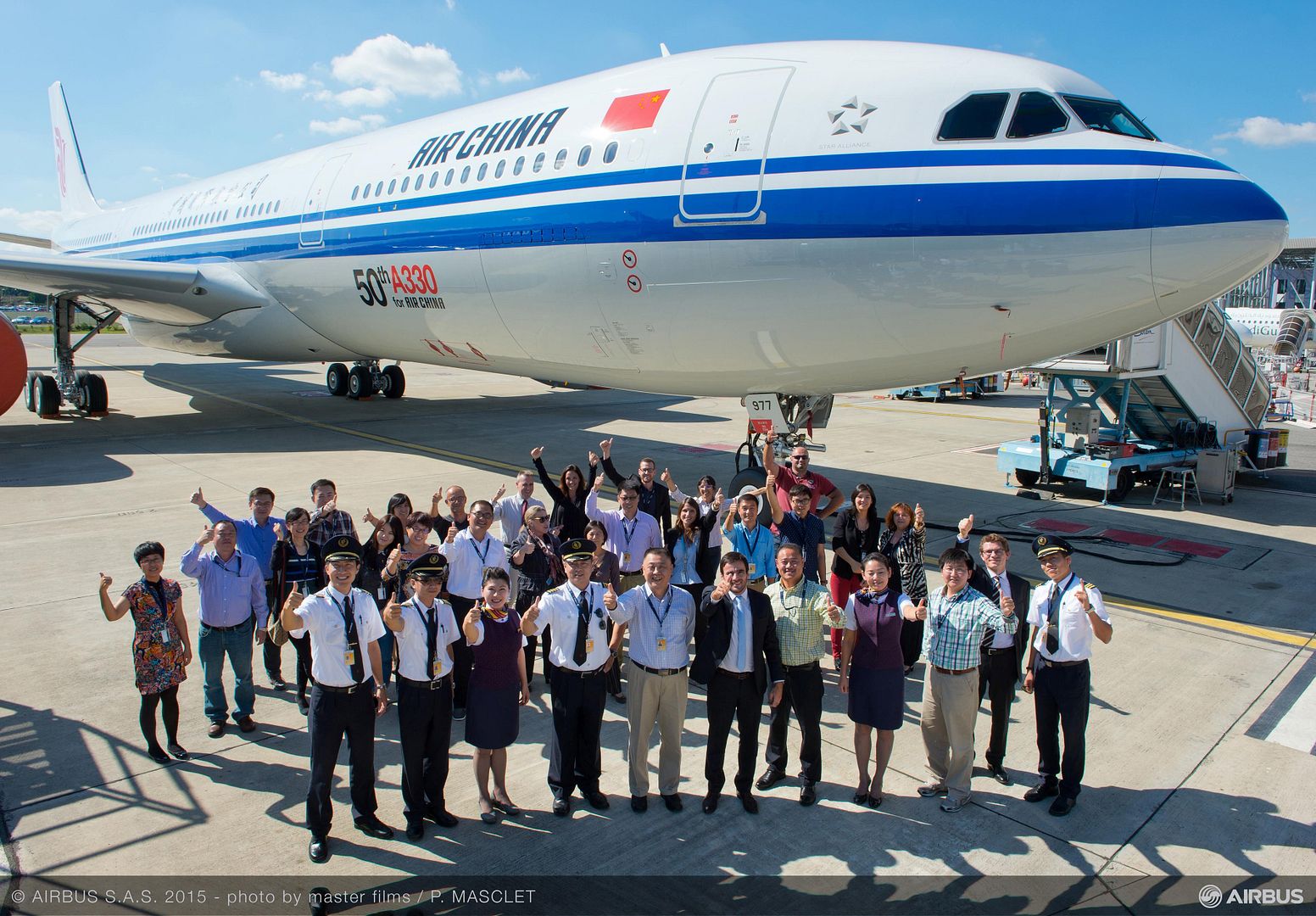
-
10 years agoTue Oct 06 2015, 01:04pm
 Main AdminATLANTIC OCEAN (Oct. 2, 2015) An F-35C Lightning II carrier variant joint strike fighter assigned to the Salty Dogs of Air Test and Evaluation Squadron (VX) 23 makes an arrested landing aboard the aircraft carrier USS Dwight D. eisenhower (CVN 69). The F-35C Lightning II Pax River Integrated Test Force is currently conducting follow-on sea trials aboard the Eisenhower. (U.S. Navy photo by Mass Communication Specialist 3rd Class Utah Kledzik/Released)
Main AdminATLANTIC OCEAN (Oct. 2, 2015) An F-35C Lightning II carrier variant joint strike fighter assigned to the Salty Dogs of Air Test and Evaluation Squadron (VX) 23 makes an arrested landing aboard the aircraft carrier USS Dwight D. eisenhower (CVN 69). The F-35C Lightning II Pax River Integrated Test Force is currently conducting follow-on sea trials aboard the Eisenhower. (U.S. Navy photo by Mass Communication Specialist 3rd Class Utah Kledzik/Released)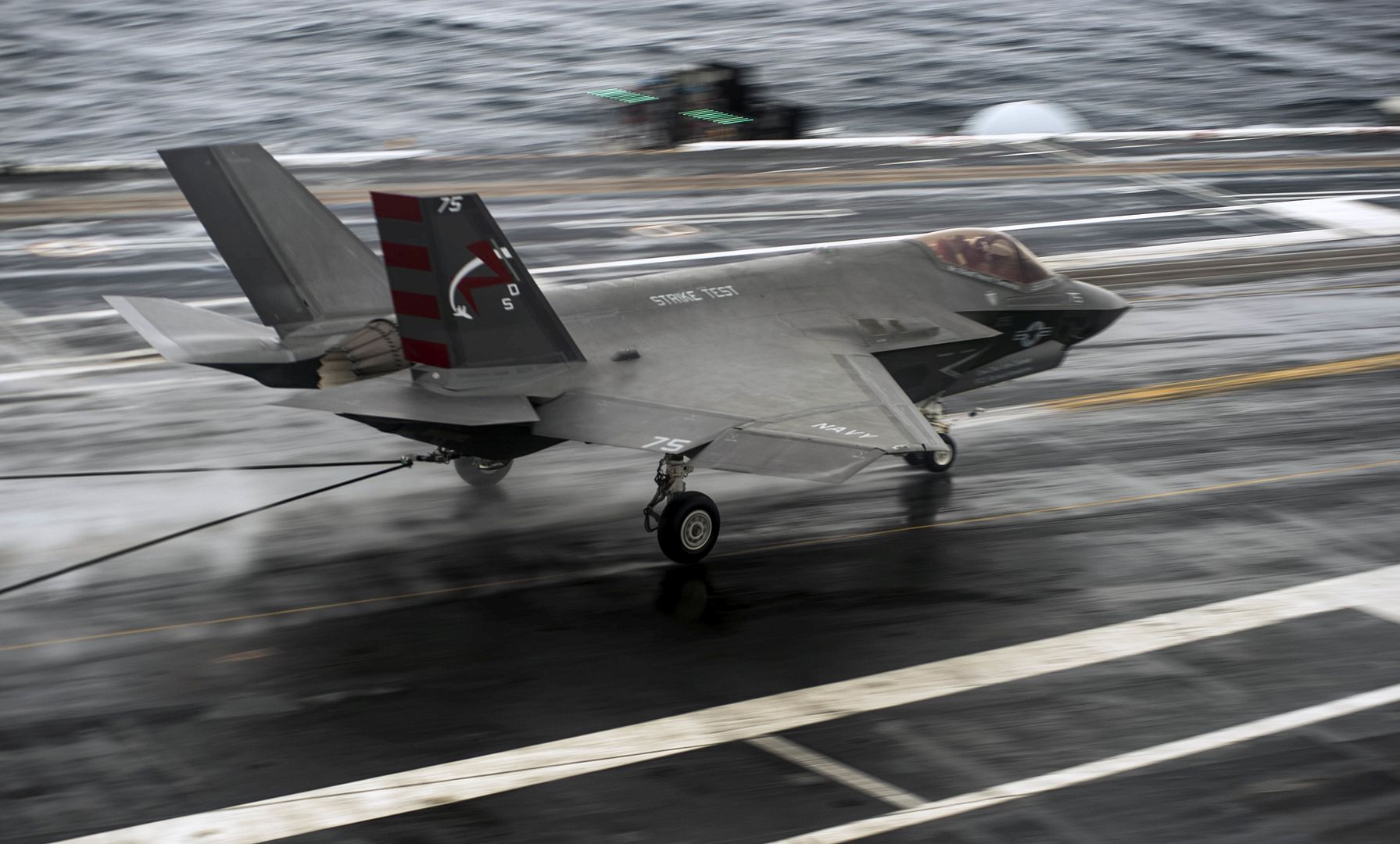
ATLANTIC OCEAN (Oct. 4, 2015) - An F-35C Lightning II carrier variant joint strike fighter assigned to the Salty Dogs of Air Test and Evaluation Squadron (VX) 23 prepares to make an arrested landing aboard the aircraft carrier USS Dwight D. Eisenhower (CVN 69). The F-35C Lightning II Pax River Integrated Test Force is currently conducting follow-on sea trials aboard the Eisenhower. (U.S. Navy photo by Mass Communication Specialist 3rd Class Ryan U. Kledzik/Released)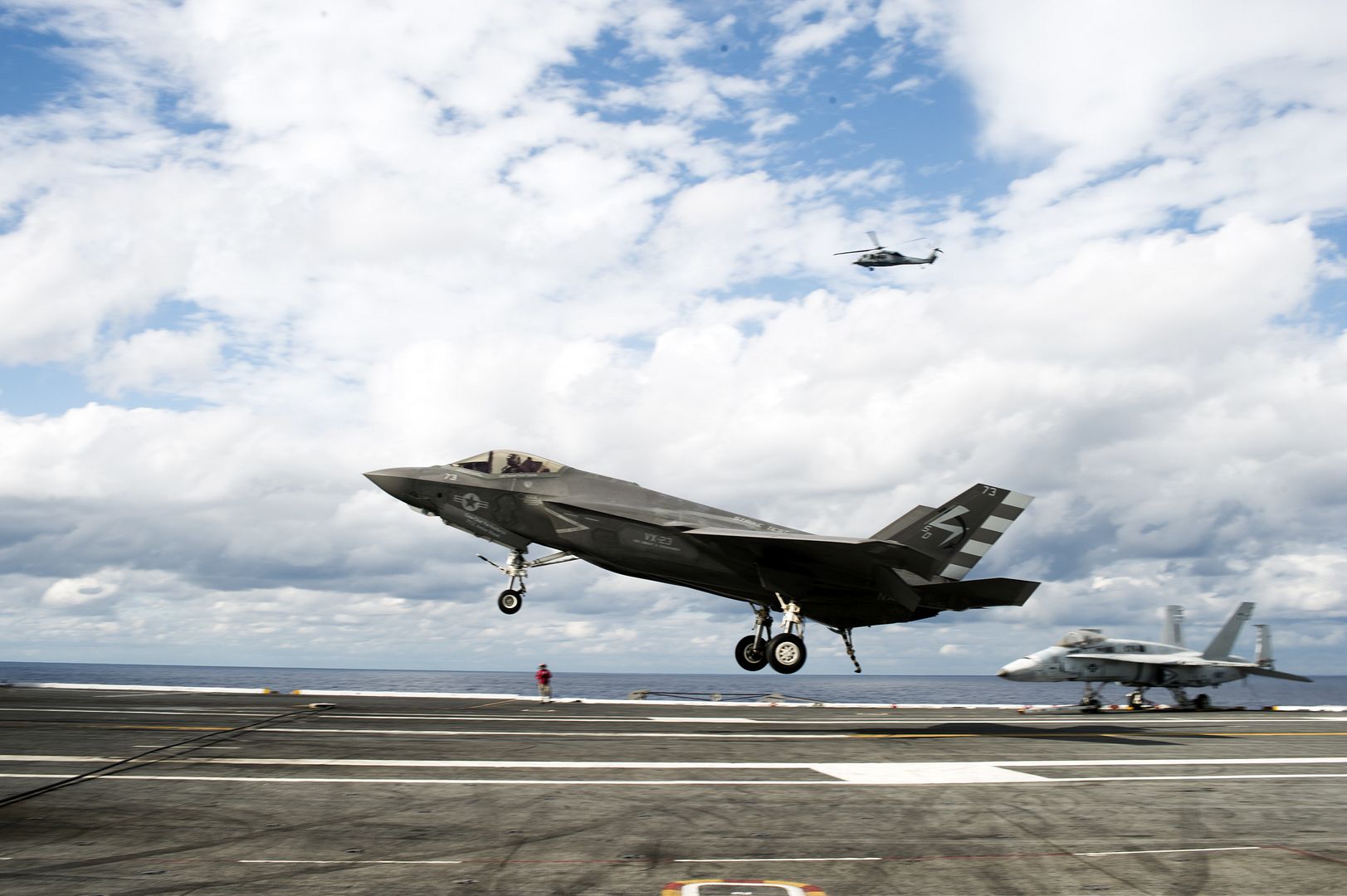
ATLANTIC OCEAN (Oct. 4, 2015) - An F-35C Lightning II carrier variant joint strike fighter assigned to the Salty Dogs of Air Test and Evaluation Squadron (VX) 23 takes off from the flight deck of the aircraft carrier USS Dwight D. Eisenhower (CVN 69). The F-35C Lightning II Pax River Integrated Test Force is currently conducting follow-on sea trials aboard the Eisenhower. (U.S. Navy photo by Mass Communication Specialist 3rd Class Ryan U. Kledzik/Released)
ATLANTIC OCEAN (Oct. 4, 2015) ? Sailors refuel an F-35C Lightning II carrier variant joint strike fighter assigned to the Salty Dogs of Air Test and Evaluation Squadron (VX) 23 on the flight deck of the aircraft carrier USS Dwight D. Eisenhower (CVN 69). The F-35C Lightning II Pax River Integrated Test Force is currently conducting follow-on sea trials aboard the Eisenhower. (U.S. Navy photo by Mass Communication Specialist 3rd Class Jameson E. Lynch/Released)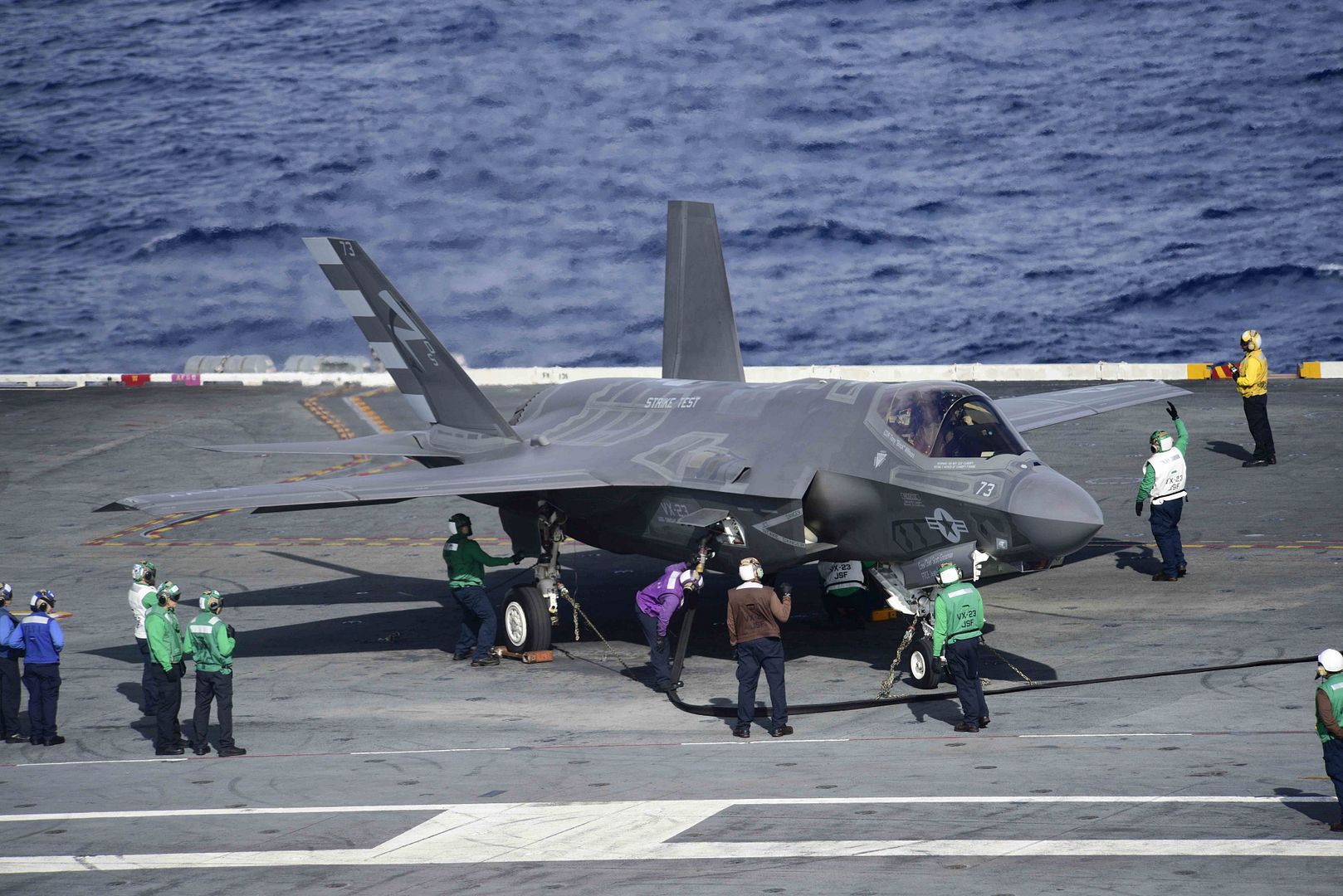
ATLANTIC OCEAN (Oct. 4, 2015) ? An F-35C Lightning II carrier variant joint strike fighter assigned to the Salty Dogs of Air Test and Evaluation Squadron (VX) 23 takes off from the flight deck of the aircraft carrier USS Dwight D. Eisenhower (CVN 69). The F-35C Lightning II Pax River Integrated Test Force is currently conducting follow-on sea trials aboard the Eisenhower. (U.S. Navy photo by Mass Communication Specialist 3rd Class Jameson E. Lynch/Released)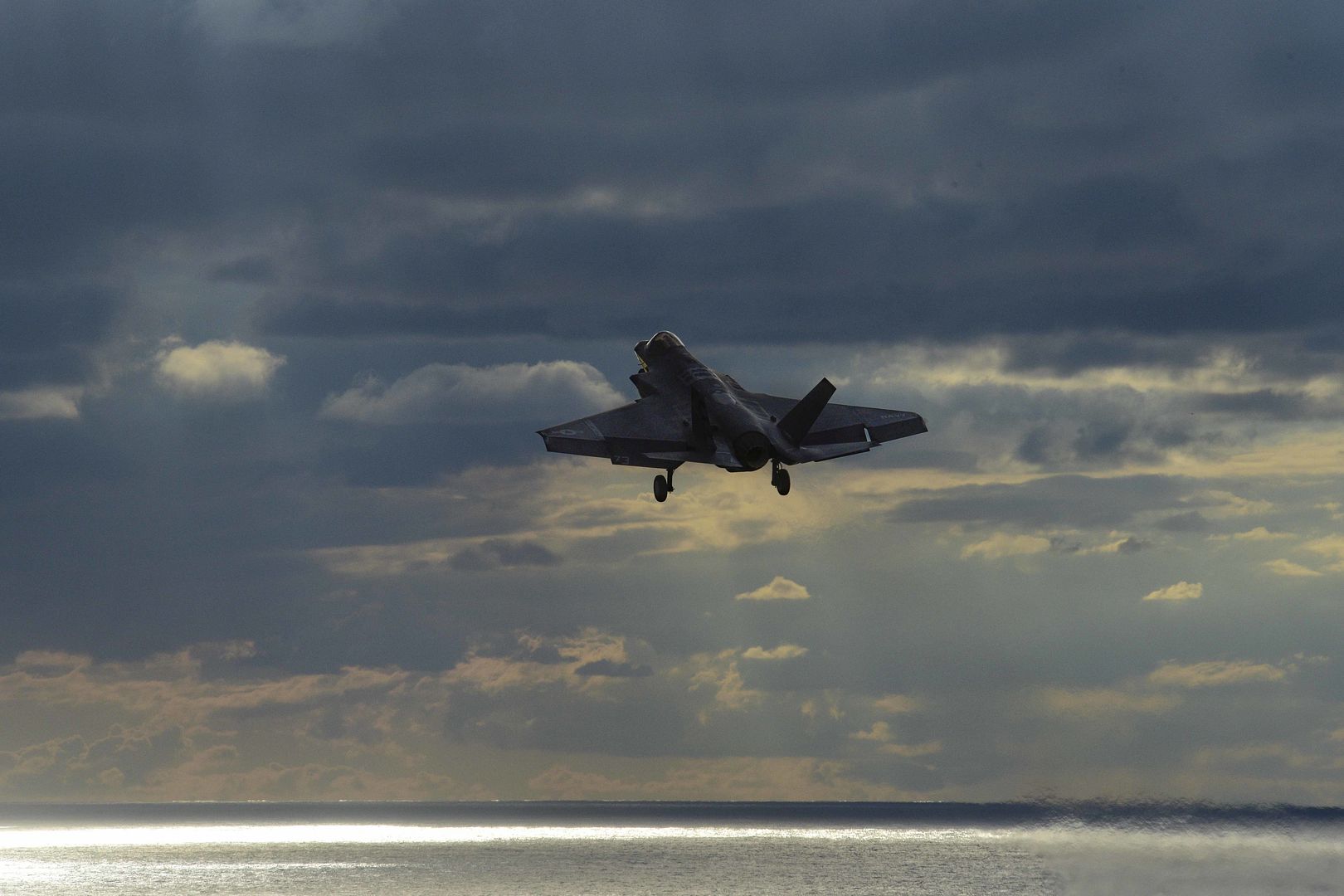
01-10-2015 / Within special flight tests the AN?70 successfully over passed a distance more than 13,000 km
From 22 to 26 September 2015, the AN?70 short takeoff and landing military transport performed an international flight and carried a military cargo within evaluation of transport capacity and widening the operational conditions.
From the Kyiv?Antonov airport, the aircraft flew to Bangui, Central African Republic. This flight endured 9 hours 2 minutes. In Bangui, the AN?70 took on board a cargo weighting 23.6 tons. After that, the aircraft landed in Ndjamena, the Republic of Chad. According to Viktor Goncharov, test pilot of ANTONOV, the crew captain, "from Ndjamena airport we took off under a temperature of +33 Celsius degrees with a take?off weight close to the maximum. The aircraft confirmed designed data of the take off parameters including length of the runway distance. AN?70 also showed good climb rate?. After 6?hour flight, the AN?70 arrived to the place of the cargo destination ? to Istres, France. The aircraft returned to the Kyiv?Antonov airport with intermediate stop in Leipzig, Germany.
In this expedition AN?70 was in the air more than 20 hours, flew over 13,600 km. Throughout the route the aircraft demonstrated its high flying, take off and landing characteristics as well as low fuel consumption. On?board handling equipment was tested under actual operating conditions. All the tasks were performed successfully.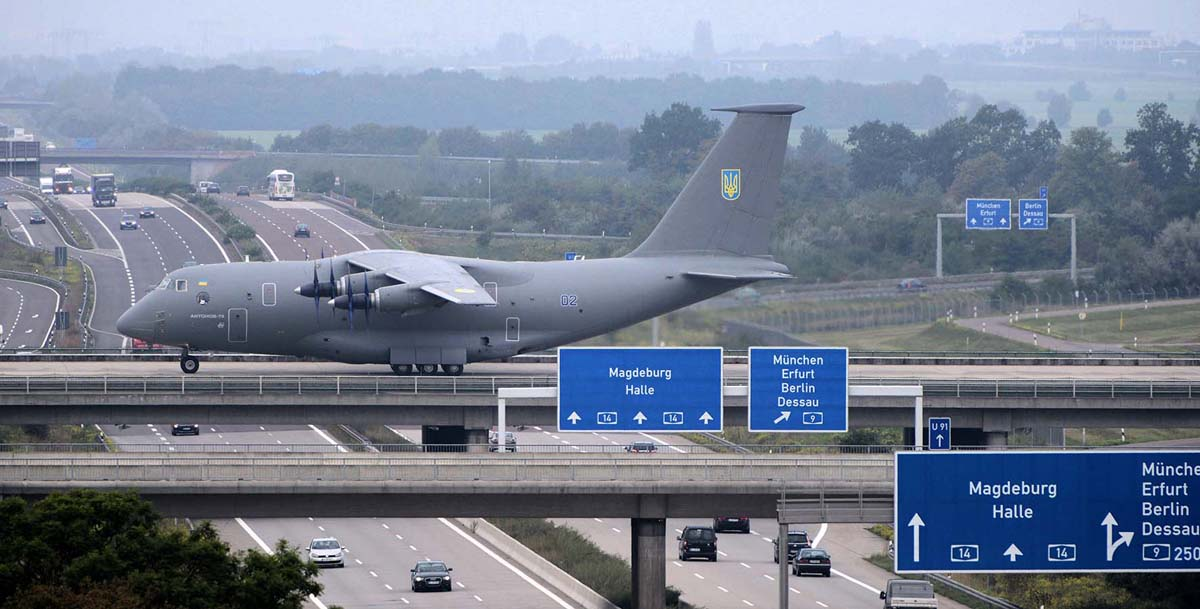
02 October 2015
Veteran aircraft of past and present RAF combat missions paid tribute to the heroes of Bomber Command by performing a spectacular mid-air link-up over Lincolnshire.
Tornado GR4 fighter bomber crews, whose comrades are currently taking part in the international coalition campaign against Islamic State militants, flew in formation with former Cold War warrior Vulcan XH558 to mark the unveiling of the Bomber Command Memorial spire in Lincoln.
A 12 (Bomber) Squadron pilot who flew on the sortie said: ?It was a real privilege to fly one last time with such a historic and magnificent aircraft. It was a fitting tribute that the RAF?s current bomber, the Tornado GR4, escorted the old Vulcan bomber, a once in a lifetime opportunity which we were very proud to be a part of?.
The RAF Marham-based squadron, which this year celebrated its centenary, has a distinguished list of battle honours including combat operations in Iraq, being the first GR4 unit to operate in Afghanistan, and supporting long range bombing raids against Gaddafi-regime targets in Libya.
Britain?s only flying Vulcan, which this year completes its final flying season, was the first B2 bomber delivered into RAF service on 1 July 1960 and at 55 years old is the last and oldest of its type anywhere in the world.
Despite 24 years service in the RAF the Vulcan was only once used in anger ? against Port Stanley in the Falklands in the famous ?Operation Black Buck? mission to deny the Argentines use of the airfield.
Vulcan pilot Wing Commander Bill Ramsey (retired), who flew the delta-winged icon for nine years, said: ?I am really pleased RAF and Vulcan To The Sky team came together to set up a Vulcan and Tornado ?Past and Present? flight; especially on the occasion of the dedication of the new Bomber Command Memorial in Lincoln that commemorates the service and sacrifice of so many brave people.?
Editor: Simon Mander
Photographs: Rich Cooper
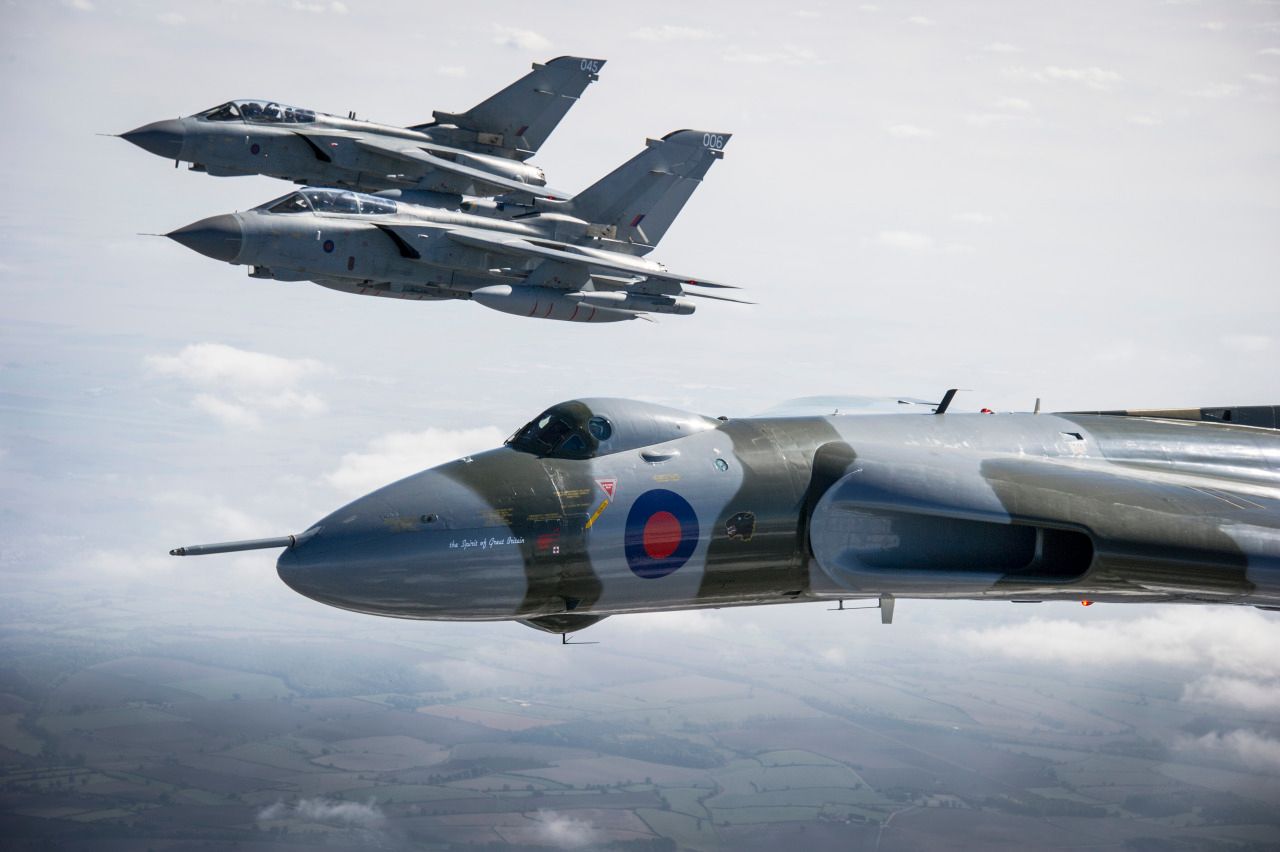
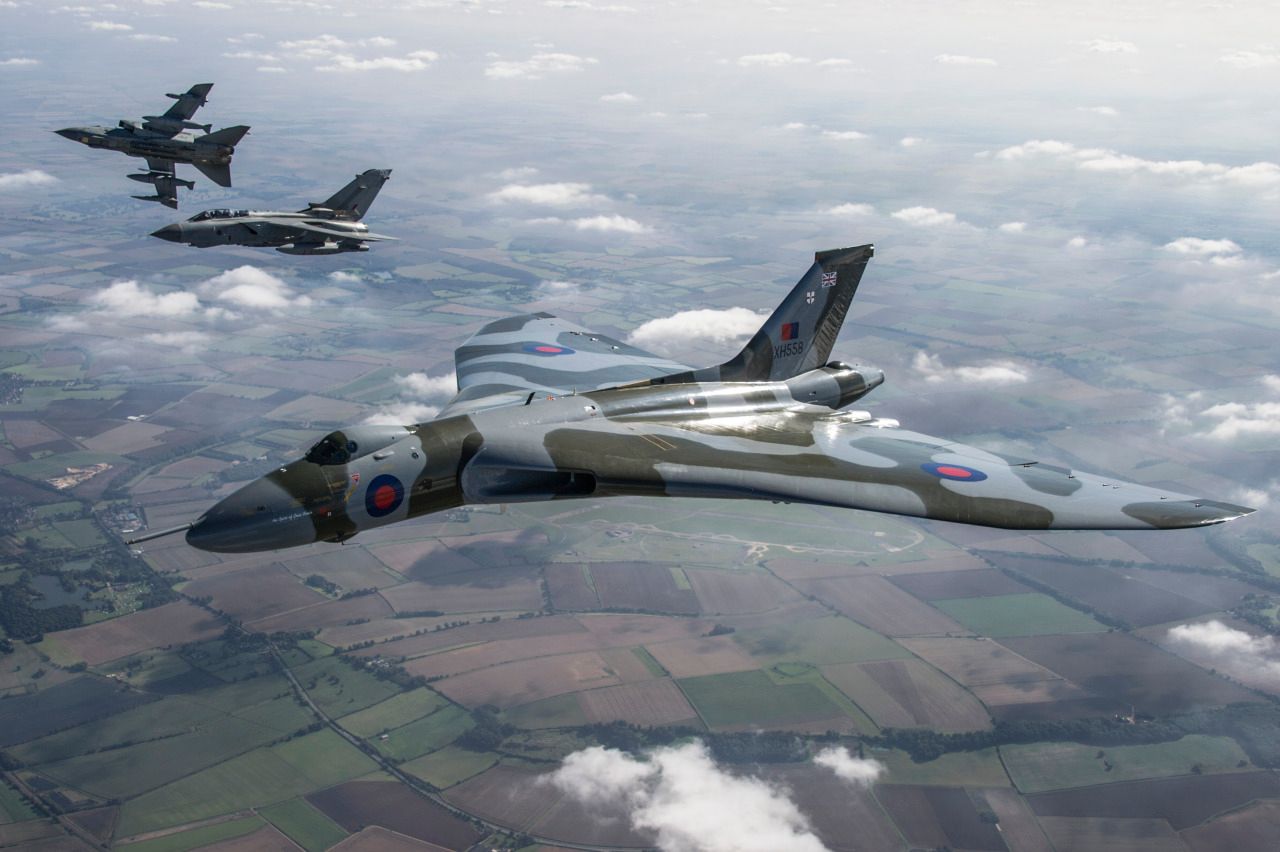
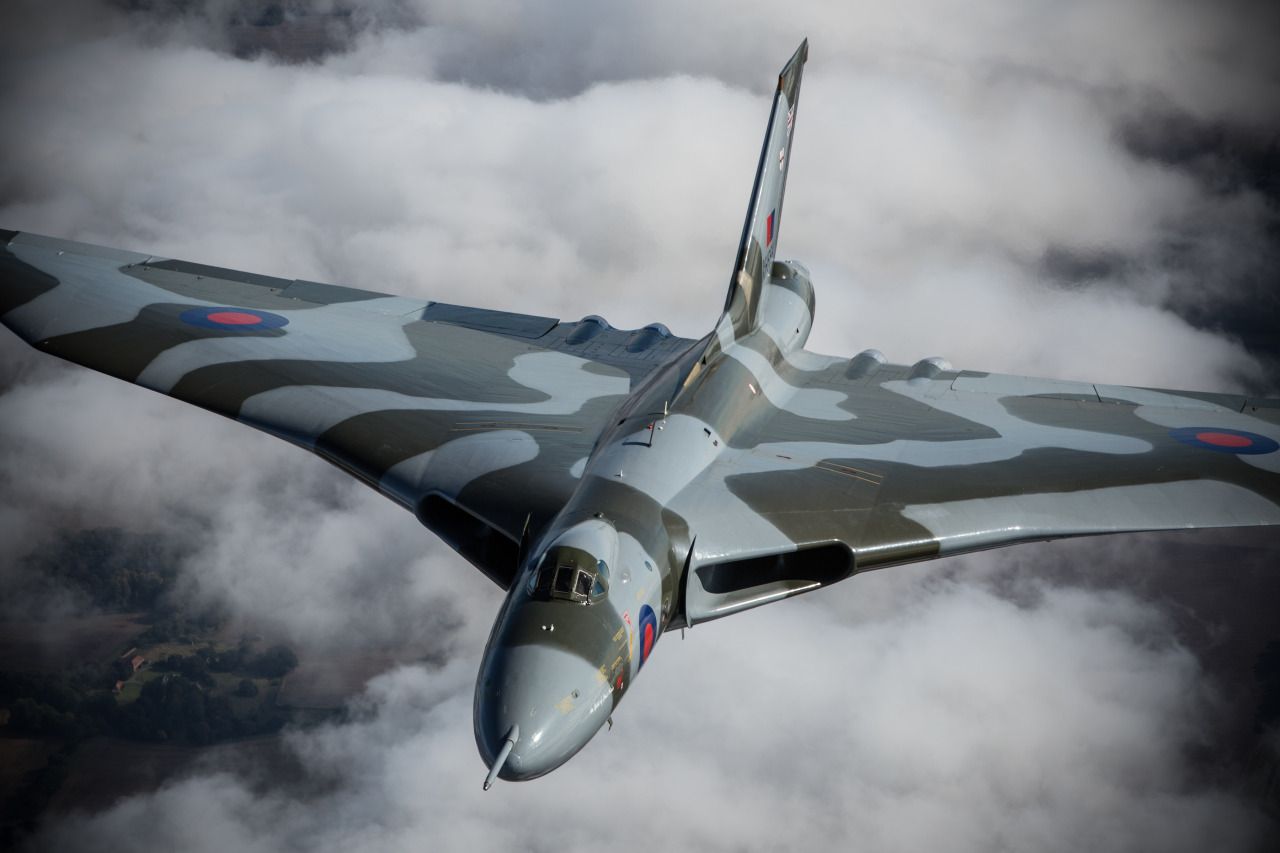
ST. LOUIS, Oct. 2, 2015 ? Boeing [NYSE: BA] has completed its upgrade of all U.S. Air Force F-22 Raptor Mission Training Centers with its high-fidelity Constant Resolution Visual System (CRVS). The system trains pilots in a more realistic visual environment than current simulators and allows them to experience extreme maneuvers that typically are only practiced in a simulator.
The final CRVS installations were recently done by Boeing and the Air Force at Tyndall Air Force Base in Florida. Simulators at Hawaii?s Hickam Air Force Base, Alaska?s Elmendorf Air Force Base and Virginia?s Langley Air Force Base, also have the system.
"The final installation of the Boeing Constant Resolution Visual System improves the realism of ground-based training and increases mission readiness for pilots," said Lt. Col. Matthew Zamiska, 325th Training Support Squadron commander. "This is paramount for Tyndall's mission of training and projecting unrivaled combat airpower."
Boeing?s patented CRVS display is the centerpiece of the training suite and provides high-resolution imagery for pilots with nearly 20/20 acuity in an immersive, 360-degree visual environment. By using off-the-shelf projectors, the system takes advantage of the rapidly emerging commercial technology.
?With innovative thinking, backed by a roadmap for advancing the technology in years ahead, the CRVS is anticipating the future needs of customers,? said Tim Noonan, Boeing?s vice president of Training Systems and Government Services. ?We?re providing the customer with a tool that makes them mission ready and also gives them an edge in the sky because of the way pilots can train in this system.?
CRVS, first delivered in 2010, is found in a variety of other aircraft simulators, including the F-15 Eagle, AH-64 Apache, M-346 Master, BAE Hawk and F-16 Fighting Falcon.
?Boeing?s CRVS is unique in that, unlike any other visual system, it provides the warfighter with constant target visibility throughout the entire field of vision,? said Scott Whitaker, Boeing?s display team manager. ?The CRVS is a great benefit to the customer top-down, because it provides highly effective training at a low cost.?
06 October 2015
No. 70 Squadron, the first Royal Air Force A400M Atlas Squadron, based at RAF Brize Norton in Oxfordshire, deployed one of its aircraft to Fort Bliss, Texas, in the USA to participate in the Network Integration Evaluation training exercise, on Sunday 27th September 2015.
Led by the Officer Commanding 70 Squadron, Wing Commander Simon Boyle and accompanied by Squadron Leader Kate Houghton of the Air Warfare Centre?s Joint Air Delivery Test and Evaluation Unit, the UK team worked in concert with US forces to complete load and tie-down trials with a US Army Stryker Infantry Combat Vehicle (ICV).
This event has significant implications for future NATO and UK / US interoperability as the loading exercise links directly to the vehicle?s certification for carriage in the A400M; an outcome which will help to meet one of the objectives of the NATO 2014 Wales summit, where leaders agreed to establish a Very High Readiness Joint Task Force as a "Spearhead Force" able to deploy at short notice to threats against NATO sovereignty. The Stryker family of vehicles figure prominently as part of the 2nd Cavalry Regiment in Vilseck, Germany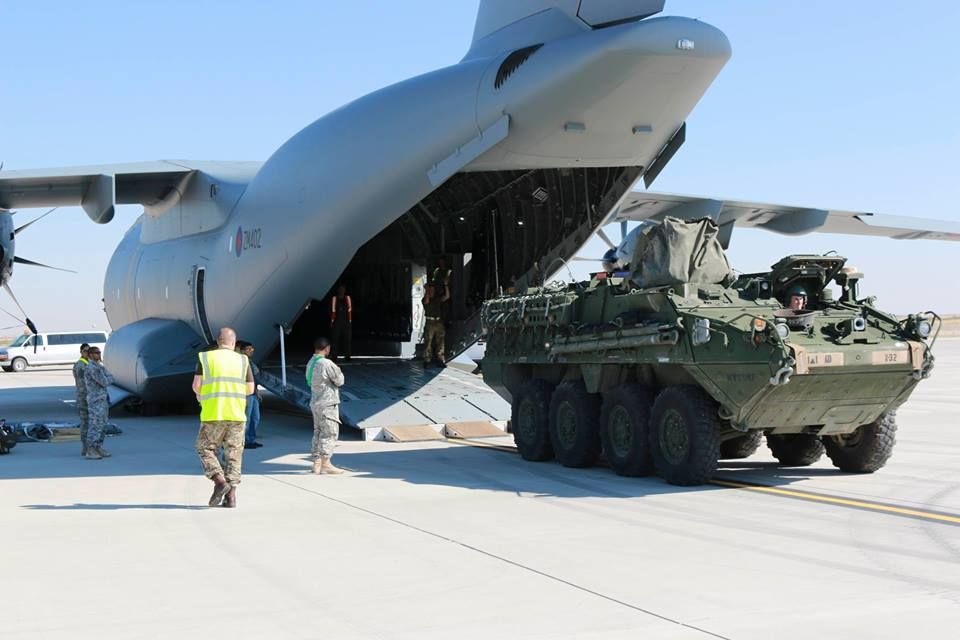
Tuesday-Thursday, 6-8 October 2015
Up to six F/A-18F Super Hornets will be conducting long-range training missions throughout country NSW and country and coastal Victoria between 6 and 8 October.
The country route will extend from Tumut and follow the Snowy Mountains through to Mount Buller. The flying operations will be conducted at low level and may change daily based on the local weather conditions.
Two HC-130J Combat King IIs sit on the flight line in preparation for cargo unload at Diyarbakir Air Base, Turkey, Sept. 28, 2015. The aircraft is deployed to Diyarbakir in an effort to enhance coalition capabilities and support personnel recovery operations in Syria and Iraq. (U.S. Air Force photo/Airman 1st Class Cory W. Bush)
JOINT BASE ELMENDORF-RICHARDSON, Alaska (AFNS) -- F-22 Raptors from the 90th Fighter Squadron duked it out with F-18 Hornets from Navy Strike Fighter Squadron 15 to wrest as much training experience from each other Sept. 14-25.
The Hornets, based in Naval Station Oceana, Virginia Beach, Virginia, flew with Joint Base Elmendorf-Richardson Raptors as part of dissimilar air-combat training, in which fundamentally different airframes train with each other in warzone simulations.
When flying against the Raptors, the Hornets were known as "red air," a term used for pilots simulating enemy aircraft for training purposes, while "blue air" is used for the pilots who are the recipients of the training.
Through this, pilots on both sides were able to gain experience with combat operations against an enemy with different training and a different airframe.
"There are different tactics for different airframes," said Navy Lt. Michael Koch, a VFA-15 pilot. "It is good to work against someone using a different tactic and potentially a different game plan to see where your strengths compare to theirs and your weaknesses to theirs."
With six Hornets and about half their maintainer squadron, the VFA-15 arrived at Elemendorf flying four jets in the morning and four in the evening with Raptors over the course of two weeks, said Air Force Capt. Brendon Boston, a 3rd Operations Support Squadron pilot attached to the 90th Fighter Squadron.
The goal of the training is to provide red air to the 90th FS, so they can get their blue air sorties. But that doesn't mean the visiting Navy pilots also didn?t benefit from the training.
"It's awesome we are up here to get some extra flight time," Koch said. "There's definitely stuff to be learned from seeing someone fight with an aircraft differently than what you're used to seeing."
In addition to providing traditional red air to the 90th FS, the visiting Navy unit assisted in designing different exercises that may not have been previously thought of, and worked together with the Raptors in cooperative exercises.
"In one flight, we had two Raptors and two Hornets; the Hornets were dropping bombs on simulated targets while the Raptors protected us against a red air force composed of two Raptors and two Hornets," Boston said.
Air Force pilots are required to fly a certain number of sorties a month to remain proficient. These sorties are scheduled to meet requirements every month, but sometimes even the best planning can't circumvent circumstance.
"If we go up and it's bad weather, we don't accomplish anything tactical, we can't actually count that as a sortie for our proficiency," Boston said. "That's why we have the aggressor squadron at Eielson, which we use to the maximum extent we can, but occasionally they are flying with (another unit), are tied up in RED FLAG, and sometimes they go on deployment or (temporary duty assignment) so we won't have them available.
"When this happens, we use our own jets for red air, and we can only fly so many of those a fiscal year to count toward that monthly limit," Boston continued. "Pretty much everyone runs out of red air about halfway through the year."
When they begin running low on red air, the squadron reaches out to their fellow aviators in other squadrons and branches. If they can coordinate training with another entity, they can accomplish their mission and earn some unique experience on the way.
While dissimilar air-combat training can be done with Air Force pilots on both sides, training with members of another branch incorporates different mindsets, policies and procedures.
"There are some significant advantages of working with the Navy," Boston said. "Getting exposure to the tiny differences, what their (communication) calls are, and how their procedures work on the ground. Later on, when we do integrate, people are more used to it when it matters."
Exercises like this wouldn't be possible without the cooperation of hundreds of service members, both from the Navy and Air Force. From the maintenance squadrons to the security forces, everyone has a role in getting these pilots in the air.
"We fly some of the oldest operational Hornets in the Navy, so our maintainers work extremely hard keeping our jets up," Koch said. "They're great aircraft, but they just require a little bit more work than our newer brethren; they do the same job any brand new Hornet squadron can do because our maintainer squadron is that good."
The VFA-15 squadron was deployed from February to November 2014, after which they transitioned into a period of readiness, Koch said. This means they are considered the most ready to deploy, and receive the most funding -- but that period ended in May.
"All the funds are sent toward units that are either getting ready to deploy or are currently deployed," Koch said. "Since we are now the furthest unit from deploying, a lot of those funds dry up. So we've got flight hours we can use, but we don't necessarily have a lot of money that can go elsewhere."
Because of this, the 90th FS arranged to pay for their trip so they can get the red air they're looking for and the VFA-15 can use their flight time, showing downrange isn't the only place cooperability is key to mission success.
"You can't put a price on flight time," Koch said.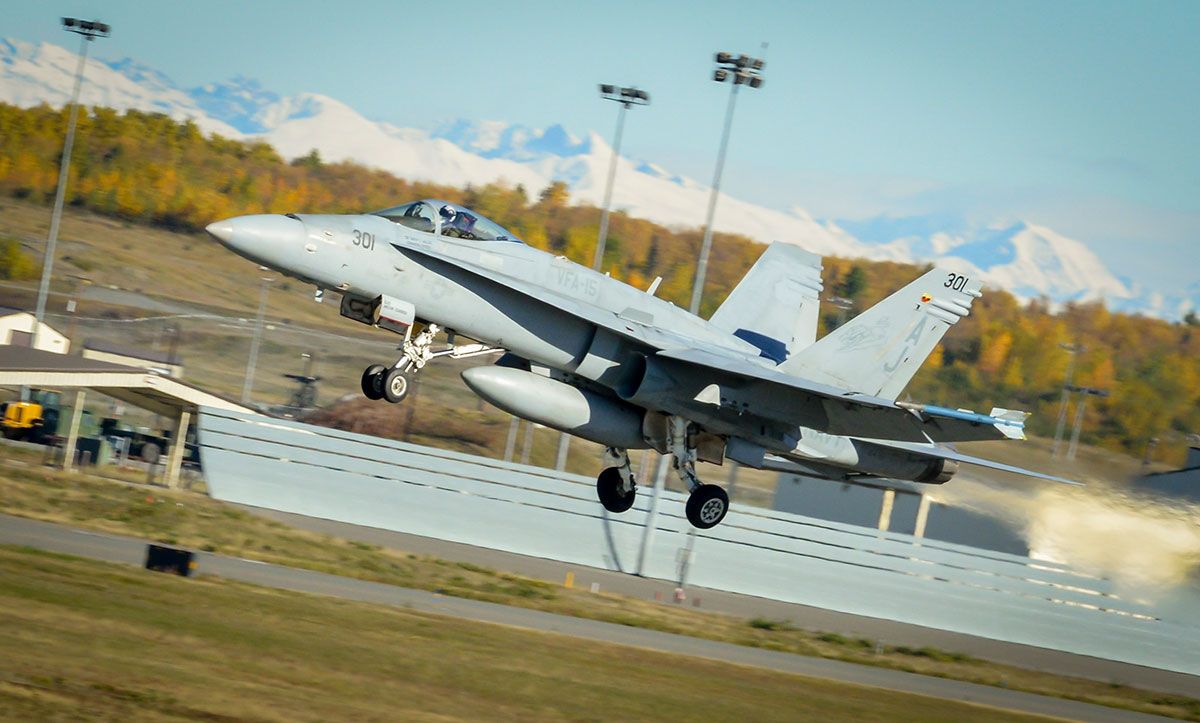
F-35C Sea Trials Aboard USS Eisenhower
Lt. Chris ?TJ? Karapostoles, an F-35 Lightning II test pilot from the F-35 Pax River Integrated Test Force (ITF), is catapulted from the flight deck of USS Dwight D. Eisenhower (CVN 69). Two F-35Cs assigned to the Salty Dogs of Air Test and Evaluation Squadron (VX) 23 are conducting the second phase of F-35 carrier suitability and integration developmental testing (DT-II) at sea. Learn more: bit.ly/1Oe953l (U.S. Navy photo courtesy Lockheed Martin photo by Andy Wolfe)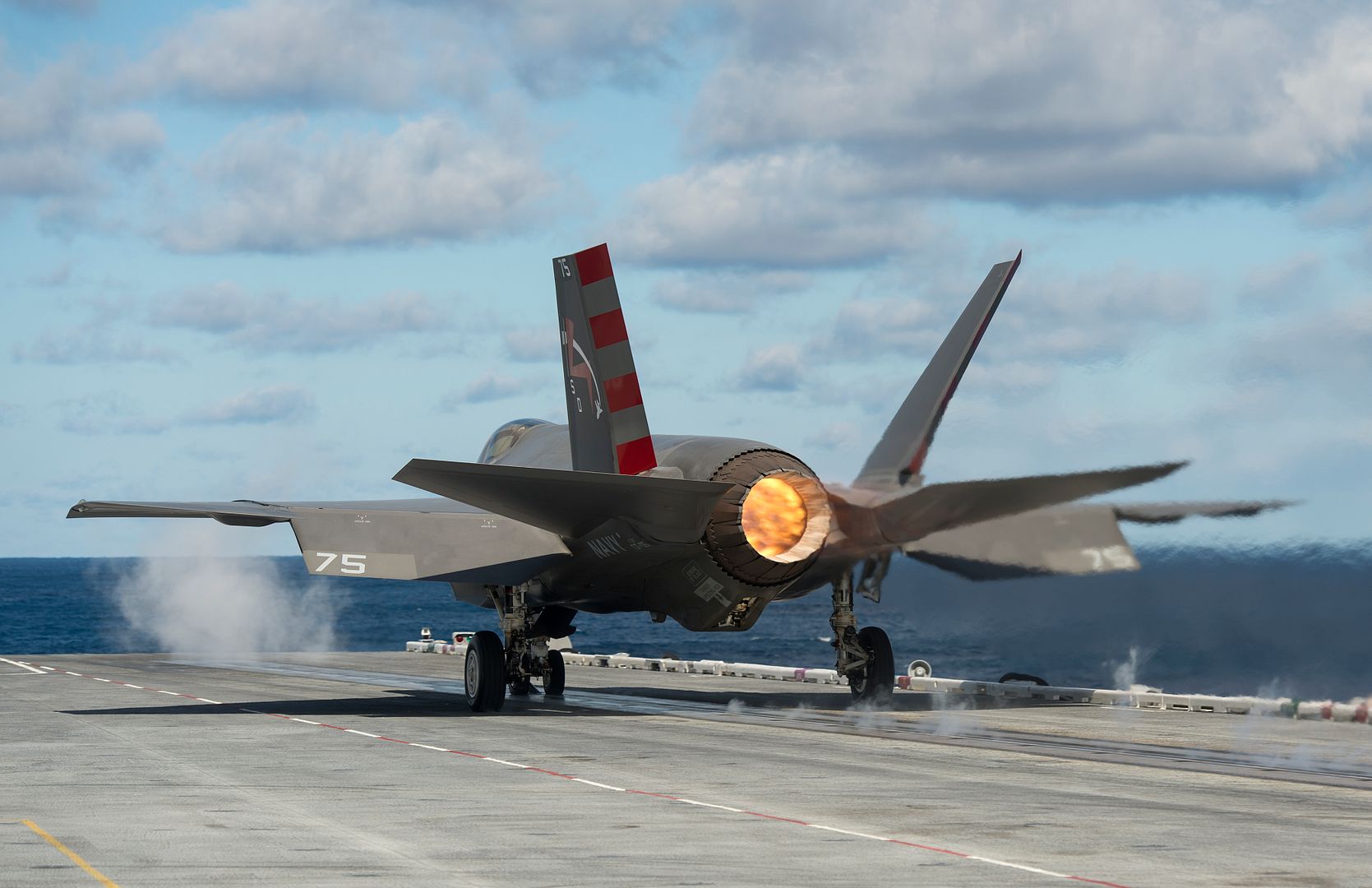
-
10 years agoWed Oct 07 2015, 01:17pm
 Main AdminATLANTIC OCEAN (Oct. 4, 2015) Capt. Stephen T. Koehler, commanding officer of USS Dwight D. Eisenhower (CVN 69), sits in the cockpit of an F-35C Lightning II carrier variant joint strike fighter assigned to the Salty Dogs of Air Test and Evaluation Squadron (VX) 23 in the hangar bay. The F-35C Lightning II Pax River Integrated Test Force is currently conducting follow-on sea trials aboard the Eisenhower. (U.S. Navy photo by Mass Communication Specialist 3rd Class Corey Dill)
Main AdminATLANTIC OCEAN (Oct. 4, 2015) Capt. Stephen T. Koehler, commanding officer of USS Dwight D. Eisenhower (CVN 69), sits in the cockpit of an F-35C Lightning II carrier variant joint strike fighter assigned to the Salty Dogs of Air Test and Evaluation Squadron (VX) 23 in the hangar bay. The F-35C Lightning II Pax River Integrated Test Force is currently conducting follow-on sea trials aboard the Eisenhower. (U.S. Navy photo by Mass Communication Specialist 3rd Class Corey Dill)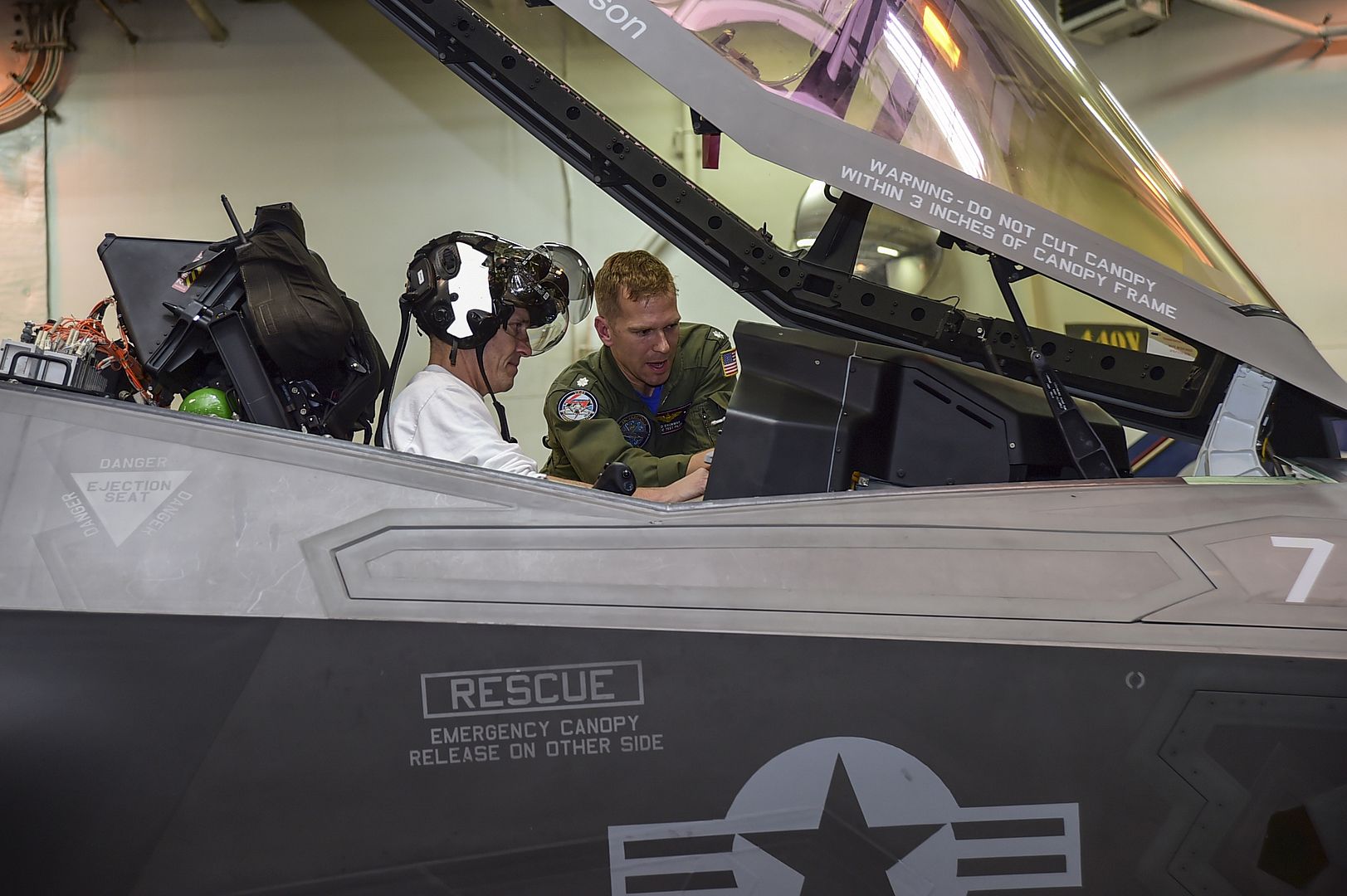
ATLANTIC OCEAN (Oct. 6, 2015) - Sailors transport an F-35C Lightning II carrier variant joint strike fighter assigned to the Salty Dogs of Air Test and Evaluation Squadron (VX) 23 aboard the aircraft carrier USS Dwight D. Eisenhower (CVN 69). The F-35C Lightning II Pax River Integrated Test Force is currently conducting follow-on sea trials aboard the Eisenhower. (U.S. Navy photo by Mass Communication Specialist Seaman Anderson W. Branch)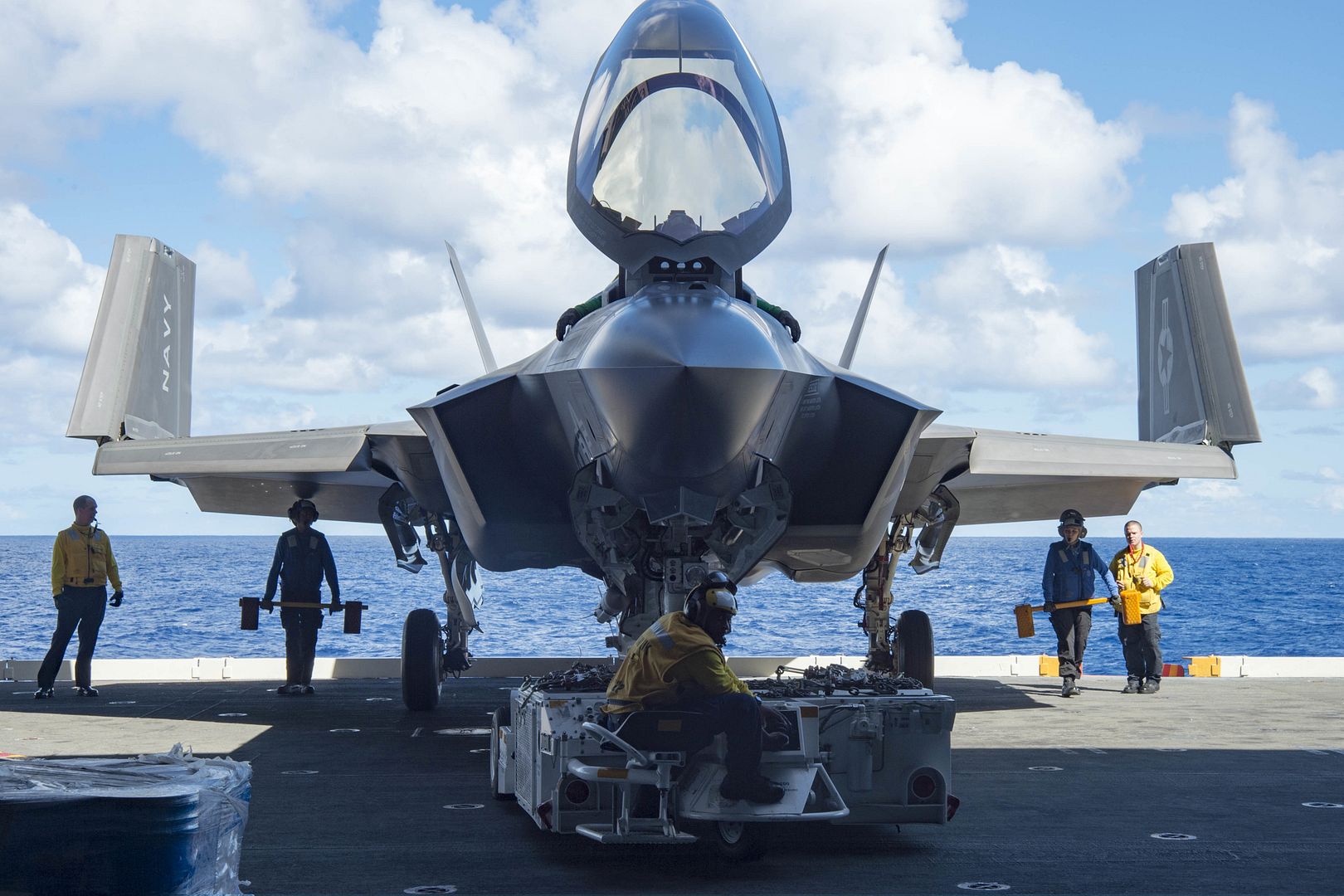
ATLANTIC OCEAN (Oct. 6, 2015) An F-35C Lightning II carrier variant joint strike fighter assigned to the Salty Dogs of Air Test and Evaluation Squadron (VX) 23 prepares for take-off aboard the aircraft carrier USS Dwight D. Eisenhower (CVN 69). The F-35C Lightning II Pax River Integrated Test Force is currently conducting follow-on sea trials aboard the Eisenhower. (U.S. Navy photo by Mass Communication Specialist Seaman Anderson W. Branch)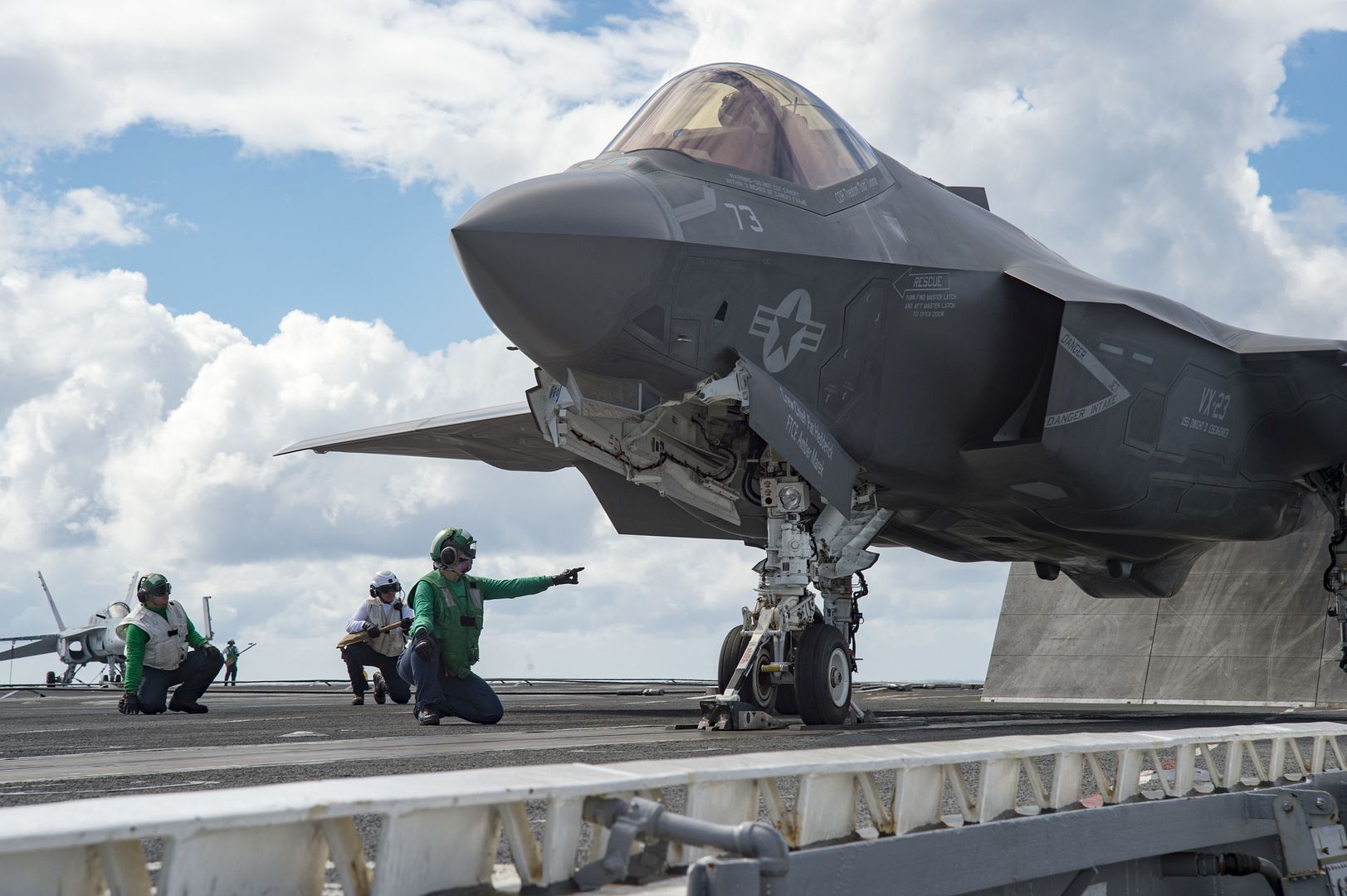
JAKARTA, Indonesia, Oct. 7, 2015 ? Lockheed Martin brought its F-16 cockpit demonstrator to Indonesia this week to highlight the F-16V, the latest version of Lockheed Martin?s venerable F-16 Fighting Falcon multirole fighter. The F-16V offers the most advanced 4th Generation capability available on the market today, including Scalable Agile Beam Radar (SABR) and enhancements to the aircraft?s mission computer, vehicle systems, aircraft structure, cockpit and electronic warfare system.
The F-16V is the next generation configuration that leverages a common worldwide sustainment infrastructure and provides significant capability improvements to the world?s most affordable and effective multi-role fighter. This upgrade and production configuration will be the predominant configuration for the F-16 worldwide fleet. The new avionics configuration represents the most significant F-16 upgrade to date.
With more than 4,500 F-16s delivered, the F-16V is a natural step in the evolution of the world?s most successful 4th Generation fighter. The Fighting Falcon program has continually evolved as it began with the F-16 A/B as the lightweight fighter then transitioned to F-16 C/D and Block 60 versions as customers? requirements evolved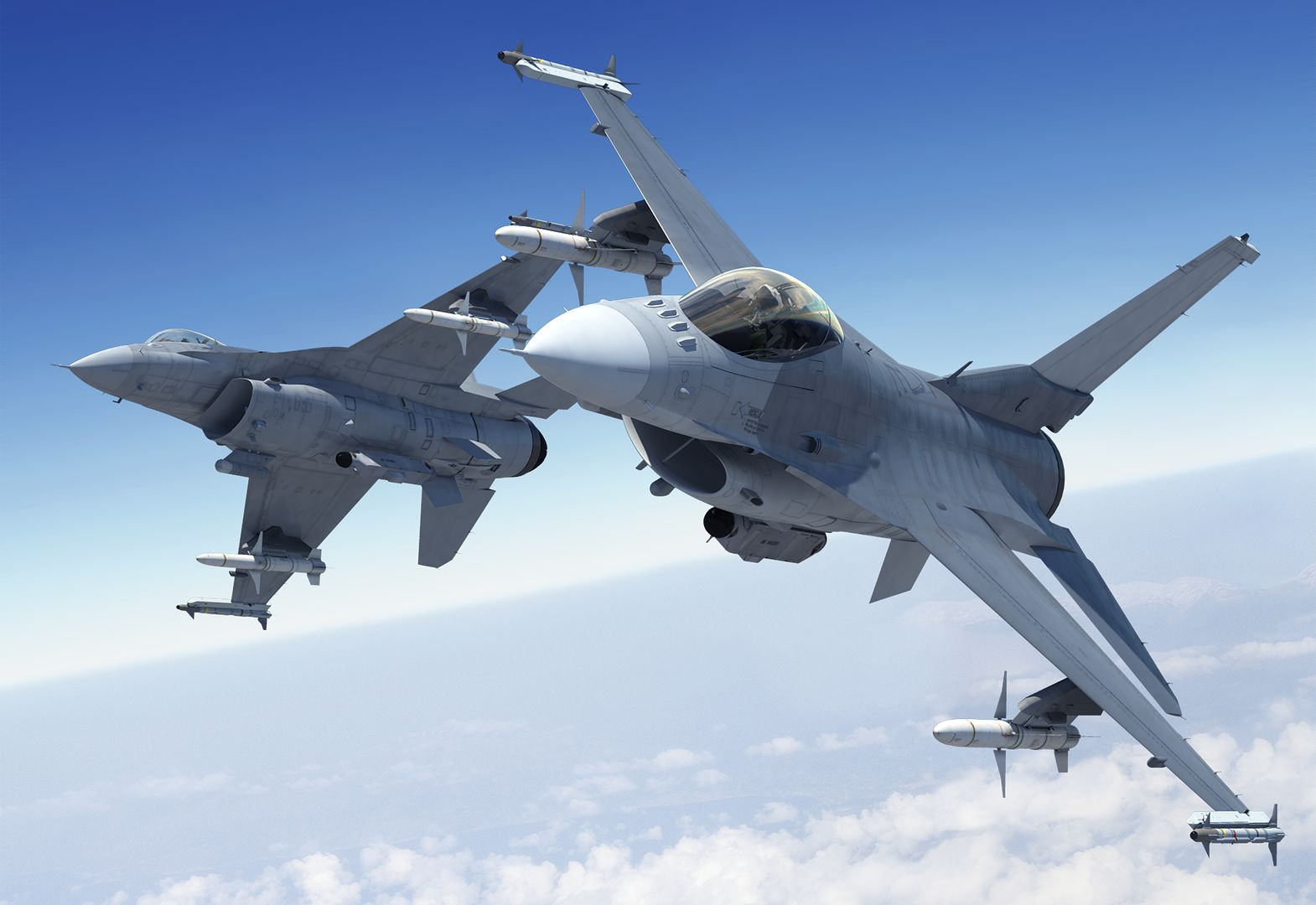
7 October 2015 Press Release
Finnair has taken delivery in Toulouse of the first of 19 A350 XWBs on order, thus becoming the first European operator and the third worldwide of the all-new airliner. The aircraft is configured in a premium three-class layout, with 297 seats, comprising 46 Business Class, 43 Economy Comfort and 208 Economy.
Finnair will commence commercial services with the A350 XWB later this week, with a European tour starting at Amsterdam and Oslo on October 9th. Furthermore, on the 21st of November 2015, non-stop long-haul A350 XWB flights will start from Helsinki to Shanghai. The aircraft will join the airline?s all-Airbus fleet of 45 aircraft in operation, today comprising 30 A320 Family aircraft and 15 A330/A340s.
"Finnair has enjoyed a long and prosperous working relationship with Airbus and the A350 takes our cooperation to another level. This aircraft is the future of flying and will give our passengers a completely new and enhanced travel experience," says Finnair CEO, Pekka Vauramo.
"At Airbus, we're proud and delighted to see Finnair, one of the world?s longest-standing and most respected airlines, become the first European carrier to fly the A350 XWB,? said Fabrice Br?gier, Airbus President and CEO. ?The A350 XWB's unrivalled fuel efficiency and passenger comfort make it the perfect aircraft to spearhead Finnair's Asian expansion.?"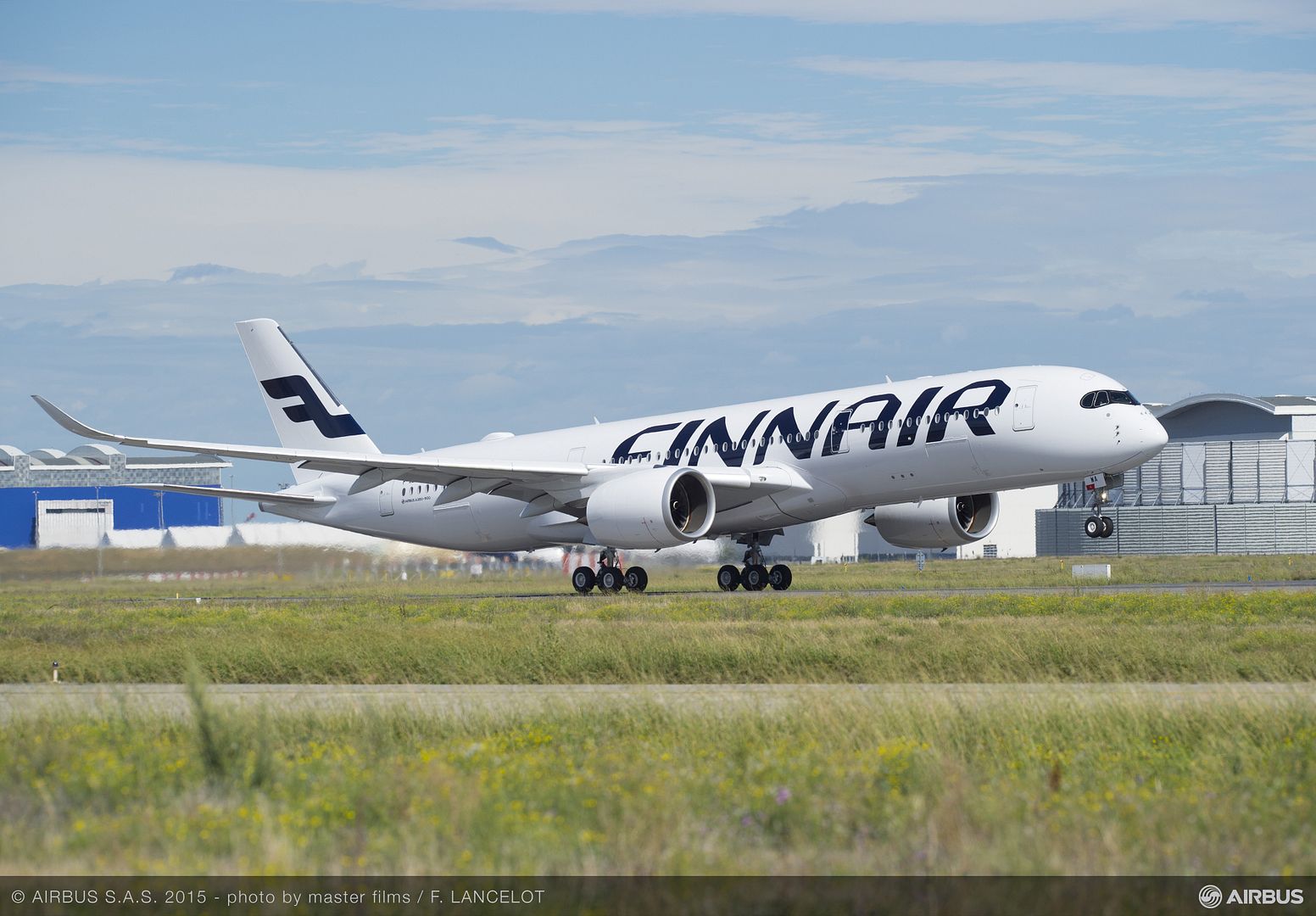
-
10 years ago
 Main AdminA U.S. Marine Corps CH-53E Super Stallion flies over the objective during a Heavy Huey Raid at K-9 Village, Yuma Proving Grounds, Ariz., Oct. 7, 2015. The exercise is part of Weapons and Tactics Instructor (WTI) 1-16, a seven-week training event hosted by Marine Aviation Weapons and Tactics Squadron One (MAWTS-1) cadre. MAWTS-1 provides standardized tactical training and certification of unit instructor qualifications to support Marine Aviation Training and Readiness and assists in developing and employing aviation weapons and tactics. (U.S. Marine Corps photographs by SSgt. Artur Shvartsberg, MAWTS-1 COMCAM/ Released)
Main AdminA U.S. Marine Corps CH-53E Super Stallion flies over the objective during a Heavy Huey Raid at K-9 Village, Yuma Proving Grounds, Ariz., Oct. 7, 2015. The exercise is part of Weapons and Tactics Instructor (WTI) 1-16, a seven-week training event hosted by Marine Aviation Weapons and Tactics Squadron One (MAWTS-1) cadre. MAWTS-1 provides standardized tactical training and certification of unit instructor qualifications to support Marine Aviation Training and Readiness and assists in developing and employing aviation weapons and tactics. (U.S. Marine Corps photographs by SSgt. Artur Shvartsberg, MAWTS-1 COMCAM/ Released)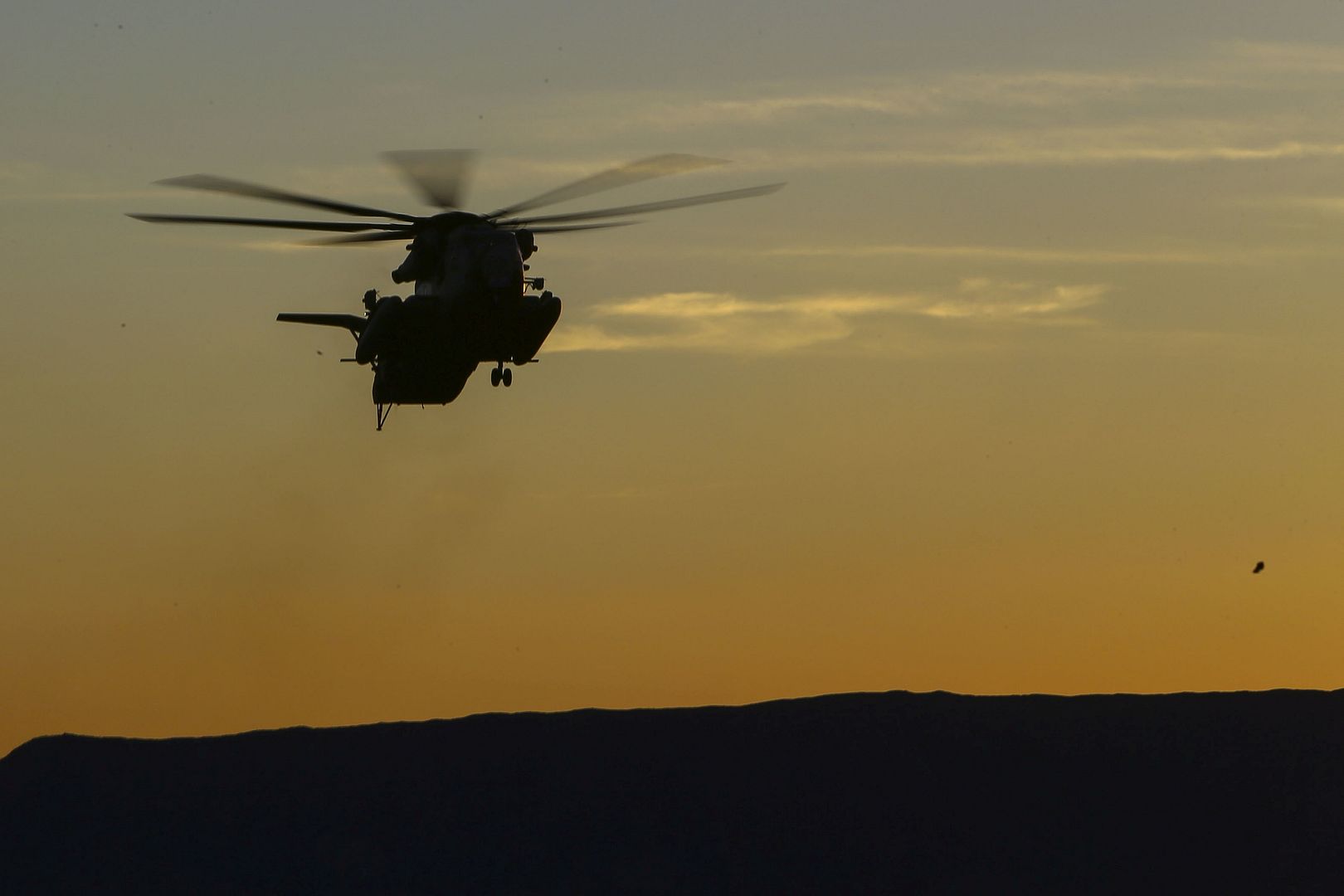
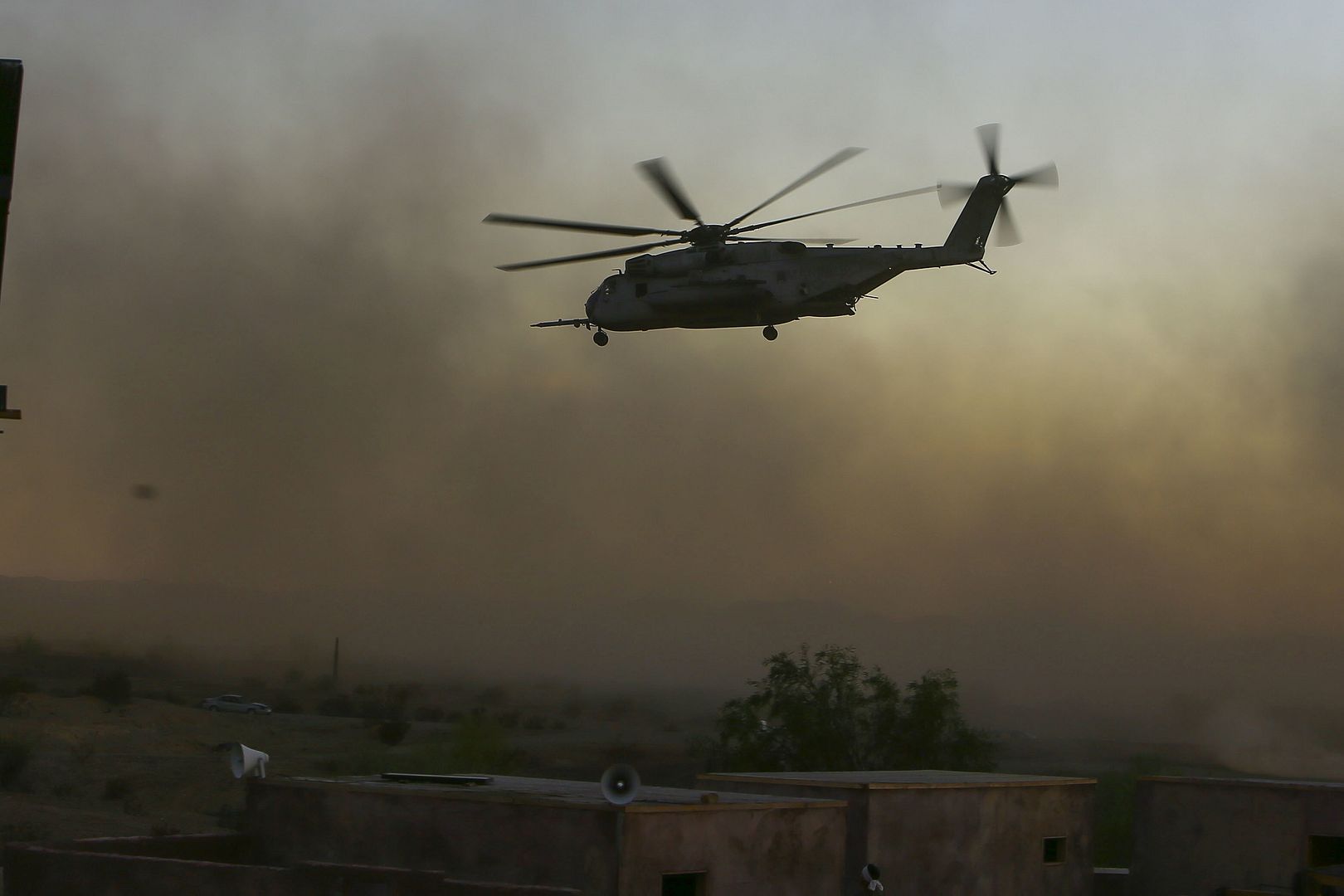
A U.S. Marine Corps UH-1Y Venom flies over the objective during a Heavy Huey Raid at K-9 Village, Yuma Proving Grounds, Ariz., Oct. 7, 2015. The exercise is part of Weapons and Tactics Instructor (WTI) 1-16, a seven-week training event hosted by Marine Aviation Weapons and Tactics Squadron One (MAWTS-1) cadre. MAWTS-1 provides standardized tactical training and certification of unit instructor qualifications to support Marine Aviation Training and Readiness and assists in developing and employing aviation weapons and tactics. (U.S. Marine Corps photograph by SSgt. Artur Shvartsberg, MAWTS-1 COMCAM/ Released)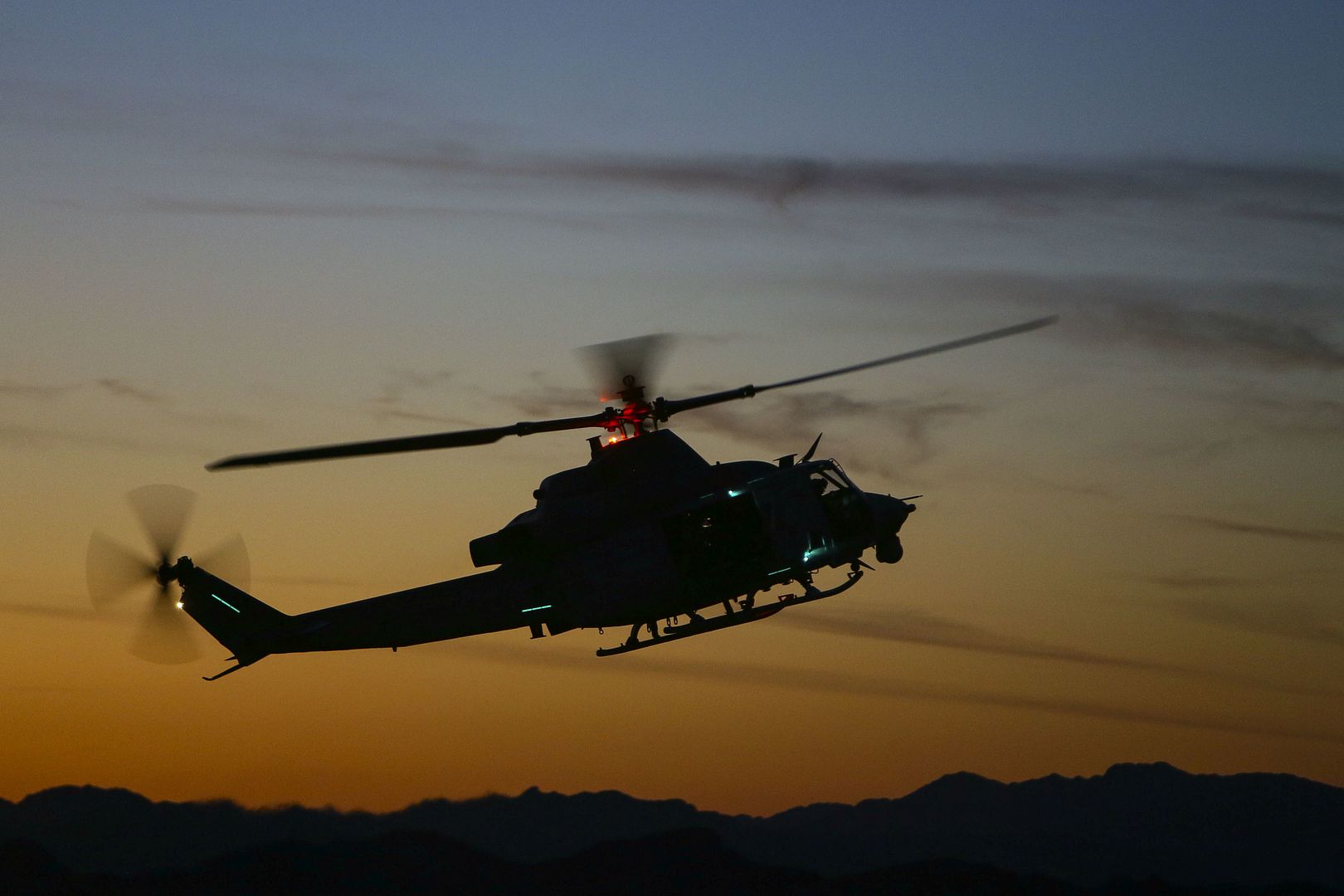
After delivery of its no. 1 aircraft, Finnair will commence A350 XWB commercial services with a European tour starting at Amsterdam and Oslo on October 9.
-
10 years ago
 Main AdminOctober 8
Main AdminOctober 8
Royal Australian Air Force Hawk 127 Lead-In-Fighters are flying back into Tamworth for the second time this year for Exercise Southern Lights 15-2. 76SQN are conducting necessary training at Tamworth which will start on Monday 12 October 15.
Five Hawk 127 aircraft from Number 76 Squadron at RAAF Base Williamtown, near Newcastle, have deployed with approx 40 personnel to conduct Initial Fighter Course (IFC) training and support at Tamworth Airport.
Commanding Officer Number 76 Squadron, WGCDR Ian Goold said, ?conducting the exercise in Tamworth is a great opportunity for the students at this phase of their training.?
?Deploying to Tamworth and being away from home for a few weeks takes away all the distractions of home during this challenging phase of the training, as well as providing an alternate airfield from which to operate which also adds another level of complexity to the training. The pilots will be learning Basic Fighting Maneouvres and Air Combat Manouevres ?aka? dogfighting, during this phase of the training,? he said.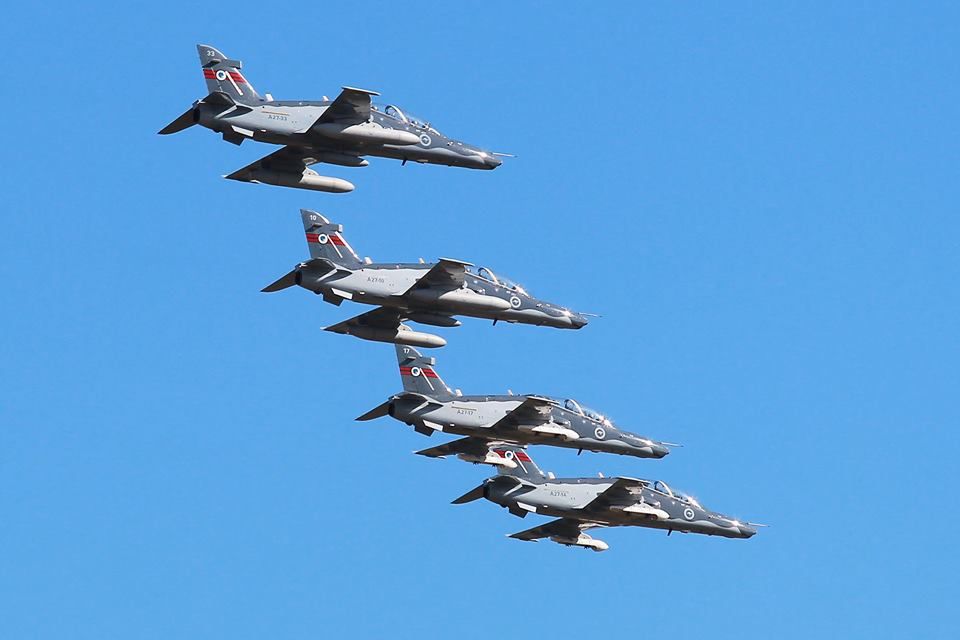
Russia Ministry of Defense; issued Oct 08, 2015
This night Russian aircraft carried out 22 sorties from the Hmeymim airbase. Su-34, Su-24M and Su-25 crews engaged 27 terrorist facilities on the territory of Syria.
The ISIS groups, which showed particular severity towards civilians, were subjected to massive bombing. Su-24M and Su-34 bombers attacked 8 militants? strong points in Homs province.
The engagement resulted in destruction of militants? fortifications. Multiple fires caused by detonation of munitions and fuel, were registered.
Near al-Safsafah, a Russian combat aircraft Su-34 destroyed fire positions of terrorists.
Concrete-piercing air bombs hit the underground facilities of the militants detected earlier by means of space reconnaissance near Arafit and Salma.
Su-25 and Su-34 aircraft made 11 strikes on areas with ISIS training camps in Hamah and Raqqah provinces.
The attacks resulted in the total destruction of the infrastructure used for training of terrorists.
Air reconnaissance held by unmanned aerial vehicles near Hrysin detected a hidden base of the ISIS illegal armed groups.
The strike of a pair of attack aircraft Su-25 completely destroyed constructions and fortifications used by militants as shelters during air attacks. Large fire was registered on the territory of the base.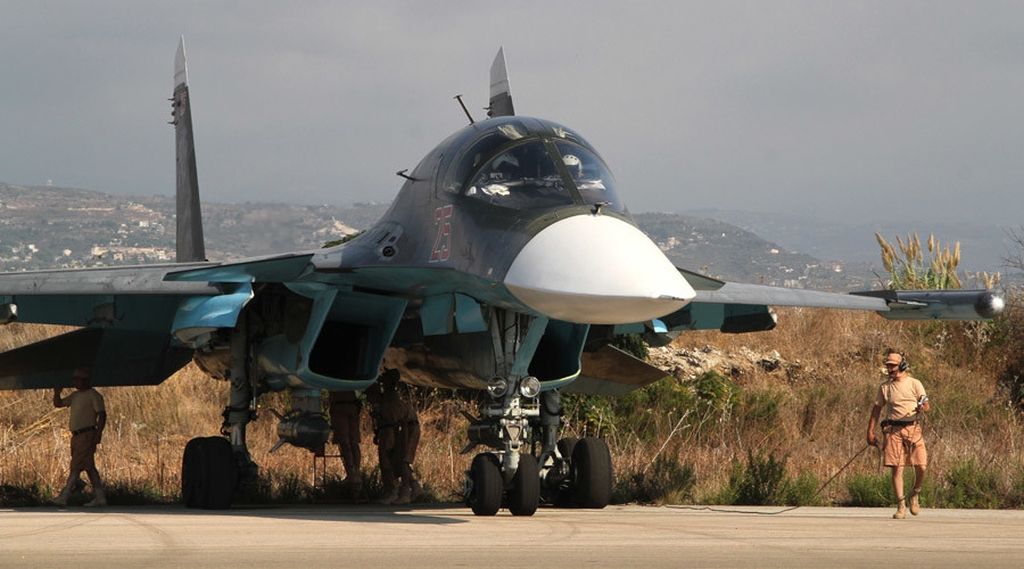
REDONDO BEACH, Calif., Oct. 8, 2015 (GLOBE NEWSWIRE) -- Manufacturing and assembly of the spacecraft structure that will take NASA's James Webb Space Telescope to its ultimate destination 1 million miles from Earth was successfully completed July 1 at Northrop Grumman Corporation's (NYSE:NOC) Redondo Beach facility. Northrop Grumman is working with NASA's Goddard Space Flight Center in Greenbelt, Maryland, and leads the industry team that designs and develops the Webb Telescope's optics, sunshield and spacecraft.
The spacecraft structure, or bus, is made of carbon fiber composites and houses the spacecraft's propulsion, electrical power and communications. The bus must withstand a force equivalent to 45 tons while supporting the observatory during launch.
While in orbit the spacecraft structure will provide pointing and structural stability for the telescope down to one arcsecond. The structure also provides dynamic isolation and attenuation of vibration sources down to two milliarcseconds. This level of image stabilization is equivalent to shining a laser beam from Los Angeles to New York City, with less than 1.5 inches of motion.
The spacecraft structure integrates the system's optical telescope, sunshield, and instrument electronics and mounts the whole observatory to the Ariane 5 rocket ? tasked with launching the Webb Telescope to its destination in space. To launch such a large observatory out to the L2 orbit 1 million miles away, the structure must also be very light-weight so its mass efficiency allows it to carry 64 times its own weight.
"The spacecraft structure provides state of the art capabilities to support the James Webb Space Telescope's first light mission," said Andy Cohen, manager, Webb Telescope spacecraft, Northrop Grumman Aerospace Systems. "Completing the manufacturing and assembly of the spacecraft structure was a significant achievement by many dedicated and diligent people. This milestone represents the committed collaboration between the spacecraft structure's manufacturing, engineering, integration and test teams. It also signifies the continuing progress on the Webb Telescope, and will culminate with the structure test, propulsion integration completion and delivery to spacecraft Integration and Test by July 2016."
The James Webb Space Telescope is the world's next-generation space observatory and successor to the Hubble Space Telescope. The most powerful space telescope ever built, the Webb Telescope will observe the most distant objects in the universe, provide images of the first galaxies formed and see unexplored planets around distant stars. The Webb Telescope is a joint project of NASA, the European Space Agency and the Canadian Space Agency.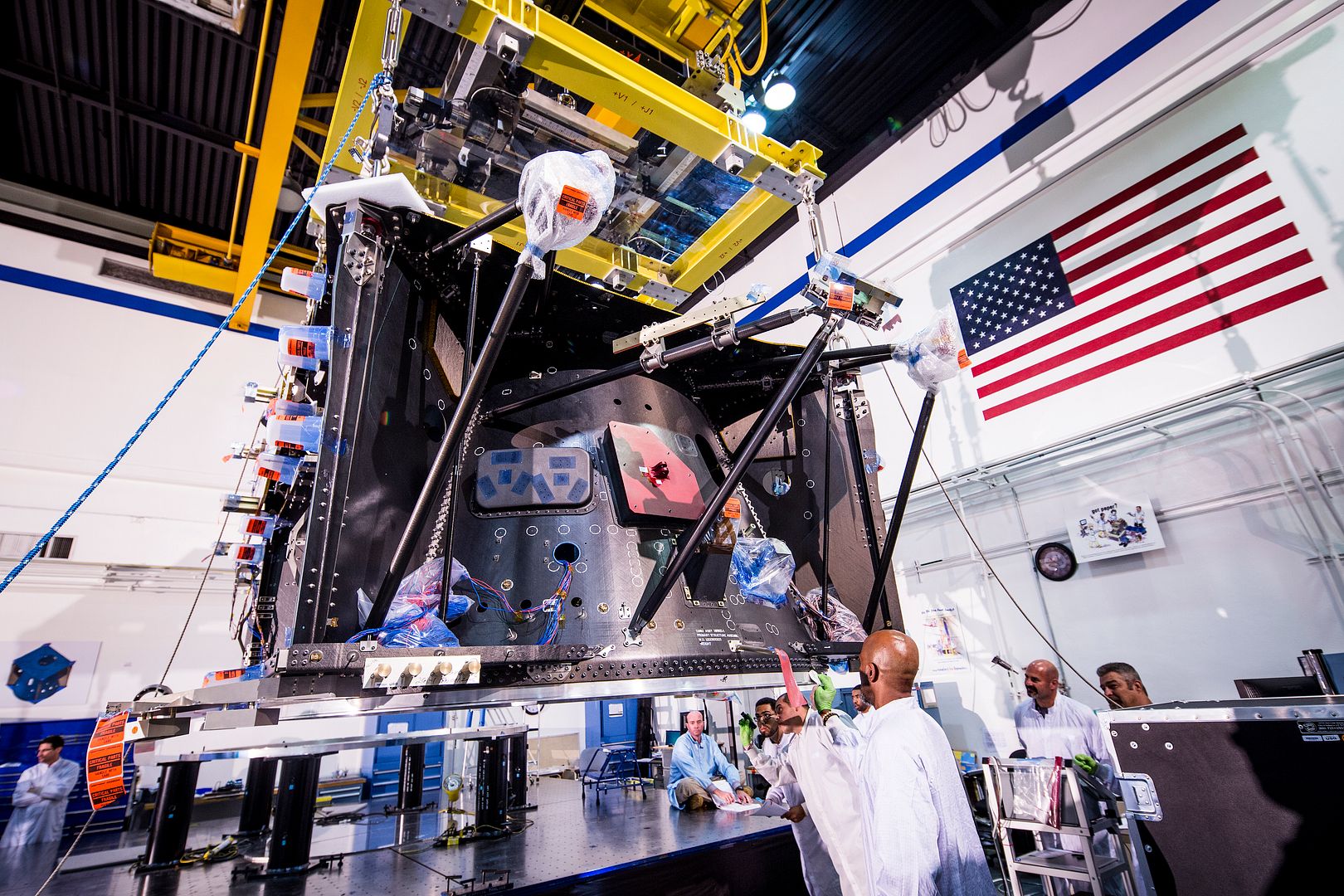
9 October 2015 Press Release
Frontier Airlines, headquartered in Denver, Colorado, USA has taken delivery of the first Airbus A321 to join its fleet. In the last year, the airline has placed firm orders for 19 A321s, reflecting its market strength and the need for the largest Airbus A320 Family member. All 19 A321s are the current engine option (ceo) and will be equipped with Sharklets. Each will seat 230 people in a single class, and be powered by CFM56-5B engines from CFM International. Frontier?s current in-service fleet consists of 57 A320 Family aircraft (35 A319s and 22 A320s). In addition to the remaining 18 A321s on backlog, the airline has 18 A319neo (new engine option), 62 A320neo, and two A320 ceo aircraft on order, for a total backlog of 100 Airbus single-aisles.
All of Frontiers A321s will feature lightweight composite Sharklets, 2.4-meter/94-inch tall wing-tip devices that provide a fuel consumption reduction of up to 4 percent, plus either a range extension of 100 nautical miles or increased payload of up to 450 kilograms/992 pounds.
Frontier?s new A321s will initially be used on their routes from Orlando to Philadelphia, Denver, Cleveland and Detroit. The airline just this fall opened up a new crew base in Orlando to support the A321.
?All of us at Team Frontier are excited to welcome our first A321 into our family of Airbus aircraft,? said Barry Biffle, President ? Frontier Airlines. ?The A321 is the perfect complement to our fleet as we continue to seek areas of growth and offer our customers Low Fares Done Right.?
?Frontier took delivery of its very first Airbus aircraft in 2001, starting its transition to an all-Airbus fleet and its realization of the merit and flexibility of the A320 Family,? said John Leahy, Airbus Chief Operating Officer ? Customers. ?The airline understands the value of continuing to upgrade its fleet with new aircraft and our ever-evolving fuel-saving technologies. In addition to saving money, Frontier is keeping its passengers happy with the most comfortable single-aisle cabin in the sky.?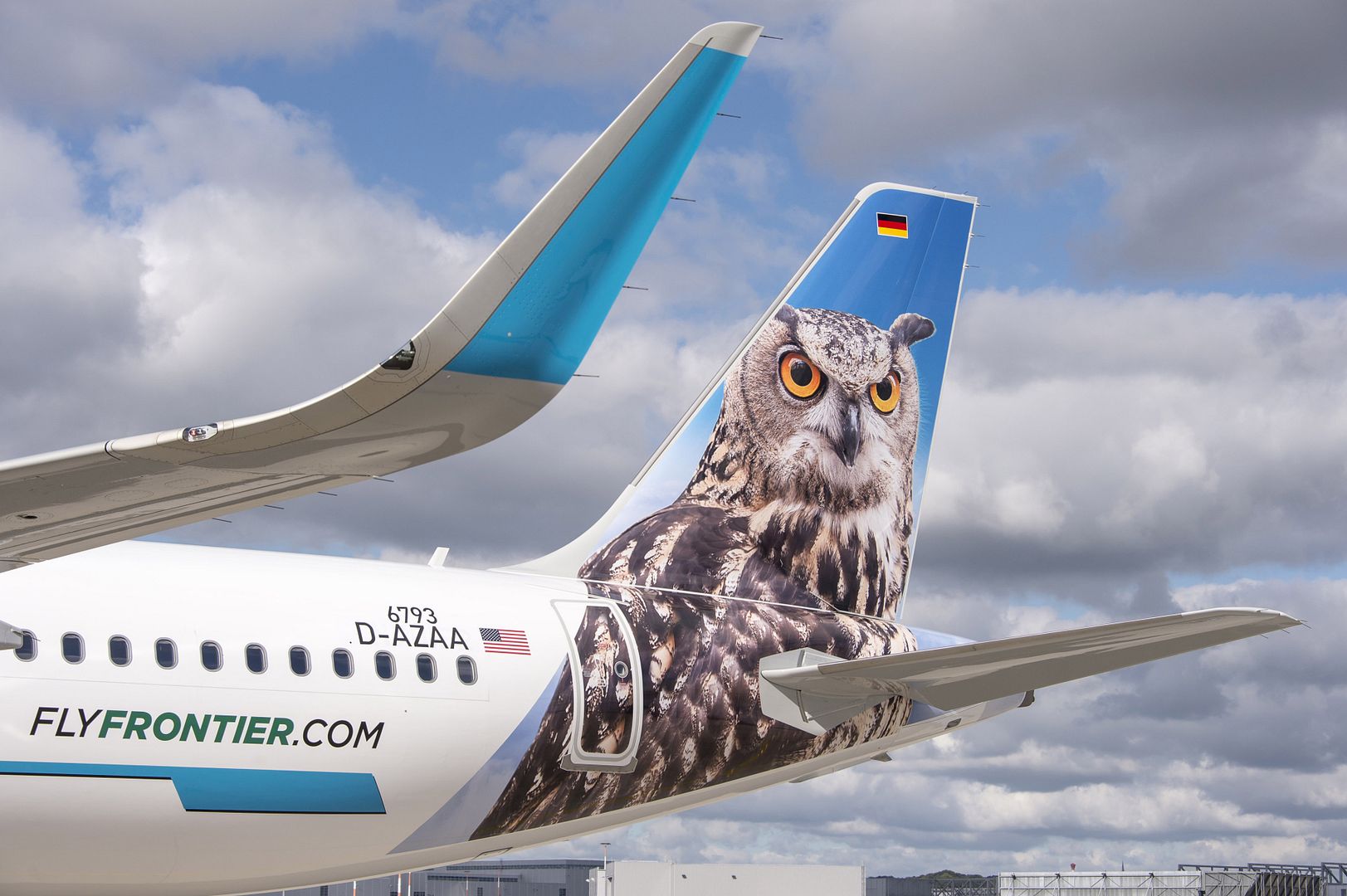
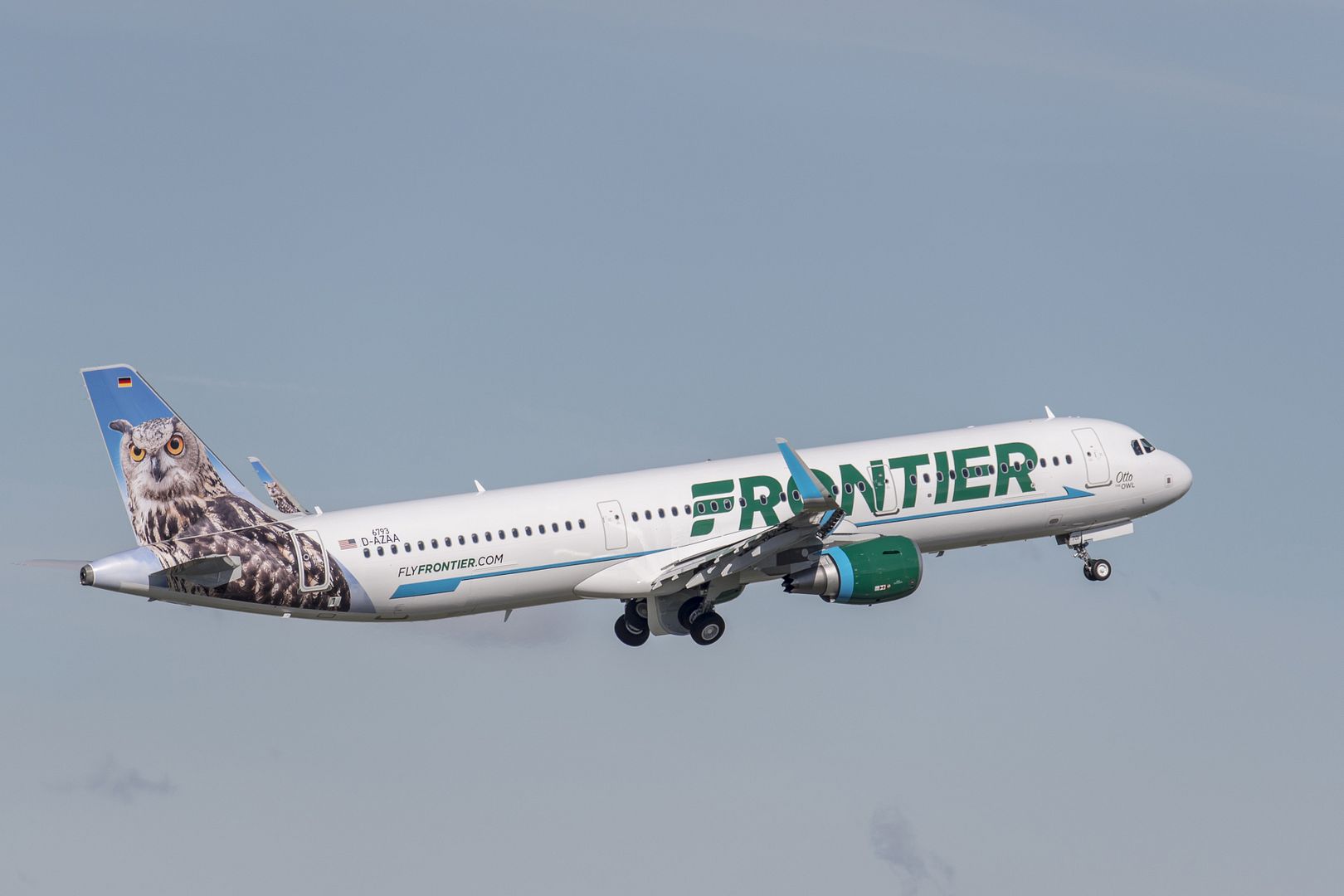
-
10 years ago
 Main AdminWRIGHT-PATTERSON AIR FORCE BASE, Ohio (AFNS) -- The KC-46A Pegasus notched another success this week when the systems at the heart of aerial refueling were demonstrated on EMD-2 with the deployment of both drogue systems and the boom.
Main AdminWRIGHT-PATTERSON AIR FORCE BASE, Ohio (AFNS) -- The KC-46A Pegasus notched another success this week when the systems at the heart of aerial refueling were demonstrated on EMD-2 with the deployment of both drogue systems and the boom.
On Oct. 8, EMD-2 successfully extended the drogue refueling baskets from both the Centerline Drogue System (CDS), located on the belly of the fuselage, and from the wing aerial refueling pods (WARP), located on the wing tips, for probe receiver aircraft. On Oct. 9, EMD-2 extended the boom, the telescoping tube which an operator on the tanker aircraft extends to receptacle-equipped receiver aircraft.
"The core mission of Pegasus is to fuel the fight, so deploying the boom and drogues signals real progress toward demonstrating the ability to pass fuel in flight," said Brig. Gen. Duke Z. Richardson, the program executive officer for tankers at the Air Force Life Cycle Management Center. "This sets the stage for the main act, which is hooking up to and refueling an aircraft in flight."
The rigid, centerline boom used on the KC-135 Stratotanker and KC-10 Extender, has been the Air Force standard for in-flight refueling since the 1950s. With a 1,200 gallons per minute transfer rate from the KC-46, the boom will be the fastest way to refuel. Like all previous tankers, the Pegasus can refuel a single aircraft at a time on the boom.
On the other hand, Air Force helicopters and all Navy and Marine Corps aircraft use the hose and drogue method of refueling. The two drogue systems on the KC-46, CDS and WARPs, pass fuel at a rate of 400 gpm, and the WARPs can refuel more than one aircraft at a time. The KC-46A is a leap forward, as it can conduct boom and drogue refueling on a single mission without landing to reconfigure.
"These capability gains are vital to the tanker mission in support of global reach and global power providing the U.S. military the ability to extend the range of aircraft to respond wherever it's called to duty,? said Col. Christopher Coombs, the KC-46 system program manager. ?This tanker will be able to refuel any fixed-wing aircraft or helicopter in the (Defense Department) fleet, while being able to take on fuel itself,"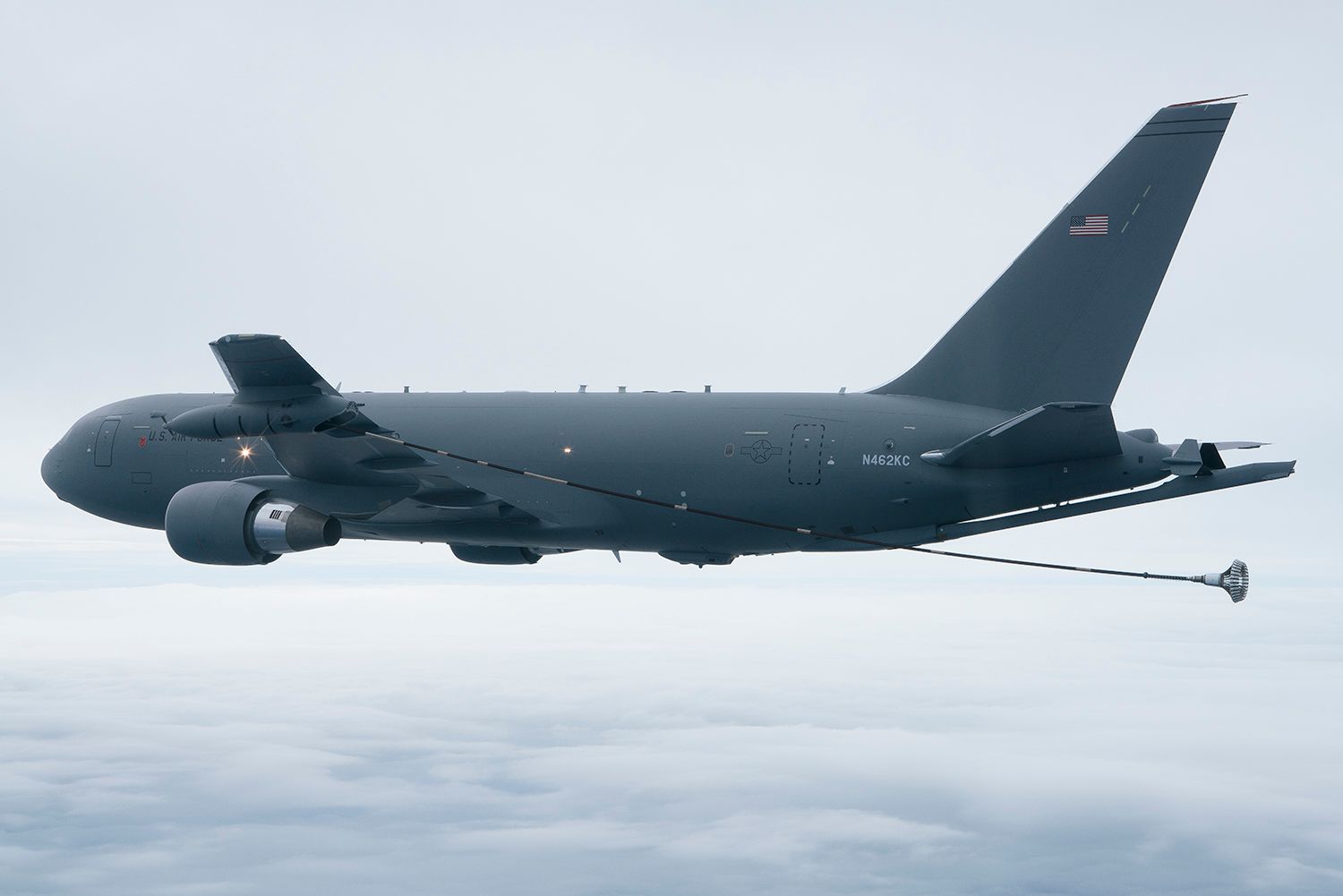
The KC-46A Pegasus deploys the centerline boom for the first time Oct. 9, 2015. The boom is the fastest way to refuel aircraft at 1,200 gallons per minute. (Boeing photo/John D. Parker)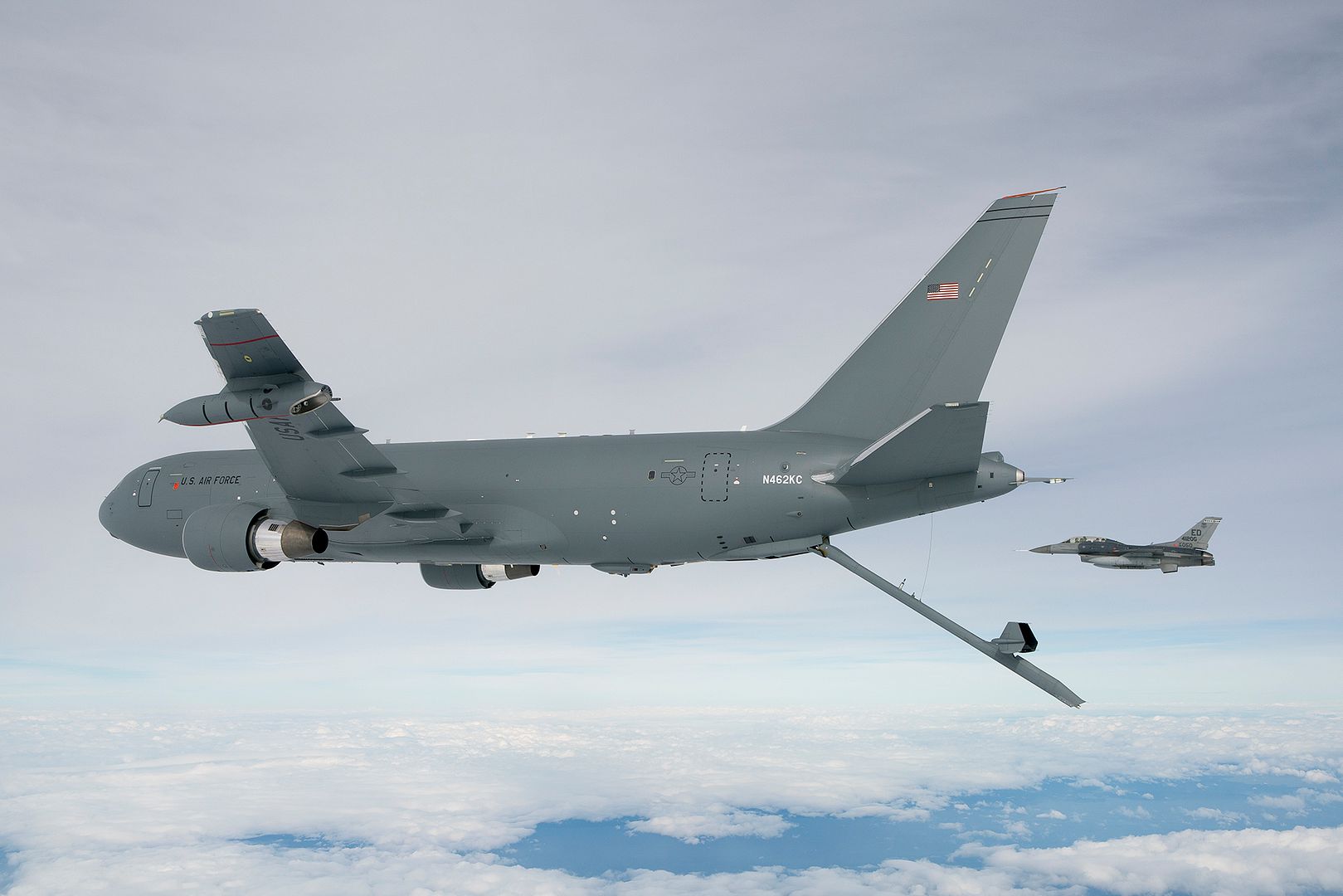
EVERETT, Wash., Oct. 11, 2015 /PRNewswire/ -- Boeing [NYSE: BA] and Oman Air celebrated the delivery of the airline's first Boeing 787 Dreamliner. The airline ordered six 787-8s in November 2011 as part of its expansion plans.
"We are delighted to receive our first Dreamliner which combined with Oman Air's award-winning service will provide an excellent travel experience for our customers," said Paul Gregorowitsch, Chief Executive Officer, Oman Air. "Our decision to invest in this game-changing airplane underlines our confidence in the 787 and the value it will add in terms of reliability, operational efficiency and comfort."
The Boeing 787 Dreamliner is an all-new, super-efficient family of commercial airplanes that brings big-jet ranges and speed to the middle of the market. In response to airlines' overwhelming preference, Boeing designed the 787 family with superior efficiency, which allows airlines to profitably open new routes to fly people directly where they'd like to go in exceptional comfort. Since entering service in 2011, the 787 family has opened more than 50 new non-stop routes around the world. Oman Air has announced that it will deploy its first Dreamliner on services to Saudi Arabia and Europe.
"We're proud to have Oman Air join our growing base of 787 customers in the Middle East and around the world," said Boeing Commercial Airplanes President and CEO Ray Conner. "Our partnership with Oman Air dates back almost 15 years during which time the airline has been operating the 737 family. We're delighted to help introduce Boeing twin-aisle airplanes into its growing fleet."
Boeing currently has eight 787 customers in the Middle East with a total of 175 Dreamliners ordered and 140 in backlog. Boeing has also been contracted by Oman Air for a suite of services to support the upcoming entry into service of its 787 Dreamliners and to ensure ongoing efficiency and cost savings for its fleet. These services will help Oman Air minimize the time and cost of maintenance while increasing airplane availability.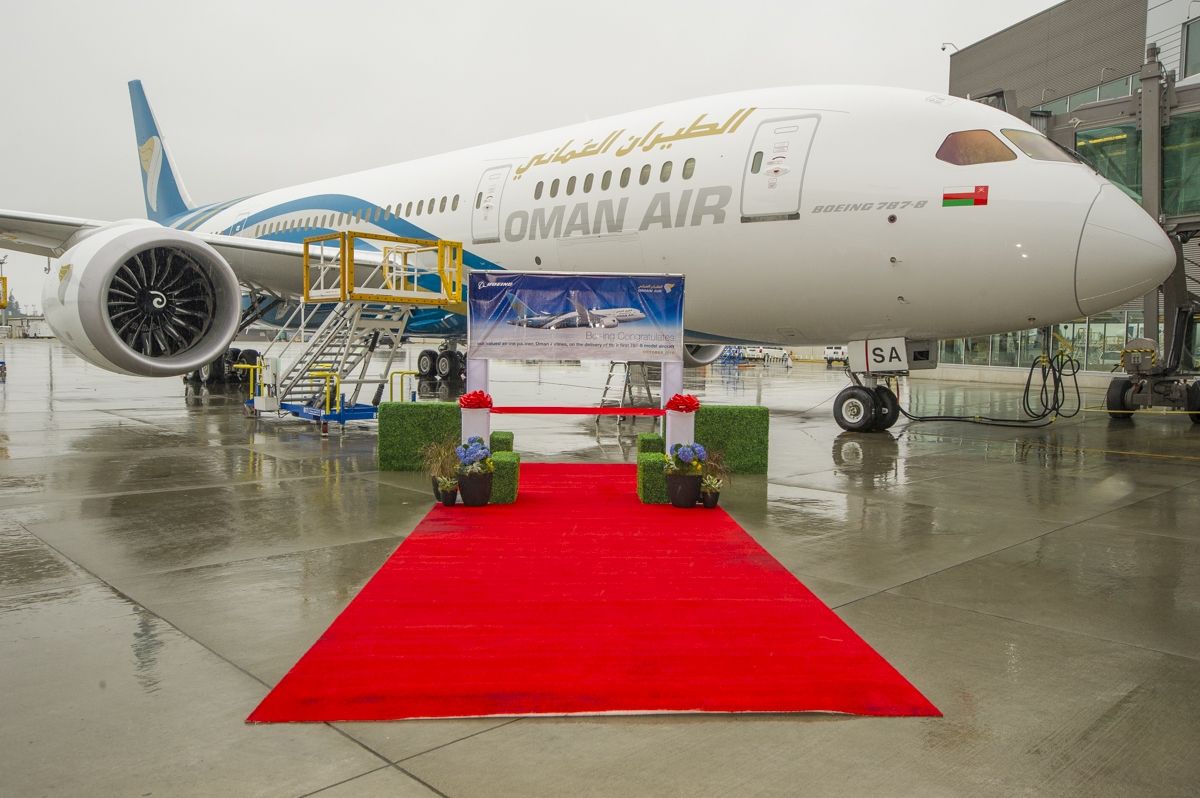
13 October 2015 Press Release
Airbus launches new Ultra-Long Range version of the A350-900
Singapore Airlines (SIA) has selected Airbus? newly launched Ultra-Long Range version of the A350-900 for non-stop flights to the US. Under an amendment to the carrier?s existing order for 63 A350-900s, seven of the aircraft will now be delivered with an Ultra-Long Range capability for flights of up to 19 hours. In addition, the carrier has placed an additional order for four A350-900s, taking its total firm orders for the A350 XWB Family to 67.
Optimised for non-stop flights to the US, the aircraft, designated A350-900ULR (Ultra-Long Range), will ?include a modified fuel system to increase the fuel carrying capacity, an increase in Maximum Take-Off Weight, plus aerodynamic improvements, enabling service to the US West Coast, as well as to New York.
Representing a distance of some 8,700 nautical miles, the New York service will be the world?s longest commercial passenger route, with an expected flight time of up to 19 hours. Moreover, the unique flexibility offered by the A350 XWB allows operators to reconfigure their A350-900ULR to the standard long-haul A350-900 specification should they require it.
?Our customers have been asking us to re-start non-stop Singapore-US flights and we are pleased that Airbus was able to offer the right aircraft to do so in a commercially viable manner,? said Singapore Airlines CEO Goh Choon Phong. ?This is another example of how we strive to meet and exceed our customers? expectations by remaining at the forefront of product and service innovation in our industry. It will also further strengthen the Singapore hub by providing the fastest and most convenient air connectivity between North America and Southeast Asia.?
?We are excited to be working with Singapore Airlines to re-launch its premium non-stop service to the US,? said Fabrice Br?gier, Airbus President & CEO. ?The A350 is the perfect, flexible platform for such operations, offering unrivalled operating economics for the very longest routes. And the wider and quieter cabin will provide the perfect environment for passengers to enjoy the world-famous Singapore Airlines in-flight product.?
The all-new A350 XWB entered commercial service earlier this year and features the latest aerodynamic design, carbon fibre fuselage and wings, plus fuel-efficient Rolls-Royce Trent XWB engines. Together, these latest technologies translate into unrivalled levels of operational efficiency, with a 25 per cent reduction in fuel burn and emissions, and significantly lower maintenance costs.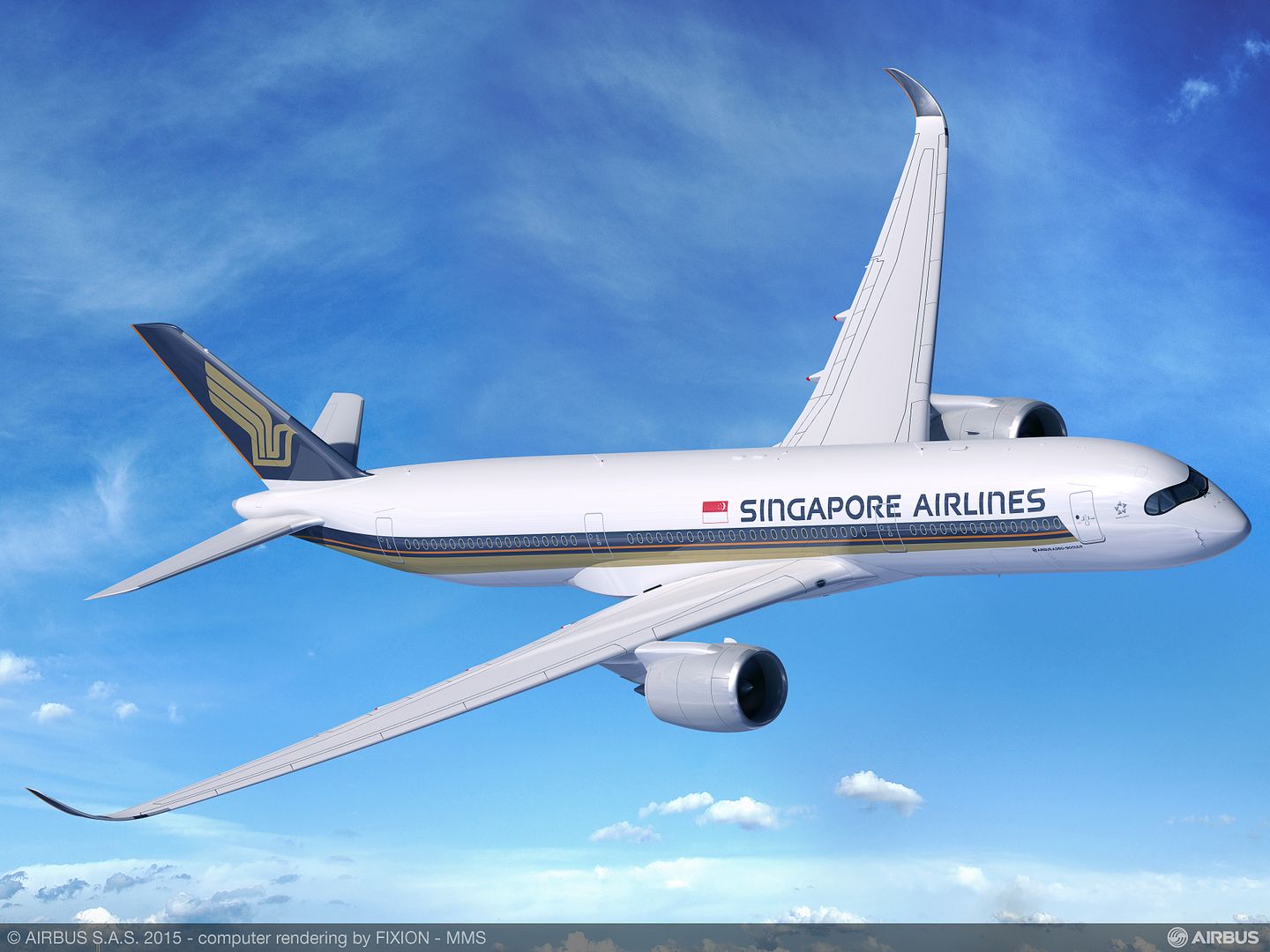
Post a reply
- Go to Previous topic
- Go to Next topic
- Go to Welcome
- Go to Introduce Yourself
- Go to General Discussion
- Go to Screenshots, Images and Videos
- Go to Off topic
- Go to Works in Progress
- Go to Skinning Tips / Tutorials
- Go to Skin Requests
- Go to IJAAF Library
- Go to Luftwaffe Library
- Go to RAF Library
- Go to USAAF / USN Library
- Go to Misc Library
- Go to The Ops Room
- Go to Made in Germany
- Go to Campaigns and Missions
- Go to Works in Progress
- Go to Juri's Air-Raid Shelter
- Go to Campaigns and Missions
- Go to Works in Progress
- Go to Skinpacks
- Go to External Projects Discussion
- Go to Books & Resources
